This is a past issue of the State of Trade. For the latest report, please visit Canada’s State of Trade reports.
State of Trade 2021 - A closer look at Foreign Direct Investment (FDI)
ISSN 2562-8321
Table of contents
- Message from Minister Ng
- Acronyms
- Executive Summary
- Chapter 1: 2020 in review
- Chapter 2: FDI as a driver of domestic growth
- Chapter 3: Why do companies invest abroad?
- Chapter 4: Attracting FDI— showcasing Canada's strengths
- Bibliography
- Data sources
Message from Minister Ng
This report captures the story of the incredible sacrifices made and resilience demonstrated by Canadians and businesses through an unparalleled chapter in our country's history, and charts a path forward as we step into our recovery from the COVID-19.
With the unprecedented restrictions and challenges of this pandemic, there is no doubt that 2020 was a difficult year for all Canadians—from workers and businesses to families and economy.
Waves of COVID-19, public health measures, and restricted travel around the world, brought economic challenges. Canadians stepped up to the challenges, working together to address this crisis with compassion and kindness.
Our government's COVID-19 Economic Response Plan represented the most significant investments to support Canadians from the Government of Canada since the second world war. It was instrumental in protecting millions of jobs, ensuring families didn't have to make impossible choices between paying their bills and putting food on the table, and supporting businesses to keep their lights on, cover costs, and keep employees on their payroll.
We have been focused on ensuring we addressed the significant social and economic impacts of the pandemic since day one – moving quickly to introduce crucial emergency business supports and working internationally to accelerate the production and equitable distribution of critical medical supplies, such as personal protective equipment and ventilators, and vaccines to protect Canadians and people around the world.
In addition to crucial emergency support programs, we have used every tool in our toolbox to bridge businesses through the pandemic and into recovery.
Whether it's been through virtual trade missions around the world or our fifteen free trade agreements giving businesses access to 1.5 billion customers around the world -- we haven't let COVID-19 stop us from trading. We have continued to create opportunities for businesses to trade—opportunities which will be crucial to growth and jobs and we work to recover as quickly as possible.
Canada's State of Trade makes two things clear: Canadians and businesses made significant sacrifices during COVID-19, and in our recovery, trade and investment will be critical to generating inclusive, sustainable growth, creating jobs, and building a stronger, more resilient future.
That is why in Budget 2021 we are investing in making historic, necessary investments of over $100 billion over three years for our economic recovery. Now is the time to restore business confidence, create jobs, ensure sustainable and inclusive growth that benefits all Canadians including women, Indigenous and racialized entrepreneurs, and keeps our global supply chains open and resilient.
With our strong, stable and resilient economy; welcoming business environment, high standards for labour, the environment, and inclusivity; and skilled, diverse and well-educated workforce; Canada is set up for success as we recover from the COVID-19 pandemic.
Moving forward, we will continue to work with our partners around the world to forge a path to a clear, strong, and equitable economic recovery. The best way for us to achieve this is by finishing this fight against COVID-19 and facing any challenges that may lay ahead of us, together, as one Team Canada.
Our commitment in giving Canadian businesses the stability they need to thrive and grow around the world is unwavering. It's time to build back better, and together we will succeed.
- The Honourable Mary Ng, Minister of Small Business, Export Promotion and International Trade
Acronyms
- $B
- Billion dollars
- $M
- Million dollars
- AAFC
- Agriculture and Agri-Food Canada
- AI
- Artificial intelligence
- BDC
- Business Development Bank of Canada
- Can$
- Canadian dollar
- CCCA
- Consider Canada City Alliance
- CDIA
- Canadian direct investment abroad
- CETA
- Canada-European Union Comprehensive Economic and Trade Agreement
- CGE
- Computable General Equilibrium model
- CMA
- Canadian mining assets
- CMNE
- Canadian multinational enterprise
- CN
- Canadian National Railway
- CKFTA
- Canada-Korea Free Trade Agreement
- CPTPP
- Comprehensive and Progressive Agreement for Trans-Pacific Partnership
- CUSMA
- Canada-United States-Mexico Agreement
- EDC
- Export Development Canada
- EU
- European Union
- EV
- Electric vehicle
- FDI
- Foreign direct investment
- FTA
- Free trade agreement
- FMNE
- Foreign multinational enterprise
- GAC
- Global Affairs Canada
- GDP
- Gross domestic product
- GFC
- Global Financial Crisis
- HS
- Harmonized System
- ICA
- Investment Canada Act
- ICT
- Information and communication technologies
- IIC
- Immediate investing country
- IMF
- International Monetary Fund
- IPA
- Investment promotion agencies
- ISED
- Innovation, Science and Economic Development Canada
- KPI
- Key performance indicator
- LNG
- Liquefied natural gas
- M&A
- Mergers and acquisitions
- M&E
- Machinery and equipment
- MNE
- Multinational enterprise
- NAFTA
- North American Free Trade Agreement
- NAICS
- North American Industry Classification System
- NRCan
- Natural Resources Canada
- OCE
- Office of the Chief Economist, Global Affairs Canada
- OECD
- Organisation for Economic Co-operation and Development
- OE
- Oxford Economics
- OLI
- Ownership, location, and internalization
- pp
- Percentage point
- PPE
- Personal protective equipment
- R&D
- Research and development
- SAAR
- Seasonally adjusted annual rate
- SIBS
- Survey of Innovation and Business Strategy
- SIF
- Strategic Innovation Fund
- SME
- Small and medium-sized enterprise
- SPE
- Special purpose entity
- SR&ED
- Scientific Research and Experimental Development
- STEM
- Science, technology, engineering, and mathematics
- TCS
- Trade Commissioner Service
- UHC
- Ultimate host country
- UIC
- Ultimate investor country
- U.K.
- United Kingdom
- UNCTAD
- United Nations Conference on Trade and Development
- U.S.
- United States (used adjectivally)
- US$
- United States dollar
- VTM
- Virtual trade mission
- WEO
- World Economic Outlook
- WTO
- World Trade Organization
Executive summary
The year 2020 was one of the most tumultuous in modern history with the COVID-19 pandemic wreaking havoc worldwide, impacting every area of people's lives. Following 2019, a year marked by the slowest annual growth in world GDP since the 2008-2009 global financial crisis (GFC), 2020 began with an already elevated level of uncertainty due to trade disputes, geopolitical tensions, and social unrest. Not long into the year, a rapidly spreading viral disease had taken centre stage. By mid-March, this initially localized health crisis had been declared a pandemic, on its way to becoming one of the greatest global disasters in our lifetime.
The Canadian economy was hit hard, experiencing its largest quarterly declines since comparable data were available, contracting by 7.9% (annualized) in the first quarter of 2020 and another 38% in Q2 (annualized). As the first wave of the pandemic passed and restrictions were relaxed, a rapid recovery followed—the economy expanded by 42% in the third quarter (annualized), the fastest quarterly expansion on record. The rebound in Canada's economic activities slowed down to 9.3% (annualized) in the fourth quarter, as rising cases led to a second wave of lockdowns in affected regions.
The strong recovery in the second half of 2020 was not enough to offset the loss in the first half though, with many services-producing industries continuing to struggle by the end of the year. Overall, Canada's gross domestic product (GDP) contracted by 5.3% in 2020, its largest annual contraction on record. The pandemic also had a profound impact on the labour market. For the full year, Canadian employment declined by 5.2% or nearly 1 million jobs, leading to Canada's annual unemployment rate rising to 9.5%.
Year-over-year, Canada's total trade in goods and services fell by 13% to $1.3 trillion in value the second-fastest 1-year decline on record, after the 17% contraction following the GFC, from 2008 to 2009. Both exports and imports recorded double-digit declines, down 13% and 12%, respectively. This was mainly due to lower bilateral trade with the United States. Canada's trade-to-GDP ratio dropped from 65% in 2019 to 60% in 2020—also the lowest since 2009.
In 2020, overall Canadian trade in goods contracted by 10%. Goods exports were more affected, falling by 12% to $524 billion in value, compared to imports, which shrank 8.5% to $561 billion. The impact on services industries was especially dire, particularly on those that depend on face-to-face interactions, like the tourism and hospitality industries. For the full year, Canadian services trade fell by over a fifth in value to $237 billion, with services exports declining by 18% and services imports falling by 24%.
Canada's foreign investment performance was also severely impacted by the COVID-19 pandemic, with both flows of inward foreign direct investment (FDI) and Canadian direct investment abroad (CDIA) registering large declines. For 2020 overall, Canadian FDI flows plummeted by 49% or $31 billion, and CDIA contracted 41% or $42 billion. While FDI flows are typically more volatile than trade or other economic measures, the magnitude of this 1-year decline is surpassed only by the 60% and 46% plunges in FDI and CDIA flows, respectively, in 2008-2009 due to the GFC. The decline in Canada's performance in attracting foreign direct investment in 2020 was roughly on par with that of the world.
The devastation brought on by COVID-19 highlights the extent to which the world's economies are interconnected. It also serves as a reminder of the critical importance of trade and investment in sustaining economic growth and prosperity. Foreign multinationals (FMNEs) are essential to the Canadian economy. They represent less than 1% of companies in Canada yet account for 12% of all employment and 15% of GDP. Furthermore, FMNEs account for over 60% of trade in goods and services and hence contribute to Canada's integration to global supply chains and international trade. Foreign affiliates also foster competition among domestic companies, bring new technology and know-how, and contribute to skills upgrading in Canada's workforce.
Just as trade diversification is vital in hedging risks from shocks, investment diversification is also key, helping to build connections worldwide and allowing Canadian businesses to take advantage of opportunities in fast-growing markets. Canada's inward FDI sources are now more geographically diverse, with Europe and Asia together accounting for the larger share of FDI stock. The U.S. now holds less than half of Canada's inward FDI stock. It is important to keep in mind, however, that among the top investing countries to Canada, the U.S., Japan and Germany ultimately invest more than traditional "immediate" investing country data suggest. A significant portion of their investments transit through intermediary countries before arriving in Canada. The investments are attributed to these intermediary countries in traditional FDI statistics, rather than to the original source countries.
FDI data by industry reveal that most of the foreign capital in Canada is invested in 3 sectors: manufacturing; mining and oil and gas extraction; and management of companies and enterprises. The stock in Canada's manufacturing industry has fallen over the past 20 years. In 2000, the industry held close to 44% of FDI stock in Canada and in 2020 this share was 19%. Meanwhile, the total shares attributed to the mining and oil and gas extraction and management of companies and enterprises sectors have grown. In 2020, just under one quarter of FDI stock was in the management of companies and enterprises sector, while the mining and oil and gas extraction sector accounted for 18% of the total.
Outward FDI, or CDIA, has come to play an increasingly important role in the Canadian economy. A key reason for establishing foreign affiliates is to increase sales by accessing new markets and gaining proximity to key customers. Sales by foreign affiliates outpaced goods and services exports in recent years, and roughly three quarters of the growth in foreign affiliate sales between 2011 and 2018 came from service sector industries. The services sector now accounts for the majority of foreign affiliate sales. Furthermore, sales by foreign affiliates in the services sector far exceed exports in this sector. This underscores the fact that having a local presence is especially important for foreign sales of services.
The finance and insurance services industry has accounted for the largest share of CDIA stock since the early 2000s. The industry now makes up over a third of Canada's total direct investment abroad. The management of companies and enterprises industry is the second largest, making up less than a sixth of the total, closely followed by mining and oil and gas extraction.
Not surprisingly, the top destination for CDIA is the United States. The U.S. has almost 6 times more CDIA stock than the second-largest destination, the United Kingdom. The U.K., Luxembourg and the Netherlands are the main European destinations. Interestingly, a number of Caribbean economies are among the top 10 destinations of CDIA: Bermuda, the Cayman Islands, and Barbados. Canadian investments in the Caribbean countries, and possibly to some extent in Luxembourg and the Netherlands, primarily transit through these offshore financial centres though they are typically destined to other countries.
Attracting FDI is vital to the growth, prosperity and resilience of Canada's cities, provinces and industries and the overall Canadian economy. This rings especially true now and will continue to do so in the wake of the pandemic. FDI attraction involves competing on a global scale and promoting Canada's strengths as an investment destination. Key factors that make Canada an attractive place to invest include its strong, stable and resilient economy; welcoming business environment; highly educated, skilled and diverse labour force; well-developed innovation ecosystem; extensive market access; and overall high quality of life.
The promotion of FDI involves the coordination, commitment, and connections among many players across Canada in the FDI ecosystem. A number of stakeholders contribute to FDI promotion and facilitation in Canada at the federal, provincial, territorial and municipal levels. Investment promotion activities are critical to attracting FDI and to building and maintaining long-term relationships with investors.
Chapter 1: 2020 in review
1.1 Global economic performance
It's been over a decade since the 2008-2009 global financial crisis (GFC), and the global economy has once again suffered another recession, this time caused by the COVID-19 pandemic. Since the onset of the pandemic, both advanced economies and emerging markets have struggled to balance virus containment measures against the negative impacts of such measures on their economies. In this first chapter of State of Trade 2021, we will look back at 2020 and the first 3 months of 2021 to examine how the COVID-19 pandemic has impacted the global economy.
Following 2019, a year marked by the slowest annual growth in world GDP since the GFC, the year 2020 began with an already elevated level of uncertainty due to trade disputes, geopolitical tensions, and social unrest. However, not long into the year, news of the spread of a viral disease became the centre of attention and added another layer of uncertainty. By the end of the first quarter, this initially localized health crisis had manifested into a global pandemic, becoming one of the greatest worldwide disasters in our lifetime.
While most countries did not implement COVID-19 restriction measures until mid-March 2020, COVID-19 had left a clear negative impact on most of the world's major economies by the end of the first quarter of 2020. Only one quarter into the year, world GDP had already declined by 12% (annualized)—the largest quarterly decline since comparable data was available. Besides mainland China suffering its first quarterly economic decline since 1992, all G7 economies recorded negative GDP growth over this period. The virus took a firm foothold in every corner of the world in the second quarter of 2020, forcing governments around the world to either extend or implement stricter COVID-19 containment measures. As a result, world GDP experienced a second contraction (‑ 24%, annualized). Fortunately, as the pandemic became more contained, and restrictions were gradually lifted, the global economy rebounded with historical growth in the third quarter of 2020 (+34%, annualized). Yet, recovery slowed down in Q4 to 6.6% (annualized) due to rising COVID-19 cases, prompting a second wave of lockdowns in many major economies. Moreover, despite 2 consecutive quarters of growth, global GDP in Q4 2020 remains 1.3% below the level recorded in the fourth quarter of the year prior.
For the full year, bleak economic conditions and an unprecedented level of uncertainty were clearly visible in the economic data. For example, world GDP forecasts from the International Monetary Fund (IMF) were revised more often in 2020 and with more significant adjustments than in other years. Prior to the pandemic, the IMF forecasted in its January 2020 World Economic Outlook (WEO) that global GDP growth would accelerate in 2020, up 0.4 percentage points (pp) compared to 2019 to 3.3% (Figure 1.1). However, 3 months later in April, the pandemic had changed the world. Due to the costly but necessary government public health restrictions all around the world, the IMF significantly downgraded its 2020 forecast for world GDP growth to -3.0%. Since this forecast was made only a few months into the year, this baseline projection rested on many assumptions that were bound to change as the year unfolded. Indeed, 2 months later in June, the IMF once again drastically lowered its 2020 world GDP forecast, down 1.9 pp to ‑4.9%, mainly due to lengthier than expected lockdowns at the height of the pandemic. Estimates for 2020 then improved in the 2 subsequent releases, up 0.5 pp in October 2020 and another 0.9 pp in January 2021. In its April 2021 release, the IMF estimated world GDP to have contracted by 3.3% in 2020 and is forecasted to rebound by 6.0% in 2021 and 4.4% in 2022.
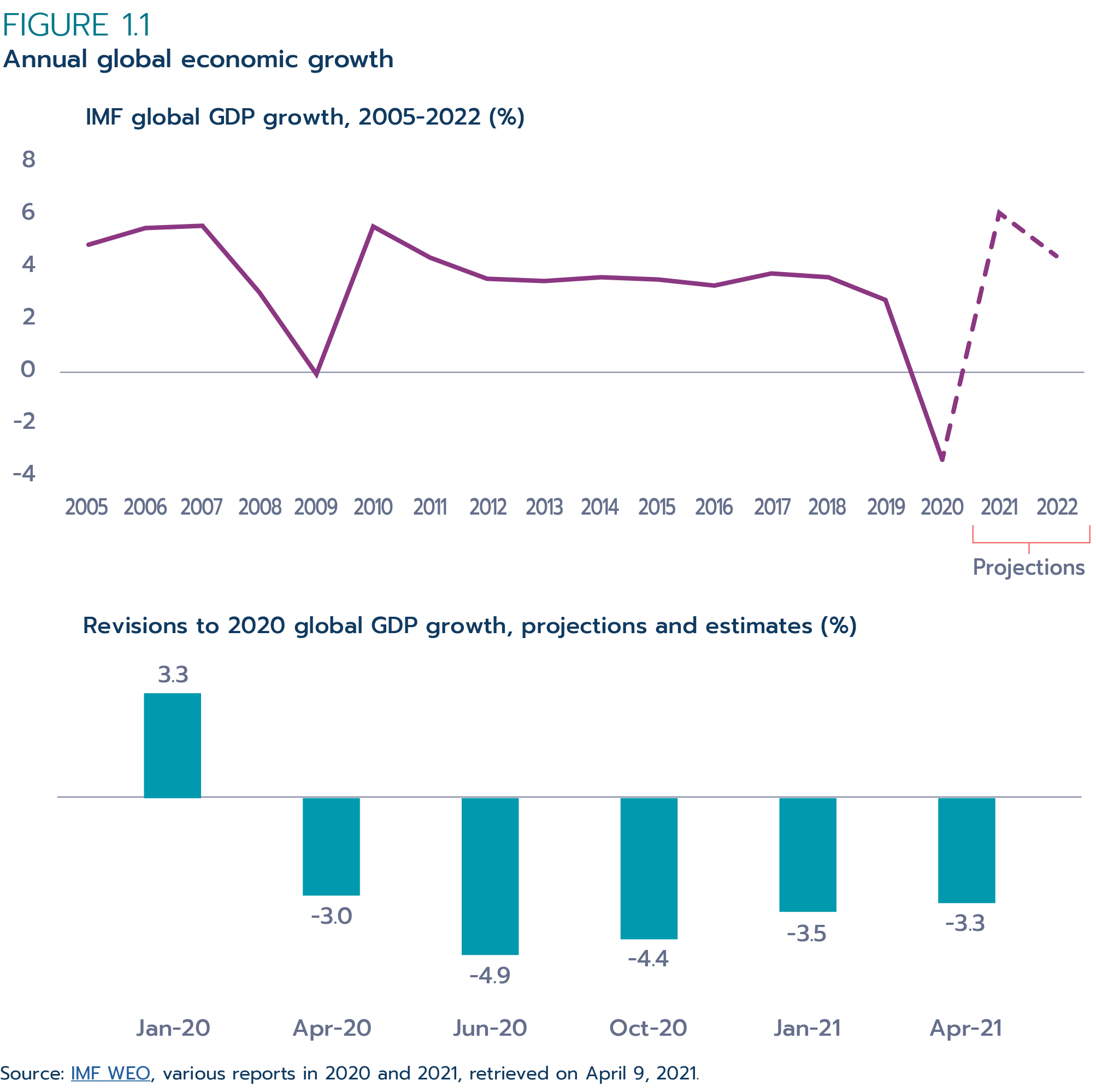
Text version
Figure 1.1 : Annual global economic growth
| 2005 | 2006 | 2007 | 2008 | 2009 | 2010 | 2011 | 2012 | 2013 | 2014 | 2015 | 2016 | 2017 | 2018 | 2019 | 2020 | 2021P | 2022P |
|---|---|---|---|---|---|---|---|---|---|---|---|---|---|---|---|---|---|
| 4.9 | 5.4 | 5.5 | 3.0 | -0.1 | 5.4 | 4.3 | 3.5 | 3.5 | 3.6 | 3.5 | 3.3 | 3.8 | 3.6 | 2.8 | -3.3 | 6.0 | 4.4 |
Revisions to 2020 global GDP growth, projections and estimates (%)
| IMF WEO | 2020 |
|---|---|
| Jan-20 | -3.3 |
| Apr-20 | -3.0 |
| Jun-20 | -4.9 |
| Oct-20 | -4.4 |
| Jan-21 | -3.5 |
| Apr-21 | -3.3 |
Data source: IMF WEO, various reports in 2020 and 2021, retrieved on April 9, 2021.
A similar degree of uncertainty surrounded global trade. While a decline in international trade flows was inevitable due to COVID restrictions, the degree of deterioration depended on how governments balanced virus containment and lockdown with their economies. The adoption of various trade restrictive policies at the onset of the pandemic also contributed to the contraction in global trade. At the height of the first wave of the pandemic, due to the combined effect of widespread lockdowns, bans on international travel, and trade restrictions placed on critical supplies to combat the virus, the World Trade Organization (WTO) anticipated global merchandise trade volume would suffer a historical decline ranging from 13% to 32% for the full year (WTO, 2020a). But as the year unfolded with recovery in trade accelerating in the second half of the year, the WTO revised its forecast for 2020 upwards (WTO, 2021b). In its latest press release on March 31, 2021, the WTO indicated that global merchandise trade volume contracted by 5.3% in 2020—even better than the best-case scenario in its initial forecast back in April 2020 (WTO, 2021).
The global pandemic also introduced a multifaceted shock to global flows of foreign direct investment (FDI) leading to the largest annual decline in FDI on record. The immediate negative impacts are estimated to have dragged down global FDI flows by 42% in 2020 (United Nations Conference on Trade and Development, 2020). But combined with its lingering effects, United Nations Conference on Trade and Development (UNCTAD) anticipates the COVID-19 pandemic to negatively impact the world's FDI flows in the long run far more than the GFC did. Moreover, the pandemic also had a varying degree of impact on FDI flows for different regions of the world. Developed countries were hit harder as their FDI flows fell by 69% in 2020, especially to Europe and the United States. In contrast, FDI flows to developing economies recorded a smaller decline of just 12%. Consequently, the share of global FDI in developing economies rose to 72% in 2020—the highest on record.
By the end of 2020, many countries had recovered, at least partially, from the pandemic. Collectively, we have avoided the worst-case scenario projected at the height of the pandemic, but the pace of recovery is still very much dictated by the direction in which the virus and its new variants are headed. Although the negative health and economic impacts from the pandemic are likely to remain in the medium term, as we gradually reach global herd immunity through vaccination, we can expect further cutbacks to restrictions and a return to our normal lives.
Box 1.1: The art of forecasting trade
As COVID-19 rapidly spread and disrupted every aspect of our lives, many wanted to know how trade would be affected. To tackle this question, the Office of the Chief Economist (OCE) used an innovative approach to combine its Computable General Equilibrium (CGE) model with macroeconomic and sectoral growth projections from Oxford Economics (OE).
Instead of looking at the impact of a change in tariffs as a result of a free trade agreement, we examined the impact on Canadian trade of the adverse shocks on labour supply, the GDP shocks on the hardest-hit sectors (e.g. tourism, hospitality and air transport) due to social confinement, and the overall GDP shocks for all major economies. The forecast was first undertaken in May 2020 at the height of the first wave and then again in October 2020 to account for some of the recovery that was taking place.
In May 2020, OE expected that Canada's GDP would decline 11%, its labour supply would decrease 16%, and that the hardest-hit sectors would contract by 30-40%. Based on these shocks, the OCE's CGE model revealed that Canadian exports to the world would shrink by 20% in 2020 and grow by 17% in 2021. As the economy improved slightly, we reiterated the exercise in October 2020, with OE's revised GDP growth forecast of -5.3% in 2020, and 5.9% in 2021. Using these newest forecasts, OCE's CGE model indicated that Canada's exports to the world would decline by 13% in 2020, rather than by 20% as initially forecasted in May, followed by a recovery of 7.6% in 2021. The October forecast of -13% turned out to be 3 percentage points lower than the actual drop of 10% for 2020 as the economy continued to slowly recover in the last 3 months of 2020.
The CGE model also allows us to identify in which markets Canadian exports would decline the most. It suggests that exports to the U.K. (‑32%), the U.S. (‑13%), and Europe (‑13%) would be harder hit than to other countries due to the relatively more severe COVID-19 conditions in those regions, while our exports to China (‑5%) and South Korea (‑7%) would be the least affected.
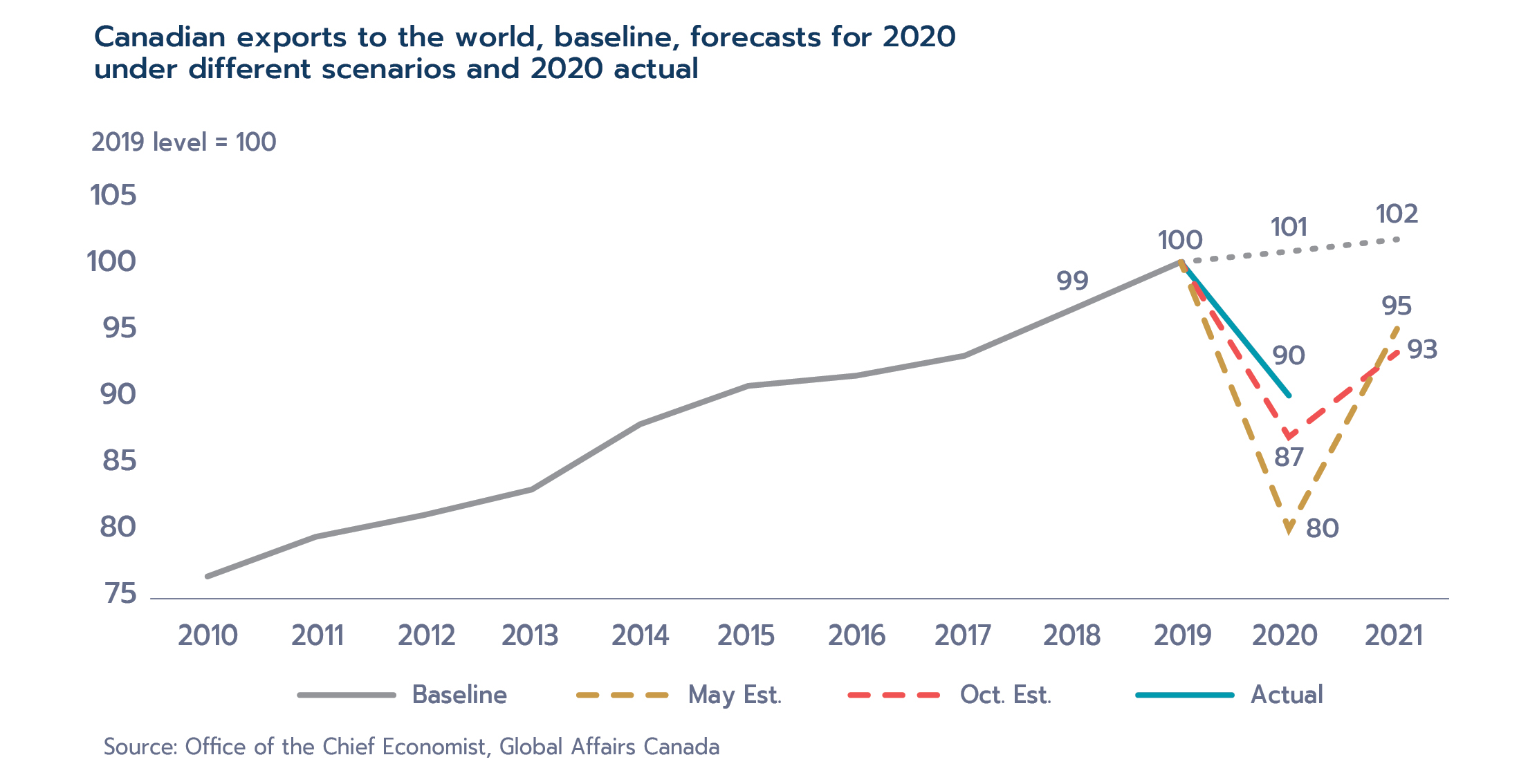
Text version
Canadian exports to the world, baseline, forecasts for 2020 under different scenarios and 2020 actual
| 2010 | 2011 | 2012 | 2013 | 2014 | 2015 | 2016 | 2017 | 2018 | 2019 | 2020 | 2021 | |
|---|---|---|---|---|---|---|---|---|---|---|---|---|
| Baseline | 77 | 80 | 82 | 84 | 90 | 93 | 93 | 95 | 99 | 100 | 101 | 102 |
| May Est. | 100 | 80 | 95 | |||||||||
| Oct. Est. | 100 | 87 | 93 | |||||||||
| Actual | 100 | 90 |
Source: Office of the Chief Economist, Global Affairs Canada
1.2 Canadian economic performance
The recovery in Canada's economy mimicked the pattern for the global economy. Following implementation of COVID-19 restrictions in March 2020, the Canadian economy experienced some of its largest quarterly declines since comparable data were available in the first 2 quarters of the year, contracting by 7.9% in Q1 and another 38% in Q2 (annualized). However, as the first wave of the pandemic passed and restrictions were relaxed in Canada, a rapid recovery followed. The Canadian economy expanded by 42% in the third quarter (annualized), also the fastest quarterly expansion on record. The rebound in Canada's economic activities slowed down in the fourth quarter of 2020 to 9.3% (annualized), as rising cases led to a second phase of the outbreak prompting another wave of lockdowns targeted to regions affected.
Overall, the Canadian economy contracted by 5.3% in 2020, the biggest contraction since comparable data were first recorded in 1961. Relative to other G7 countries, Canada stood in the middle of the pack in terms of decline in overall economic activities in 2020 (Figure 1.2).
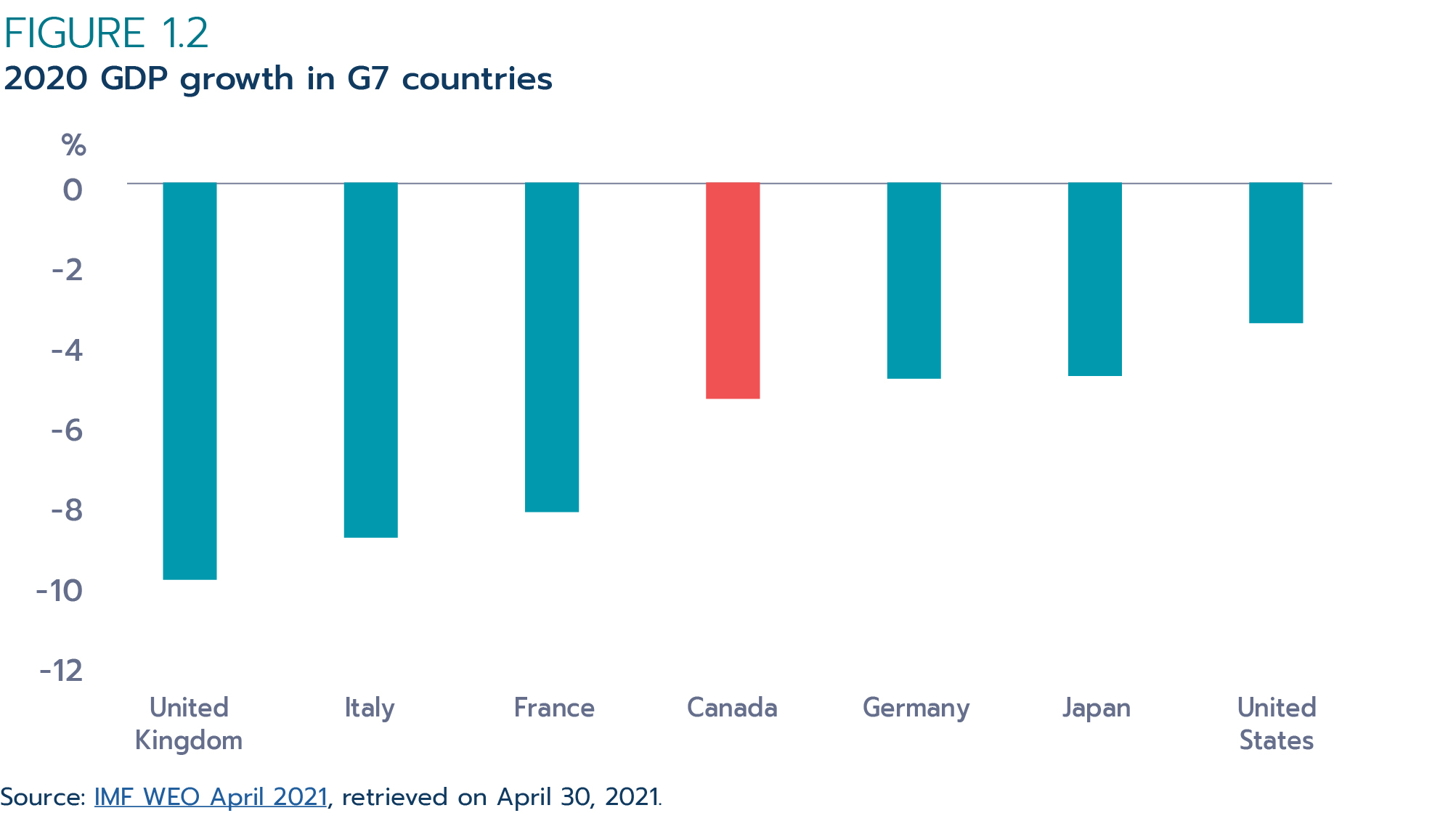
Text version
Figure 1.2: 2020 GDP growth in G7 countries
| Country | 2020 |
|---|---|
| United Kingdom | -9.9% |
| Italy | -8.9% |
| France | -8.2% |
| Canada | -5.4% |
| Germany | -4.9% |
| Japan | -4.8% |
| United States | -3.5% |
Data source: IMF WEO April 2021, retrieved on April 30, 2021.
The pandemic had an uneven impact across sectors in Canada, resulting in a "K" shaped recovery that is characterized by certain sectors recovering early while others stagnate or continue to decline. After significant declines from factory closures and indoor gathering restrictions, the manufacturing sector was one of the first to bounce back as restrictions were lifted and consumers increased spending. Moreover, certain commercial services such as finance and insurance, and real estate and rental and leasing, showed exceptional resilience throughout the year. On the other hand, sectors that rely on social interactions were some of the most affected. Not only have sectors like accommodation and entertainment plummeted at the onset of the pandemic, but they continued to struggle as additional waves of lockdowns in high-risk zones led to further restrictions of their main business activities. It is unlikely that these sectors will fully recover before social distancing and containment measures are completely lifted. By the end of 2020, goods-producing sectors had recovered for the most part, while many services-producing sectors had yet to overcome pandemic challenges (Figure 1.3).
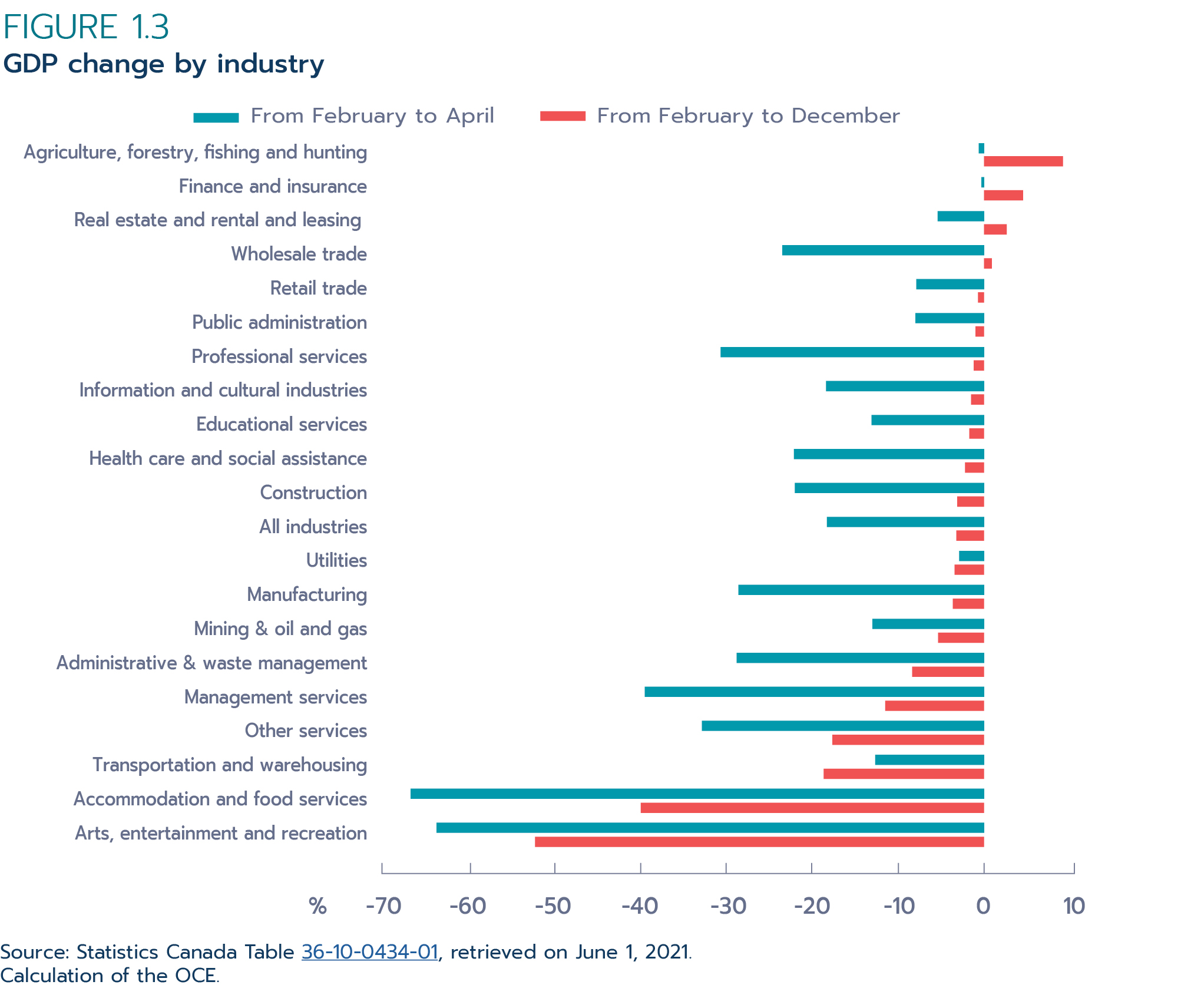
Text version
Figure 1.3: GDP change by industry
| Industry | From February to April (%) | From February to December (%) |
|---|---|---|
| Arts, entertainment and recreation | -61.3 | -51.8 |
| Accommodation and food services | -64.2 | -39.6 |
| Management services | -12.2 | -18.5 |
| Transportation and warehousing | -31.6 | -17.5 |
| Other services | -38.0 | -11.4 |
| Administrative & waste management | -27.7 | -8.3 |
| Mining & oil and gas | -12.5 | -5.3 |
| Manufacturing | -27.5 | -3.6 |
| Utilities | -2.8 | -3.4 |
| All industries | -17.6 | -3.2 |
| Construction | -21.2 | -3.1 |
| Health care and social assistance | -21.3 | -2.2 |
| Professional services | -12.6 | -1.7 |
| Educational services | -17.7 | -1.5 |
| Retail trade | -29.5 | -1.2 |
| Information and cultural industries | -7.7 | -1.0 |
| Public administration | -7.6 | -0.7 |
| Wholesale trade | -22.6 | 0.9 |
| Real estate and rental and leasing | -5.2 | 2.6 |
| Finance and insurance | -0.3 | 4.5 |
| Agriculture, forestry, fishing and hunting | -0.6 | 9.1 |
Data source: Statistics Canada, Table 36-10-0104-01, retrieved June 1, 2021. Calculation of the OCE.
The pandemic also had a profound impact on the labour market. For the full year, overall Canadian employment declined by 5.2% or nearly 1 million jobs, leading to Canada's annual unemployment rate rising nearly 4 pp, from 5.7% in 2019 to 9.5% in 2020. The pandemic's immediate impact on the labour market far surpassed the one experienced during the aftermath of the 2008-2009 GFC. On a monthly basis, Canadian employment plummeted by nearly 16% in 2 months since losses started (February to April 2020). However, monthly employment figures rebounded strongly afterwards before plateauing in September 2020. By the end of the year (10 months after losses started), employment in Canada remained 3.4% below the level in February 2020. The brunt of the impact was again felt by high-contact service industries, especially accommodation and food services, which saw total industry employment decline by nearly 50% at the height of the pandemic and only half the lost jobs recovered by the end of the year.
The gender and age gaps in employment were apparent early in the crisis. Female employment contracted by 17% compared to a 15% decline in male employment in the first 2 months since losses started. Similarly, employment in the 15-24 age group experienced a larger fall (-34%) than employment for all those aged 25 and older (‑13%). These gaps improved over the spring and summer, but have remained stable since.
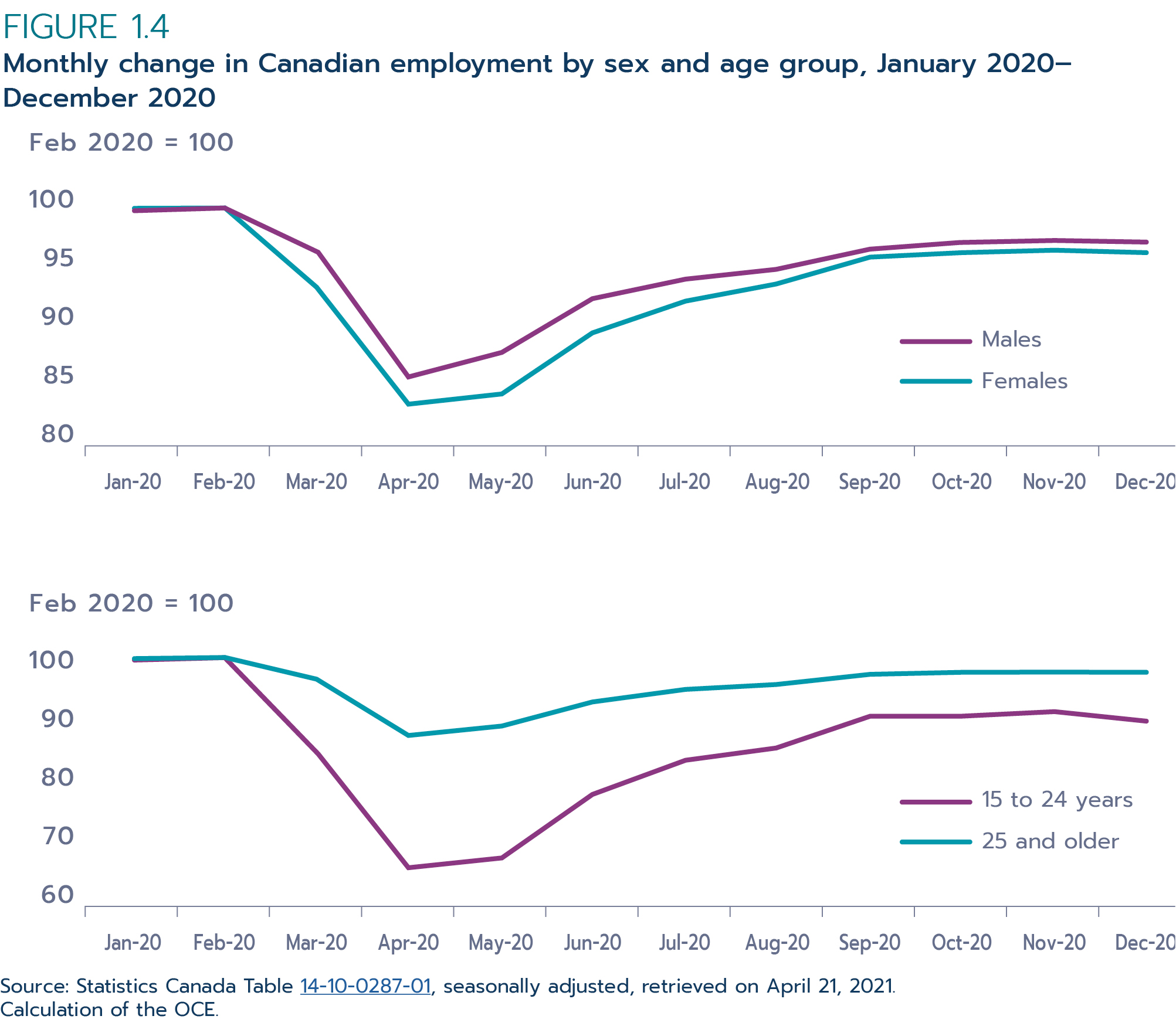
Text version
Figure 1.4: Monthly change in Canadian employment by sex and age group, January 2020 ‑ December 2020
| Feb 2020 = 100 | Jan-20 | Feb-20 | Mar-20 | Apr-20 | May-20 | Jun-20 | Jul-20 | Aug-20 | Sep-20 | Oct-20 | Nov-20 | Dec-20 |
|---|---|---|---|---|---|---|---|---|---|---|---|---|
| Males | 99.8 | 100.0 | 96.3 | 85.4 | 87.6 | 92.3 | 94.0 | 94.7 | 96.4 | 97.0 | 97.3 | 97.1 |
| Females | 100.0 | 100.0 | 93.1 | 83.2 | 84.2 | 89.3 | 92.1 | 93.6 | 95.8 | 96.2 | 96.5 | 96.1 |
| Feb 2020 = 100 | Jan-20 | Feb-20 | Mar-20 | Apr-20 | May-20 | Jun-20 | Jul-20 | Aug-20 | Sep-20 | Oct-20 | Nov-20 | Dec-20 |
|---|---|---|---|---|---|---|---|---|---|---|---|---|
| 15 to 24 years | 99.5 | 100.0 | 84.0 | 65.7 | 67.5 | 77.6 | 83.1 | 85.4 | 90.4 | 90.5 | 91.2 | 89.6 |
| 25 and older | 99.9 | 100.0 | 96.5 | 87.3 | 88.9 | 93.0 | 94.6 | 95.6 | 97.0 | 97.6 | 97.8 | 97.7 |
Data source: Statistics Canada Table 14-10-0287-01, seasonally adjusted, retrieved on April 21, 2021. Calculation of the OCE.
1.3 Canadian trade performanceFootnote 1
Like much of the world, Canada's international trade was affected by the global pandemic in 2020. Year-over-year, Canada's total trade in goods and services collapsed by 13% to $1.3 trillion in value. This was the second-fastest 1-year decline on record, after the 17% contraction observed from 2008 to 2009 from the GFC (Figure 1.5). Both Canadian exports and imports recorded double-digit declines, down 13% and 12%, respectively. As the decline in exports was greater than that of imports, Canada's trade deficit widened by $8.4billion in value to $45 billion. Moreover, as international trade was especially impacted by COVID restrictions, Canada's trade-to-GDP ratio plummeted more than 5 pp, from 65% in 2019 to 60% in 2020—also the lowest since 2009.
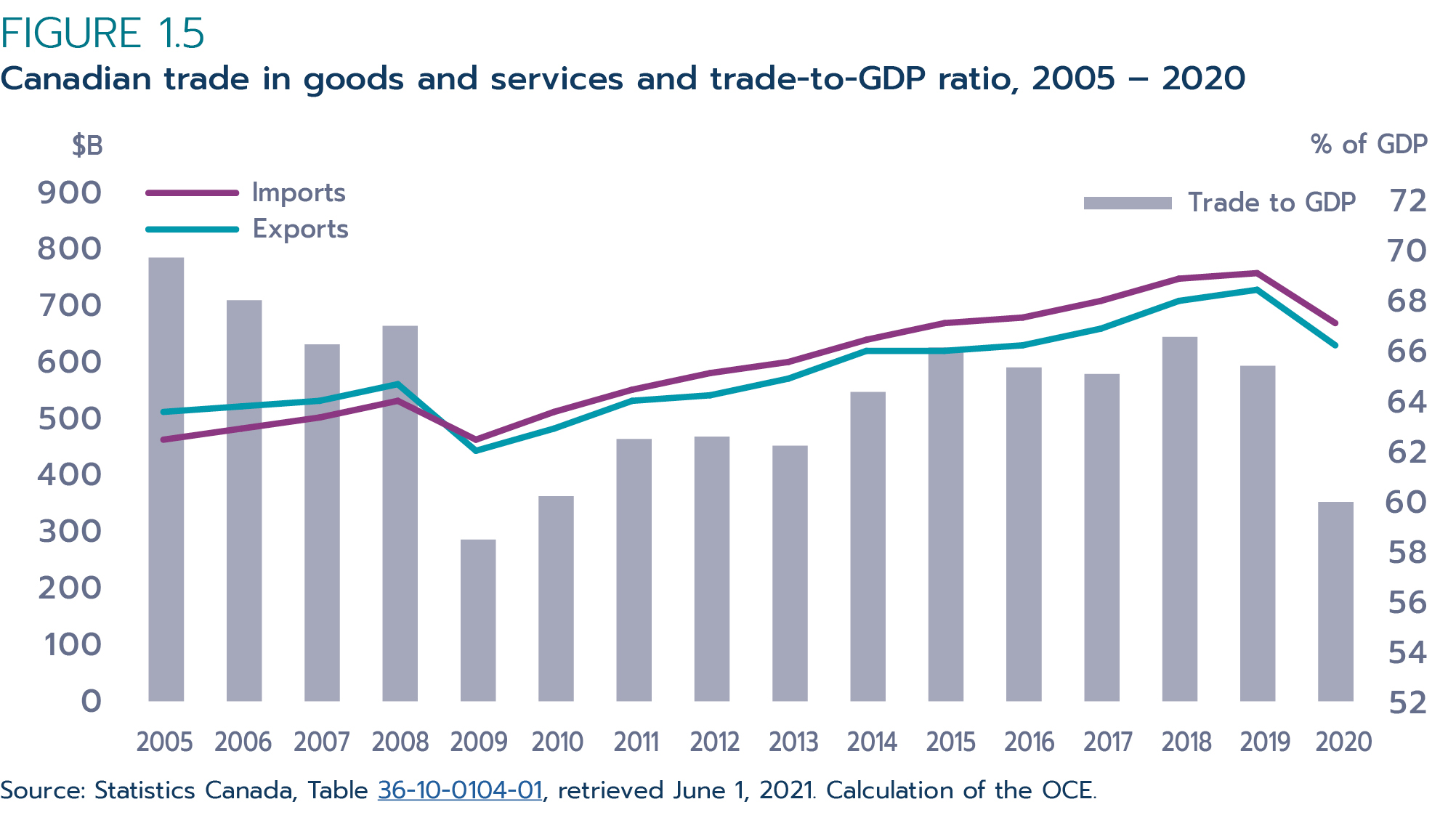
Text version
Figure 1.5: Canadian trade in goods and services and trade-to-GDP ratio, 2005 ‑ 2020
| Import ($M) | Export ($M) | Trade to GDP (%) | |
|---|---|---|---|
| 2005 | 467,732 | 523,945 | 70 |
| 2006 | 488,627 | 529,824 | 68 |
| 2007 | 505,701 | 540,026 | 66 |
| 2008 | 540,669 | 569,939 | 67 |
| 2009 | 470,749 | 448,079 | 58 |
| 2010 | 517,153 | 485,942 | 60 |
| 2011 | 564,513 | 544,254 | 62 |
| 2012 | 589,137 | 554,612 | 63 |
| 2013 | 606,801 | 576,989 | 62 |
| 2014 | 651,176 | 633,112 | 64 |
| 2015 | 683,019 | 633,955 | 66 |
| 2016 | 685,868 | 638,095 | 65 |
| 2017 | 720,254 | 673,326 | 65 |
| 2018 | 763,874 | 721,679 | 67 |
| 2019 | 774,372 | 737,500 | 65 |
| 2020 | 683,685 | 638,449 | 60 |
Data source: Statistics Canada, Table 36-10-0104-01, retrieved June 1, 2021. Calculation of the OCE.
Goods
In 2020, overall Canadian trade in goods contracted by 10% compared to 2019. Canadian goods exports were more affected than imports, falling by 12% to $524 billion in value, while goods imports only contracted by 8.5% to $561 billion. The sharp fall in goods exports was a result of a combination of both the price and the volume effect. Year-over-year, goods export volumes fell 6.6%, and export prices were down 6.1%. On the other hand, the contraction for Canadian goods imports was driven purely by volume, down 9.7%, while import prices rose 1.3% compared to the previous year.
Trade performance by product sector
The declines in exports were concentrated in the second quarter of the year, when pandemic-restriction measures were implemented at home and abroad, limiting social interactions and halting factory productions. Most export sectors posted declines during the first wave of the pandemic, with those producing durable goods and relying on international supply chains being the most affected. However, similar to global trade, export sectors in Canada rebounded in the second half of the year. By the end of December, the level of Canadian goods exports was only 0.6% lower when compared to the pre-COVID benchmark in February. For 2020 overall, 8 out 11 goods export sectors posted declines.
In 2020, the top 3 Canadian goods exports in terms of value were energy products, motor vehicles and parts, and consumer goods (Table 1.1), the same as it was in 2019. However, the 2 largest export sectors, energy and motor vehicles, registered historical declines and were responsible for most of the decline in total Canadian goods exports, while exports of consumer goods improved marginally. As a result, the top 3 sectors together only accounted for 42% of Canada's goods exports, down 5 pp from 47% in 2019.
Energy products remain the top export sector for Canada, accounting for 14% of Canada's total exports. Nonetheless, the sector posted its fastest 1-year decline in export value on record and the largest contraction in value out of all the sectors in 2020. Compared to 2019, the sector shrank by 37% or $43 billion to $74 billion, a decline mainly attributable to the $34-billion drop in exports of crude oil and crude bitumen. Additionally, other energy products such as refined petroleum and coal also recorded annual declines of over 40%. Partially mitigating these declines were higher exports of electricity (+2.1%) and nuclear fuel and other energy products (+15%). Exports in this sector have rebounded since the initial shock from the pandemic with overall energy exports in December 2020 only 3.4% below the level in February.
Motor vehicles and parts was Canada's second-largest export sector in 2020. Following strong growth in 2019, exports of motor vehicles and parts declined 20% in 2020, mainly due to lower exports of passenger cars and light trucks. Like energy products, the declines in exports of motor vehicles and parts were also concentrated during the initial wave of the pandemic, falling as much as 85% from February to April. However, while exports rebounded rapidly in the third quarter as restrictions were lifted, recovery plateaued in the fourth quarter of 2020. By the end of the year, exports of motor vehicles and parts stood at 8.8% below its pre-pandemic level.
In addition to energy and motor vehicles and parts, 6 other product sectors posted declines in export value in 2020. Four recorded double-digit declines: industrial machinery, equipment and parts; basic and industrial chemical, plastic and rubber products; electronic and electrical equipment and parts; and aircraft and other transportation equipment and parts. It should be noted that the annual results mask the important movement from month to month in exports in 2020. Exports declined dramatically in April and May due the spread of COVID-19 and slowly recovered in the following months. By late 2020, most export sectors had returned to pre-COVID levels.
On the import side, 7 out of 11 sectors posted declines for the full year. Consumer goods remain the top import sector, accounting for over one fifth of Canadian imports. The sector recorded a moderate expansion of 1.4%, primarily because of increased imports of medical supplies and personal protective equipment to combat the pandemic. The other 3 sectors that posted increases in imports were metal and non-metallic mineral products; metal ores and non-metallic minerals; and farm, fishing and intermediate food products. In contrast, large import sectors such as motor vehicles and parts and industrial machinery, equipment and parts recorded substantial declines.
Table 1.1: Value of Canadian goods trade in 2020 by product sector
Value | Change | Change | |
|---|---|---|---|
| Exports | |||
| Aircraft and other transportation equipment and parts | 22 | -20 | -5.6 |
| Basic and industrial chemical, plastic and rubber products | 31 | -11 | -3.7 |
| Consumer goods | 71 | 0.0 | 0.0 |
| Electronic and electrical equipment and parts | 26 | -12 | -3.6 |
| Energy products | 74 | -37 | -43 |
| Farm, fishing and intermediate food products | 44 | 15 | 5.7 |
| Forestry products and building and packaging materials | 42 | -0.6 | -0.3 |
| Industrial machinery, equipment and parts | 35 | -15 | -6.0 |
| Metal and non-metallic mineral products | 67 | 2.5 | 1.6 |
| Metal ores and non-metallic minerals | 21 | -0.2 | 0.0 |
| Motor vehicles and parts | 74 | -20 | -19 |
| Total | 524 | -12 | -74 |
| Imports | |||
| Aircraft and other transportation equipment and parts | 19 | -27 | -7.0 |
| Basic and industrial chemical, plastic and rubber products | 41 | -8.3 | -3.8 |
| Consumer goods | 127 | 1.4 | 1.8 |
| Electronic and electrical equipment and parts | 68 | -5.8 | -4.2 |
| Energy products | 23 | -39 | -14 |
| Farm, fishing and intermediate food products | 21 | 0.8 | 0.2 |
| Forestry products and building and packaging materials | 26 | -3.3 | -0.9 |
| Industrial machinery, equipment and parts | 60 | -13 | -8.9 |
| Metal and non-metallic mineral products | 50 | 26 | 10 |
| Metal ores and non-metallic minerals | 16 | 16 | 2.3 |
| Motor vehicles and parts | 87 | -24 | -28 |
| Total | 561 | -8.5 | -52 |
Data source: Statistics Canada, Table 12-10-0122-01, retrieved May 31, 2021. Calculation of the OCE.
Box 1.2: Are immigrant-led SMEs more likely to export?
Canada has a large immigrant population: 1 in 5 Canadians are foreign born. New Canadians are typically highly educated: 34% have a bachelor's degree. As observed in many countries, immigrants are more likely to own or run a business than are native-born citizens. In Canada, immigrant-led small and medium-sized enterprises (SMEs)* are more likely to export (14.3%), compared to both the Canadian average (11.7%) and SMEs with Canadian-born leaders (10.8%) (Blanchet, 2021).
Data source: Statistics Canada, Survey on financing and growth of small and medium enterprises, 2017.
Calculation of the OCE.
A number of factors may help explain this phenomenon. Immigrants continue to maintain relationships with, and have intrinsic knowledge of how to conduct business in, their countries of origin: this facilitates exporting to their home countries. It is also observed that immigrant-led SMEs are more likely to operate in export-intensive industries, such as accommodation and food services, or retail trade. In addition, between 2014 and 2017, the number of immigrant-led SMEs grew proportionally faster than the number of SMEs led by those born in Canada: immigrants in Canada currently lead 1 in 4 SMEs. Furthermore, the number of immigrant-led SMEs that export has grown almost twice as fast (+27%) as the number of exporting SMEs led by those born in Canada (+14%).
Considering women-owned SMEs in Canada, the export propensity of SMEs owned by immigrant women is almost twice that of those owned by Canadian-born women, at 17% and 9.0%, respectively. In short, the contribution of immigrants to Canada's economy and trade performance is undeniable.
* The immigrant-led SME category refers to SMEs where the primary decision maker self-identifies as being born outside of Canada.
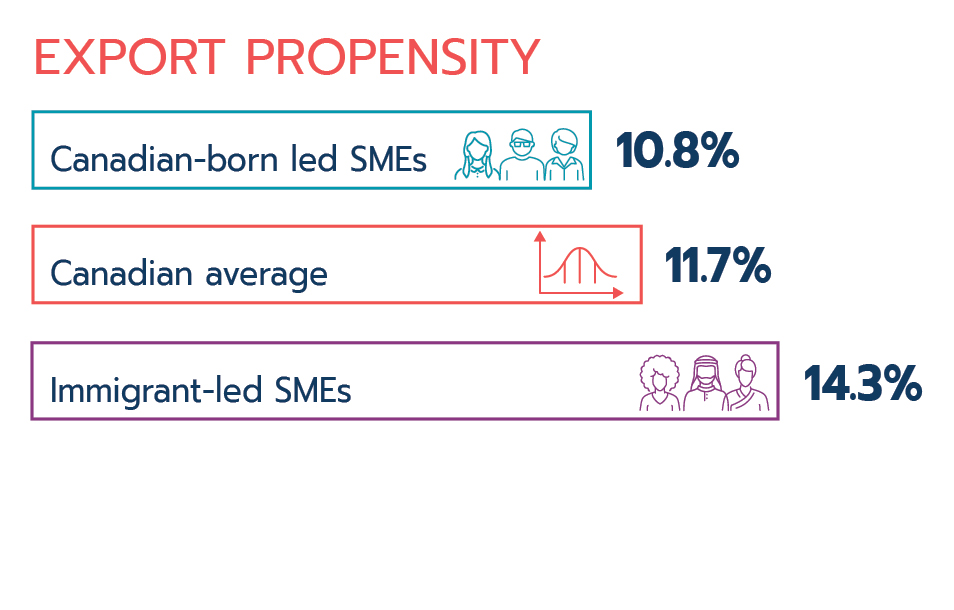
Text version
Export propensity
| Export propensity (%) | |
|---|---|
| Canadian-born led SMEs | 10.8 |
| Canadian average | 11.7 |
| Immigrant-led SMEs | 14.3 |
Source: Statistics Canada, Survey on financing and growth of small and medium enterprises, 2017. Calculation of the OCE.
Goods import sources and export destinations
Canada's goods exports declined to most of its top trading partners in 2020. Although the United States remains Canada's top export destination by far, Canadian goods exports to the U.S. plummeted by 16% for the year. As this decline outpaced the overall decline in Canadian goods exports, the U.S. share of Canadian goods exports contracted to 72% in 2020—the lowest since 1982. At the same time, Canadian goods imports from the U.S. also registered a double-digit decline of 11%. Overall, lower 2-way trade with the U.S. accounted for most of the decline in Canada's goods trade in 2020.
In comparison, exports to the European Union (EU) and the United Kingdom (U.K.) have held up relatively well. Year-over-year, Canadian exports to the EU fell 2.0% and imports from the EU fell 12%. Moving into the third year of Canada-European Union Comprehensive Economic and Trade Agreement (CETA), Canadian exports to the EU remain strong despite the pandemic. Of the main EU partners, exports rose significantly to Italy and the Netherlands. Although the U.K. left the EU at the beginning of the year, the temporary measures put in place during this transitional period maintained the status quo and continue to facilitate 2-way trade between Canada and the U.K. For 2020 overall, both Canadian exports to and imports from the U.K. improved, advancing by 4.4% and 12%, respectively.
Trade with partners in Asia showed a mixed picture. Following the largest decline on record in 2019, Canadian goods exports to China advanced 7.4% in 2020, supported by farm, fishing and intermediate food products; metal ores and non-metallic minerals; and consumer goods. Meanwhile, Canadian goods imports from China climbed 5.7% on the back of increased shipments of consumer goods. Trade with other large Asian trading partners recorded different levels of declines. Exports to Japan held up relatively well (‑2.2%), but exports to South Korea, India, and Hong Kong all recorded historical declines.
Table 1.2: Value of Canadian goods trade in 2020 by partner
Value | Change | Change | |
|---|---|---|---|
| Exports | |||
| United States | 376 | -16 | -70 |
| European Union | 29 | -2.0 | -0.6 |
| China | 26 | 7.4 | 1.8 |
| United Kingdom | 21 | 4.4 | 0.9 |
| Japan | 13 | -2.2 | -0.3 |
| Mexico | 7.0 | -16 | -1.4 |
| South Korea | 4.8 | -16 | -0.9 |
| India | 3.8 | -24 | -1.2 |
| Hong Kong | 1.9 | -53 | -2.2 |
| Other Countries | 41 | -0.1 | 0.0 |
| Total | 524 | -12 | -74 |
| Imports | |||
| United States | 349 | -11 | -43 |
| European Union | 51 | -12 | -6.9 |
| China | 50 | 5.7 | 2.7 |
| Mexico | 17 | -17 | -3.5 |
| Japan | 10 | -19 | -2.4 |
| United Kingdom | 9.4 | 12 | 1.0 |
| South Korea | 7.5 | -10 | -0.8 |
| Hong Kong | 4.2 | -0.7 | 0.0 |
| India | 3.9 | -5.9 | -0.2 |
| Other Countries | 60 | 1.1 | 0.6 |
| Total | 561 | -8.5 | -52 |
Data source: Statistics Canada, Table 36-10-0023-01, retrieved May 31, 2021. Calculation of the OCE.
Box 1.3: Promoting FTAs: helping more Canadian exporters understand how to use them
Some Canadian exporters are still unaware of the benefits of free trade agreements (FTAs) and the resources at their disposal to make full use of them.* In the last few years, Global Affairs Canada (GAC) has taken an innovative approach to help as many exporters as possible understand and fully utilize such FTAs as the Canada-United States-Mexico Agreement (CUSMA), the Comprehensive and Progressive Agreement for Trans-Pacific Partnership (CPTPP), and the Canada-European Union Comprehensive Economic and Trade Agreement (CETA).
To that end, GAC has been busy honing its innovative strategies, adding the following business intelligence tools to its toolkit:
- Canada Tariff Finder, which allows a potential exporter to search the tariffs applicable to its product (using harmonized system codes) in an FTA partner country
- Market Potential Finder, which enables trade commissioners to determine market opportunity leads for exporting businesses in CETA countries and in selected CPTPP economies based on intelligence developed from empirical trade data and exclusive qualitative input from the Trade Commissioner Service (TCS) network abroad
In 2020, the COVID-19 pandemic disrupted international business conditions, which created additional challenges for businesses wanting to export. Once again, GAC innovated by transitioning from in-person training sessions to digital offerings. In the fall of 2020, GAC held the first virtual trade mission (VTM) to South Korea. Led by the Honourable Mary Ng, Minister of Small Business, Export Promotion and International Trade, the VTM highlighted the tools, programs, business leads and information the TCS and its partners can offer Canadian entrepreneurs and exporters looking to expand in South Korea. It also provided information about sectors of growth in South Korea, available export support and funding, as well as the benefits of FTAs such as the Canada-Korea Free Trade Agreement (CKFTA). The VTM was a huge success; it allowed micro-firms and underrepresented exporters that might otherwise have lacked the time or money to participate in a regular trade mission to join virtually. The benefits of using a hybrid virtual/in-person approach for future trade missions are clear.
Recent data on utilization of FTAs have shown GAC the importance of continuing its FTA promotion activities. After CUSMA replaced the North American Free Trade Agreement (NAFTA) and entered into force on July 1, 2020, the agreement maintained a high utilization rate in the second half of 2020: 69% of Canadian exporters to the U.S. leveraged the trade benefits of the agreement. In contrast, CETA has only been in force for 3 years, and the FTA promotion activities have been crucial to increase awareness among exporters. The utilization of CETA among Canadian exporters to the EU-27 improved noticeably, from about 52% in 2018 to about 57% in 2020. Further work will be required to increase CETA utilization rates to levels comparable to those of CUSMA. The TCS is looking to engage businesses in more sector-specific activities and assist them in their strategic plans to diversify their export markets.
*Global Affairs Canada's survey (n=2,089) on "Canadian Attitudes towards International Trade" conducted in February 2020 suggests that while Canadians are generally supportive of free trade, they have limited knowledge of free trade agreements.
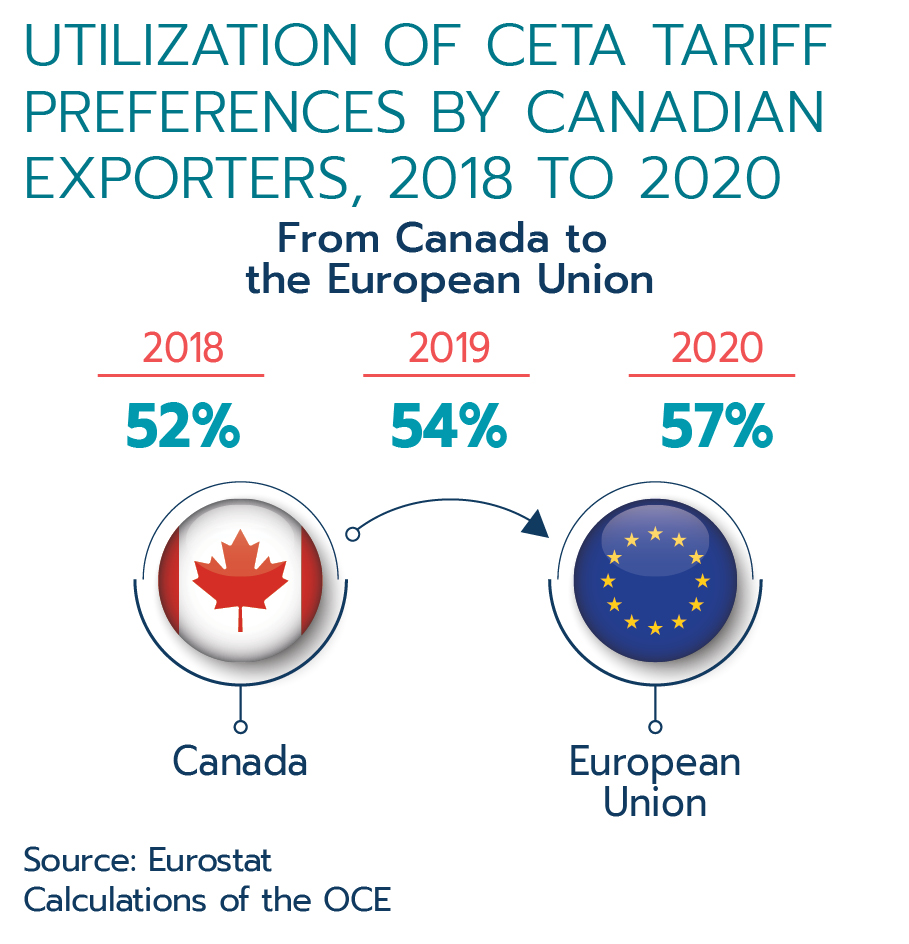
Text version
Utilization of CETA tariff preferences by Canadian exporters, 2018 to 2020
| Utilization rate (%) | |
|---|---|
| 2018 | 52 |
| 2019 | 54 |
| 2020 | 57 |
Source: Eurostat.
Calculation of the OCE.
Box 1.4: TCS leveraged its expertise to secure critical medical supplies for Canadians
In 2020, Canada dramatically increased its imports of medical supplies in response to the COVID-19 pandemic. Overall Canadian imports of medical supplies grew by 30% year-over-year, led by 137% growth in personal protective equipment (PPE). The United States remained Canada's top source of imports. The U.S. in harnessing its advanced medical resources was Canada's main supplier of sophisticated medical products such as medical devices, diagnostic instruments, and medicaments. China followed closely in second place, supplying over 60% of Canada's PPE imports over the past year. Since the start of the pandemic, Canada was also able to import more medical goods from other trading partners in Europe, such as Switzerland and Sweden, and in Asia, most notably South Korea and Malaysia. However, monthly Canadian imports of medical goods (especially PPE) have trended down since peaking in June 2020, likely a result of the government's "Made in Canada" call to action, which supported building domestic PPE production capacity. By February 2021, imports were at their lowest monthly value since March 2020.
Since the start of the pandemic, the TCS has played a pivotal role in securing critical medical supplies. At the height of the pandemic when Canada faced an unprecedented demand for PPE and medical devices such as ventilators, the TCS leveraged its expertise to identify likely sellers of PPE and brokered the best deals on behalf of Canada. As medical goods shortages were eventually resolved, the TCS then worked tirelessly to ensure an adequate supply of COVID-19 vaccines reached Canadians. At the same time, despite pandemic challenges, the TCS continued to support Canadian exporters by connecting businesses to customers abroad.
Services
The global pandemic had an even larger impact on services trade, especially on sectors that depend on face-to-face interactions. For the full year, Canadian services trade fell by 21% to $237 billion in value, with services exports declining by 18% and services imports plummeting 24%.
Services trade by sector
As pandemic containment measures around the world restricted travel and kept a large portion of the global population housebound, travel and transportation became the 2 hardest-hit sectors. In 2020, Canadian travel exports plummeted 59%, and travel imports fell 66% compared to the year prior, mainly because countries imposed restrictions on entry into their territory and fewer individuals travelled. Similarly, Canadian exports of transportation services were down 27% over this period, and transportation imports fell 28%, with air transportation contributing the most to the declines since air transportation is more dependent on passenger travels. By the end of December 2020, on a seasonally adjusted basis, both travel and transportation exports were still well below their pre-pandemic levels in February 2020. Industry experts predict that levels would not return to normal in the short term.
In a sharp contrast to travel and transportation services, trade in commercial services has held steady throughout the year and even surpassed pre-COVID levels. On a year-over-year basis, Canadian exports of commercial services advanced 3.2% to $84 billion in value. This growth was mainly supported by increased exports of professional and management consulting services, and financial services. At the same time, Canadian imports of commercial services were up 2.5% to reach $81 billion, with increased imports of financial services partially offset by lower imports of maintenance and repair services.
Table 1.3: Value of Canadian services trade in 2020 by type
Value | Change | Change | |
|---|---|---|---|
| Exports | |||
| Commercial | 84 | 3.2 | 2.6 |
| Travel | 15 | -59 | -22 |
| Transportation | 14 | -27 | -4.9 |
| Government | 1.4 | -17 | -0.3 |
| Total | 115 | -18 | -25 |
| Imports | |||
| Commercial | 81 | 2.5 | 1.9 |
| Transportation | 16 | -66 | -31 |
| Travel | 23 | -28 | -9.1 |
| Government | 1.4 | -8.0 | -0.1 |
| Total | 122 | -24 | -39 |
Data source: Statistics Canada, Table 36-10-0021-01, retrieved May 31, 2021. Calculation of the OCE.
Services import sources and export destinations
Canada posted double-digit declines in services trade with every one of its top trading partners in 2020. As the United States is Canada's largest services trading partner by far, it accounted for most of this contraction in terms of value. Year-over-year, Canadian services exports to the United States fell by 12% or $8.9 billion, almost entirely driven by the 85% decline in travel exports and 16% decline in transportation exports, while exports of commercial services were up 5.7%. At the same time, services imports from the U.S. contracted 22% or $19 billion, with travel and transportation imports declining by 69% and 37%, respectively.
Services trade with partners in Europe and Asia showed a similar decline. Although the EU remained Canada's second-largest services trading partner, 2-way trade in every type of service declined in 2020. For the full year, services exports to the EU fell by 28%, while services imports fell 30%. The United Kingdom, no longer part of the EU, stood as the third-largest services trading partner for Canada, followed by China and Hong Kong to round out the top 5. Services trade with all 3 partners deteriorated in 2020.
Table 1.4: Value of Canadian services trade in 2020 by trade partner
Value | Change | Change | |
|---|---|---|---|
| Exports | |||
| United States | 66 | -12 | -8.9 |
| European Union | 11 | -28 | -4.5 |
| United Kingdom | 5.8 | -20 | -1.5 |
| China | 5.4 | -34 | -2.7 |
| India | 2.8 | -32 | -1.4 |
| Hong Kong | 1.4 | -26 | -0.5 |
| Japan | 1.3 | -33 | -0.6 |
| Mexico | 1.2 | -40 | -0.8 |
| South Korea | 0.8 | -38 | -0.5 |
| Other Countries | 19 | -15 | -3.4 |
| Total | 115 | -18 | -25 |
| Imports | |||
| United States | 68 | -22 | -19 |
| European Union | 14 | -30 | -6.2 |
| United Kingdom | 7.0 | -11 | -0.8 |
| Hong Kong | 4.5 | -16 | -0.8 |
| China | 2.4 | -29 | -1.0 |
| Mexico | 2.2 | -49 | -2.1 |
| Japan | 2.1 | -31 | -1.0 |
| India | 2.0 | -18 | -0.5 |
| South Korea | 0.4 | -20 | -0.1 |
| Other Countries | 19 | -27 | -7.1 |
| Total | 122 | -24 | -39 |
Data source: Statistics Canada, Table 36-10-0024-01, may 31, 2021 . Calculation of the OCE.
1.4 Canadian foreign direct investment performance
Like other aspects of the economy, Canada's foreign investment performanceFootnote 2 was severely impacted by the global pandemic, with both flows of inward foreign direct investment (FDI) and Canadian direct investment abroad (CDIA) registering large declines. For 2020 overall, Canadian FDI flows plummeted by 49% or $31 billion, and CDIA contracted 41% or $42 billion. While foreign direct investment flows have historically been more volatile than trade or other aspects of the economy, this level of 1‑year decline was only surpassed by the crashes in FDI and CDIA due to the GFC in 2008-2009 when they fell by 60% and 46%, respectively. Nevertheless, the decline in Canada's foreign direct investment performance was roughly on par with that of the world.
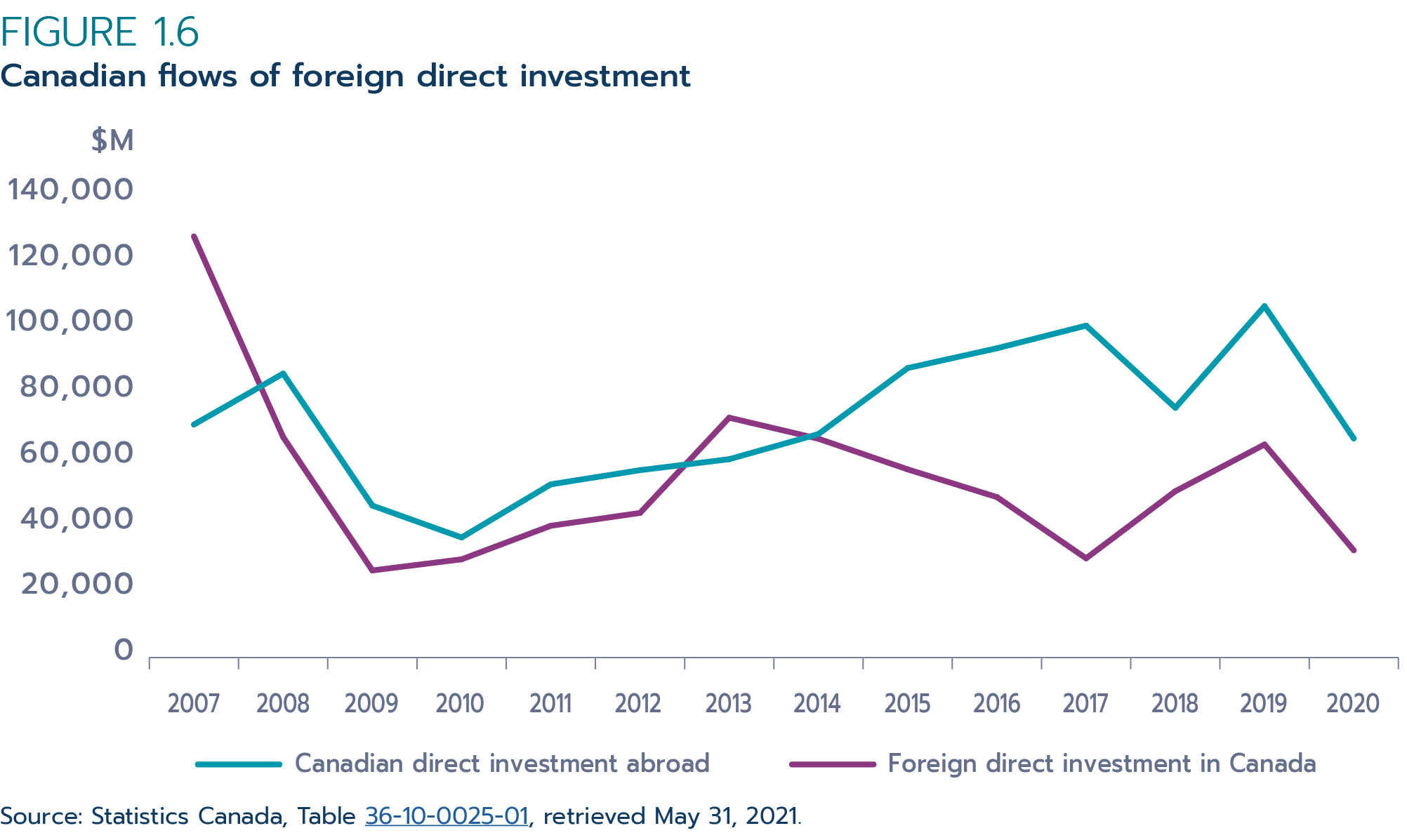
Text version
Figure 1.6: Canadian flows of foreign direct investment
$ Millions
| Canadian direct investment abroad | Foreign direct investment in Canada | |
|---|---|---|
| 2007 | 69,416 | 125,476 |
| 2008 | 84,592 | 65,679 |
| 2009 | 45,268 | 25,948 |
| 2010 | 35,770 | 29,257 |
| 2011 | 51,602 | 39,254 |
| 2012 | 55,819 | 43,076 |
| 2013 | 59,091 | 71,459 |
| 2014 | 66,584 | 65,186 |
| 2015 | 86,242 | 56,057 |
| 2016 | 92,140 | 47,796 |
| 2017 | 98,888 | 29,550 |
| 2018 | 74,402 | 49,552 |
| 2019 | 104,681 | 63,470 |
| 2020 | 62,276 | 32,321 |
Data source: Statistics Canada, Table 36-10-0025-01, retrieved May 31, 2021.
Box 1.5: Canada's FDI recovery following the GFC suggests post-COVID recovery
Contribution by Invest in Canada
As seen in Figure 1.6, Canada's FDI flows took a hit in 2020. This 49% drop was relatively less severe than the decline caused by the GFC when FDI flows fell by over 60%, from $66 billion to $26 billion between 2008 and 2009 (Statistics Canada, Table 36-10-0025-01). Flows started recovering in 2010, but it took 4 years before they surpassed their 2008 pre-GFC level. While Canada's recovery may appear to be slow, Canada's FDI performance in past crises demonstrates Canada's resilience and stability in comparison to its G7 peers. Based on UNCTAD data, Canada was the only G7 country to demonstrate 9 years of consecutive growth in FDI inflows following the recession in the early 1990s and was also the only G7 country to demonstrate 4 years of consecutive growth in FDI inflows following the GFC. The later growth led to Canada increasing its 1.8% share of global FDI flows in 2009 to 4.8% by 2013, the largest gain in global FDI share than any other G7 country—ahead of the U.S. whose share increased 2.2 pp. During the same period, Canada also had the highest FDI flows per capita (US$1,965.3) among the G7 by 2013. Canada's past performance showed that, although it may take a few years, Canada's FDI flows do rebound from a large shock and hopefully they will likewise rebound from the COVID-19 pandemic in the not-too-distant future.
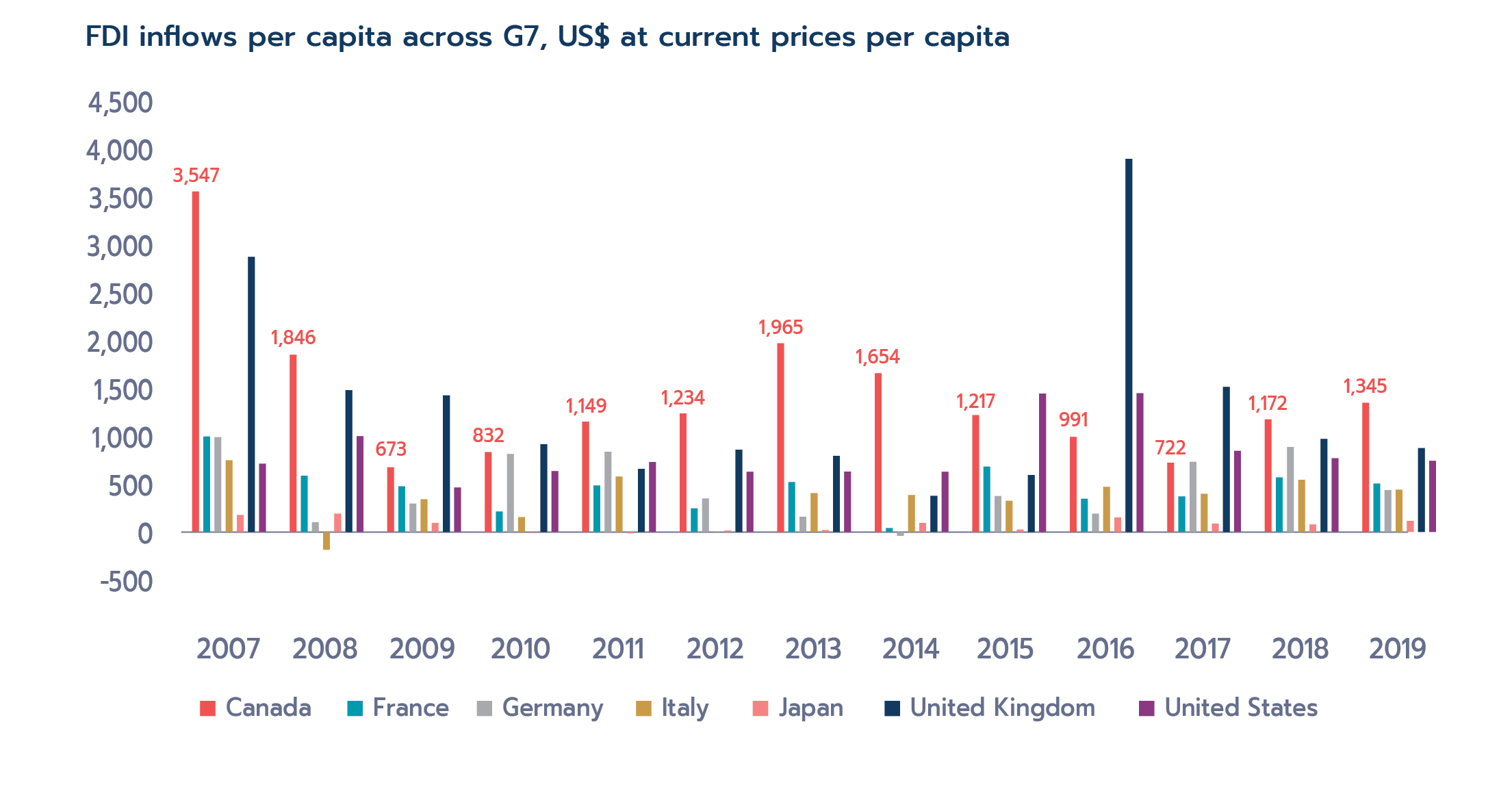
Text version
FDI inflows per capita across G7, US$ at current prices per capita
| 2007 | 2008 | 2009 | 2010 | 2011 | 2012 | 2013 | 2014 | 2015 | 2016 | 2017 | 2018 | 2019 | |
|---|---|---|---|---|---|---|---|---|---|---|---|---|---|
| Canada | 3,547 | 1,846 | 673 | 832 | 1,149 | 1,234 | 1,965 | 1,654 | 1,217 | 991 | 722 | 1,172 | 1,345 |
| France | 993 | 585 | 476 | 214 | 484 | 244 | 519 | 40 | 681 | 345 | 370 | 568 | 504 |
| Germany | 987 | 100 | 294 | 812 | 835 | 348 | 157 | -39 | 373 | 190 | 730 | 885 | 435 |
| Italy | 746 | -184 | 340 | 155 | 576 | 2 | 404 | 385 | 324 | 469 | 396 | 542 | 439 |
| Japan | 175 | 190 | 93 | -10 | -14 | 13 | 18 | 94 | 23 | 152 | 86 | 77 | 115 |
| United Kingdom | 2,866 | 1,477 | 1,422 | 914 | 657 | 856 | 792 | 376 | 593 | 3,887 | 1,512 | 969 | 872 |
| United States | 710 | 997 | 463 | 633 | 729 | 627 | 629 | 626 | 1,442 | 1,445 | 844 | 768 | 741 |
Source: UNCTADStat, retrieved April 22, 2021.
FDI and CDIA sectoral composition
By sector, most of the $42-billion decrease in CDIA flows in 2020 can be attributed to the management of companies and enterprises sector (a notable $27-billion or 78% decrease following a spike in the year prior), trailed by energy and mining, and trade and transportation. In contrast, CDIA flows in the finance and insurance sector contracted marginally, and those in the manufacturing sectors and "Other industries" expanded .
On the other hand, energy and mining was the main driver of the decline in FDI flows. Following a $15‑billion increase in 2019 to over $20 billion in value, FDI in this sector posted a huge contraction in 2020, resulting in divestment of $7.3 billion. FDI flows into Canada's finance and insurance, management of companies and enterprises, and manufacturing sectors also recorded significant declines.
Table 1.5 Canada's CDIA and FDI flows by sector (2020)
Value | Change | Change | |
|---|---|---|---|
| CDIA | |||
| Energy and mining | 5.3 | -70 | -12 |
| Finance and insurance | 29 | -2.0 | -0.6 |
| Management of companies and enterprises | 7.4 | -78 | -27 |
| Manufacturing | 5.1 | 5.8 | 0.3 |
| Trade and transportation | 1.6 | -88 | -12 |
| Other industries | 14 | 162 | 8.7 |
| Total | 62 | -41 | -42 |
| FDI | |||
| Energy and mining | -7.3 | -136 | -28 |
| Finance and insurance | 5.1 | -33 | -2.4 |
| Management of companies and enterprises | 5.6 | -27 | -2.1 |
| Manufacturing | 6.4 | -66 | -13 |
| Trade and transportation | 9.6 | 3,453 | 9.4 |
| Other industries | 13 | 53 | 4.4 |
| Total | 32 | -49 | -31 |
Data source: Statistics Canada, Table 36-10-0026-01, May 31, 2021.
Calculation of the OCE.
FDI sources and CDIA destinations
The United States remains Canada's top investment partner. For 2020 overall, CDIA into the United States rose 7.9% to reach $37 billion in value, representing nearly 60% of the total CDIA for the year. However, FDI flows from the U.S. into Canada contracted over the past year, down 57% to $12 billion or 37% of the annual FDI flows into Canada.
CDIA flows into Hong Kong more than tripled in 2020. Consequently, Hong Kong became the second-largest CDIA destination for the year. Other significant CDIA destinations in 2020 include those in Latin America and the Caribbean, for example, Barbados and Mexico , as well as countries in Europe like the United Kingdom and Germany.
For inward FDI flows, the Netherlands was the second-largest investing country in Canada after the United States in 2020, up one spot from 2019 as FDI flows from Switzerland turned negative for the year. The United Kingdom trailed in third place. However, it is worth noting that since FDI flow figures capture the last country the investment was in before entering Canada, they may overstate the importance of certain intermediary investing countries such as the Netherlands and understate the size of investment from countries such as the United States, Brazil and China that hold larger stocks on an ultimate investing country basis. Chapter 2 provides a detailed explanation and discussion of FDI stock as measured on the basis of immediate or ultimate investing country.
Table 1.6 Canada's CDIA and FDI flows by destination and source (2020)
Value | Change | Change | |
|---|---|---|---|
| CDIA | |||
| United States | 37 | 7.9 | 2.7 |
| Hong Kong | 4.6 | 230 | 3.2 |
| Barbados | 4.4 | -40 | -2.9 |
| Mexico | 4.0 | 300 | 3.0 |
| United Kingdom | 3.0 | -63 | -5.0 |
| Germany | 1.8 | 11 | 0.2 |
| Australia | 1.5 | -198 | 3.1 |
| China | 1.2 | 100 | 0.6 |
| Netherlands | 0.9 | -58 | -1.3 |
| Japan | 0.3 | -312 | 0.4 |
| Cayman Islands | 0.3 | -91 | -2.7 |
| France | 0.2 | -70 | -0.5 |
| Brazil | 0.1 | -81 | -0.5 |
| Switzerland | 0.0 | -100 | -6.8 |
| Luxembourg | -0.9 | -113 | -7.5 |
| Other Countries | 3.6 | -89 | -28 |
| Total | 62 | -41 | -42 |
| FDI | |||
| United States | 12 | -57 | -16 |
| Netherlands | 3.8 | -46 | -3.3 |
| United Kingdom | 3.6 | 66 | 1.4 |
| France | 1.6 | -21 | -0.4 |
| Brazil | 1.6 | 1.7 | 0.0 |
| Cayman Islands | 0.9 | -77 | -3.1 |
| Germany | 0.8 | 76 | 0.4 |
| China | 0.4 | -60 | -0.7 |
| Barbados | 0.3 | 848 | 0.2 |
| Mexico | 0.2 | -1,446 | 0.2 |
| Japan | -0.3 | -213 | -0.5 |
| Luxembourg | -0.6 | -125 | -2.8 |
| Hong Kong | -0.9 | 54 | -0.3 |
| Australia | -1.8 | -177 | -4.2 |
| Switzerland | -4.2 | -154 | -12 |
| Other Countries | 15 | 186 | 9.7 |
| Total | 32 | -49 | -31 |
Data source: Statistics Canada, Table 36-10-0473-01, retrieved May 31, 2021.
Calculation of the OCE.
1.5 Q1 2021 trade update
Due in part to the spread of more contagious variants of the coronavirus, Canada experienced the peak of its second wave of the pandemic in the first quarter of 2021. Consequently, strict pandemic containment measures were re-implemented in hot zones, resulting in Canada's economic recovery decelerating to 5.6% in Q1 2021 (annualized). Further lockdowns represent another delay in recovery for many high-contact services industries, which have seen little improvements to economic activities since their initial crash in February.
Despite another slowdown in economic growth, both Canada's goods exports and imports have surpassed their respective pre-pandemic levels by the end of Q1 2021. In March 2021, Canadian goods exports were 5.9% above their level in February 2020. Among the sectors that registered strong export growth in the first quarter of the year, aircraft and other transportation equipment and parts, and energy products stood out, expanding by 44% and 31%, respectively. Furthermore, Canadian goods imports were 2.9% above their pre-pandemic level in March 2021, supported by strong growth in energy imports.
In contrast to goods trade, low levels of services trade persisted through the first quarter of 2021. As travel restrictions remained in place and the closure of the Canada-U.S. border continued to be extended, Canada's 2-way travel and transportation services trade remained far below pre-pandemic levels. By the end of Q1 2021, overall services exports and imports were 15% and 34% below their levels in February 2020.
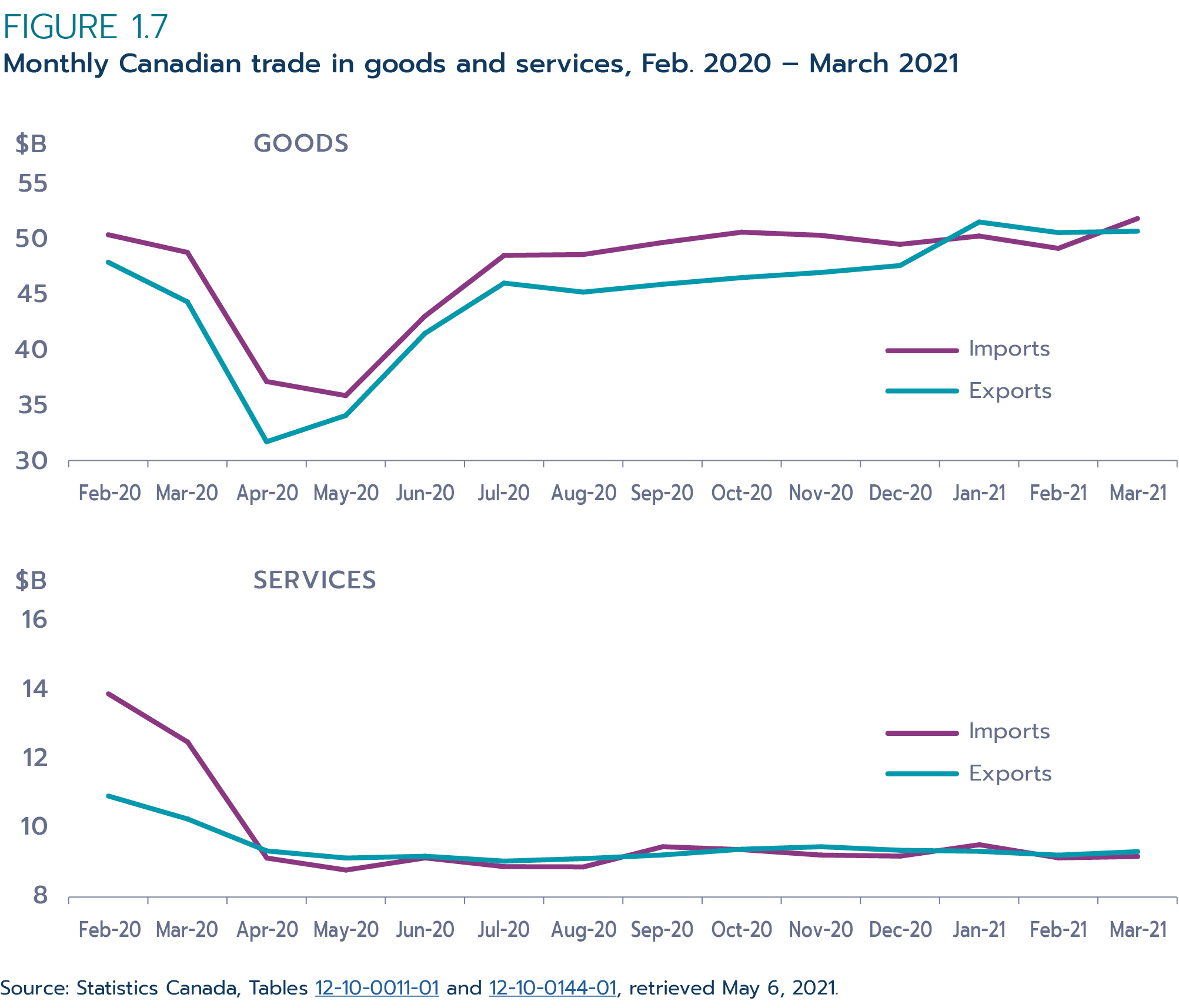
Text version
Figure 1.7: Monthly Canadian trade in goods and services, Feb. 2020 ‑ March 2021
$ Millions
Goods
| Goods exports | Goods imports | |
|---|---|---|
| Feb-20 | 47.8 | 50.3 |
| Mar-20 | 44.2 | 48.7 |
| Apr-20 | 31.6 | 37.1 |
| May-20 | 34.0 | 35.8 |
| Jun-20 | 41.4 | 43.0 |
| Jul-20 | 45.9 | 48.4 |
| Aug-20 | 45.1 | 48.5 |
| Sep-20 | 45.8 | 49.6 |
| Oct-20 | 46.4 | 50.5 |
| Nov-20 | 46.9 | 50.2 |
| Dec-20 | 47.5 | 49.4 |
| Jan-21 | 51.4 | 50.2 |
| Feb-21 | 50.5 | 49.1 |
| Mar-21 | 50.6 | 51.8 |
Services
| Services exports | Services imports | |
|---|---|---|
| Feb-20 | 10.9 | 13.8 |
| Mar-20 | 10.2 | 12.5 |
| Apr-20 | 9.3 | 9.1 |
| May-20 | 9.1 | 8.8 |
| Jun-20 | 9.2 | 9.1 |
| Jul-20 | 9.0 | 8.9 |
| Aug-20 | 9.1 | 8.9 |
| Sep-20 | 9.2 | 9.4 |
| Oct-20 | 9.4 | 9.3 |
| Nov-20 | 9.4 | 9.2 |
| Dec-20 | 9.3 | 9.2 |
| Jan-21 | 9.3 | 9.5 |
| Feb-21 | 9.2 | 9.1 |
| Mar-21 | 9.3 | 9.1 |
Data source: Statistics Canada, Tables 12-10-0011-01 and 12-10-0144-01, retrieved May 6, 2021.
Take-home messages
- The year 2020 was marked by historical challenges to the global economy and trade due to the pandemic. Canada was not spared as it registered its largest annual economic contraction since comparable data were first recorded.
- While Canada's economy saw strong recovery in the second half of 2020, it was not enough to offset the loss in the first half, with many services-producing industries continuing to struggle by the end of the year.
- While the economy was harder hit by the pandemic than by the GFC, Canada's trade and FDI flows declined less because of the pandemic than they did from the GFC.
- International trade was one of the hardest-hit aspects of the Canadian economy. Due mainly to lower bilateral trade with the United States, both Canadian exports and imports suffered double-digit declines.
Chapter 2: FDI as a driver of domestic growth
Over the past 30 years, we have seen tremendous growth in global FDI. The world's economies are becoming increasingly interdependent through the cross-border flow of goods and services, investment, technology, information and people. Many of the largest firms around the world have significantly grown their global footprints with increased sales to foreign markets and investment in those markets through the establishment of foreign affiliates. For many of the world's largest companies, foreign markets account for the majority of their sales, assets and profits (UNCTAD, 2019).
As an open economy, Canada relies on foreign investment and international trade to drive its growth. In fact, the country's dependence on foreign capital and trade has been a characteristic of Canada's economy for most of its history, starting with British investment in the mid-19th century in the country's railways, canals and other public works. The early part of the 20th century saw the growth of investment from the United States in the resource and manufacturing sectors.
FDI in Canada has grown considerably since the 1980s. The stock of FDI was equivalent to 47% of Canada's GDP in 2020—almost 30 percentage points higher than in the late eightiesFootnote 3 (Box 2.1). This growth has led to debates about its impact on the Canadian economy and, more specifically, whether this investment is coming at the cost of jobs at home or, alternatively, helping to support Canadian firms' competitive position as they access new markets and resources. These are important questions, as determining the impact of FDI can have important implications for the design of investment and trade policies to promote economic growth.
Box 2.1: Understanding FDI
Foreign direct investment occurs when an investor in one economy obtains a "lasting interest" in an enterprise resident in another economy. The lasting interest implies that a long-term relationship exists between the investor and the enterprise and that the investor has a significant influence on the way the enterprise is managed. Such an interest is deemed to exist when a direct investor owns 10% or more of the voting power on the board of directors (for an incorporated enterprise) or the equivalent (for an unincorporated enterprise).
FDI statistics are presented as a financial flow (transaction) or stock (position). FDI flows represent activities of foreign investors over a period of time (e.g. in a given year). FDI flow data also include the return on equity and debt in the form of profits and interest income to the direct investor during a specific period of time. FDI flows can be quite volatile (McNaughton, 2021)—just one large deal in a given quarter or year can have a huge impact on the flow figures for that time period. FDI stocks represent the total foreign investment at a point in time—i.e. the cumulative value of investments. FDI stock includes equity and debt (loans between companies).
Total FDI flows, or investments, in a given year impact the total FDI stock or the FDI "position". Furthermore, flows can often be negative, as in the case of divestitures and repatriation of earnings when money flows back to the foreign parent company. Affiliate earnings that are reinvested in the affiliate rather than repatriated count toward FDI flows in a given year.
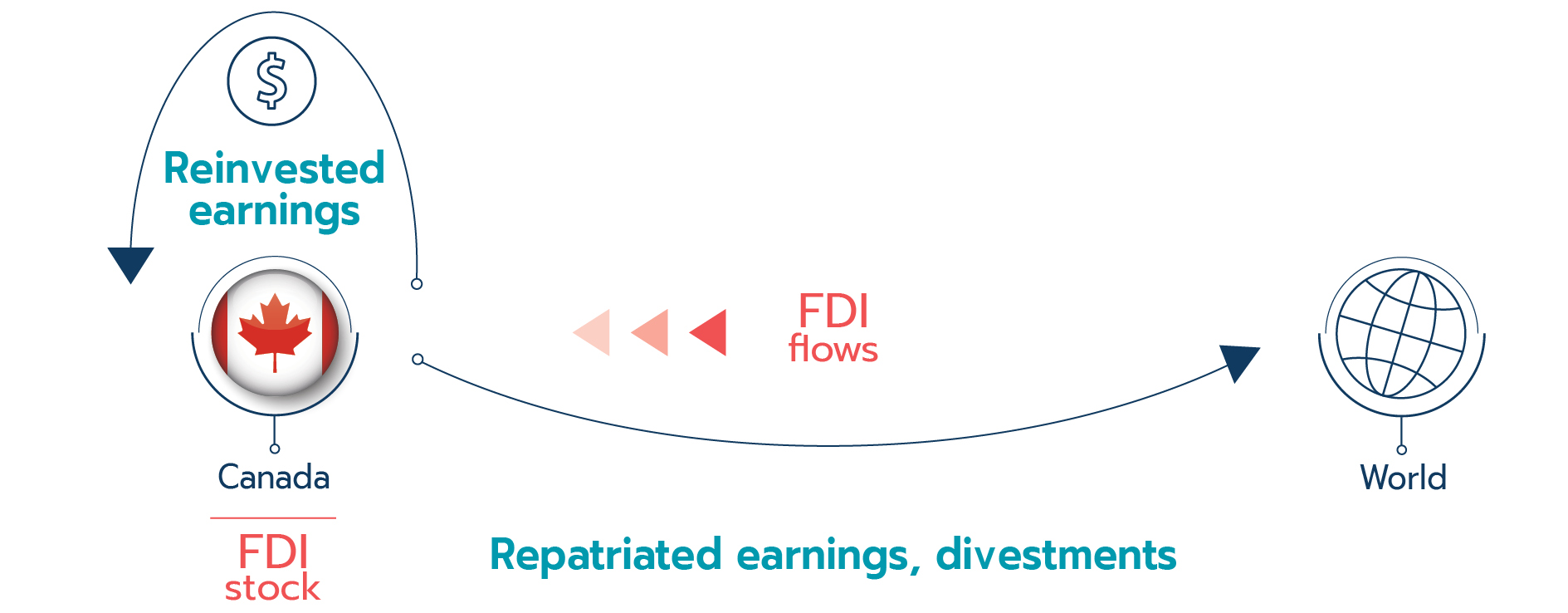
Text version
Total FDI flows, or investments, in a given year impact the total FDI stock or the FDI "position". Furthermore, flows can be negative, as in the case of divestments and repatriation of earnings. In both cases, money flows back out of Canada to the foreign parent company. Reinvested affiliate earnings in the affiliate rather than repatriated count toward FDI flows in a given year.
2.1. Benefits of inward FDI
Evidence from around the world suggests that there are many benefits for host economies that have the appropriate policies, infrastructure and skill base to take advantage of foreign investment.
The Organisation for Economic Co-operation and Development (OECD) summarized the merits of inward FDI as follows:
"Given the appropriate host-country policies and a basic level of development, a preponderance of studies shows that FDI triggers technology spillovers, assists human capital formation, contributes to international trade integration, helps create a more competitive business environment and enhances enterprise development." (OECD, 2002)
In other words, foreign firms or affiliates:
- bring new technology and know-how
- contribute to skills upgrading of local workers
- boost supply chain integration and international trade
- foster competition among domestic firms
This, in turn, can lead to better quality and increased variety in goods and services. Innovation, technology adoption, a highly skilled workforce and increased competition among firms all drive productivity, the key determinant of income per capita, or standard of living, in the long term.
Furthermore, foreign investment provides capital to finance new investments and enhance existing businesses. Between 2007 and 2020, foreign companies injected an average of $53 billion a year into the Canadian economy both through new capital investments as well as through the reinvestment of profits made in Canada. Reinvested earnings, or earnings from foreign affiliates invested back in the Canadian economy rather than repatriated, account for one third of this amount.Footnote 4
The extent to which inward FDI affects a host economy depends on a number of factors including the sector in which the FDI occurs as well as the entry mode: a greenfield investment or a brownfield investment, such as a merger or acquisition (M&A) (Box 2.2). Technology spillovers may be more pronounced with M&As given that companies already have established supply-chain linkages. However, newly established affiliates, or greenfield investments, imply an expansion of the existing capital stock in an economy, thus additional economic activity related to job creation and investment in capital, such as machinery and equipment.
Box 2.2: FDI mode of entry: greenfield versus brownfield
When a company decides to establish new operations in another country or expand its international operations through FDI, this investment can be in the form of either new or existing facilities. These 2 types of investment are usually referred to as greenfield or brownfield investments.
In a greenfield investment, the parent company establishes a subsidiary in another country and constructs new facilities from the ground up. The new facilities may include a production plant, distribution or sale facilities, and office space, depending on the industry. Goods-producing industries require a production plant while service industries may only need office space. There are several reasons why a company may decide to build a new facility rather than purchase or lease an existing one. The primary reason is that a new facility offers design flexibility along with the efficiency to meet the project's needs. If the company wants to advertise its new operation or attract employees, new facilities also tend to be more favorable.
Brownfield investments occur when an enterprise purchases or leases an existing facility to begin new operations or expand existing operations. Companies may consider this approach if they do not want to incur the start-up costs typically associated with greenfield investment and/or their needs can be easily addressed by available vacant spaces. With this type of investment, a company will typically either invest in existing facilities and infrastructure through leasing or acquiring existing vacant facilities in a foreign country or a merger and acquisition (M&A) deal.
Some of the advantages of this type of investment may include:
- the ability to quickly gain access to a new foreign market
- lower start-up costs due to the facilities already having been established
- existing approvals and licences from governments or regulators
Greenfield investment is of particular interest to researchers and policy-makers, but at present the official statistics do not report this type of FDI separately. Currently, there are no internationally agreed upon definitions of greenfield FDI, and it is challenging to precisely distinguish greenfield investments from expansion investments, which extend the capacity of existing businesses (IMF, 2021). In Canada, official FDI data on greenfield investments are currently included in the "other flows" category in Statistics Canada's quarterly FDI series. However, the "other flows" category also includes debt transactions between parent companies and their subsidiaries as well as flows that may be related to financial restructuring of the greenfield.
In May 2021, Statistics Canada released a new data table, Table 36-10-0656-01, that provides direct investment flows on a gross and net basis. These data were made available in an effort to further define the nature of FDI in Canada. Data can be disaggregated according to 2 industry groupings (goods and services producing industries).
Studies of the impact of FDI in Canada demonstrate the positive relationship between foreign investment and productivity. Multinational firms are more productive than purely domestic firms (Rao and Tang, 2005; Baldwin and Gu, 2005; Tang and Wang, 2020). There is strong evidence for productivity spillovers from foreign plants to domestic ones as a result of increased competition and greater use of new technologies among the domestic firms. FDI has resulted in inter-industry productivity spillovers in Canadian manufacturing industries, via both upstream and downstream production linkages (Wang and Gu, 2006). One study (Baldwin and Gu, 2005) estimates that foreign firms accounted for over two thirds of labour productivity growth in Canada's manufacturing sector in the 1980s and 1990s.
There is also evidence that foreign-controlled firms pay higher wages than domestic firms (Breau and Brown, 2011), even taking differences in plant and worker characteristics into account. FDI also contributes significantly to skills upgrading in both service and non-service industries (Souare and Zhou, 2014). A more recent report (Rao and Zhing, 2018) found that a 10% increase in Canada's inward FDI stock would have a strong positive impact on the economy by bolstering capital investment (3.1% increase in investment in construction and 1.3% increase in machinery and equipment investment), increasing R&D spending (1.7% increase), and raising the share of university-educated workers (0.4% increase).
Foreign businesses foster innovation by bringing new technologies and services to the Canadian market and investing in research and development (R&D) (Box 2.3). Business R&D is important to innovation performance. Foreign multinationals account for 41% of intramural R&D expenditures,Footnote 5 employ over one third of R&D personnel and are responsible for the majority of exports and imports of technological services in Canada's corporate sector (Figure 2.1).
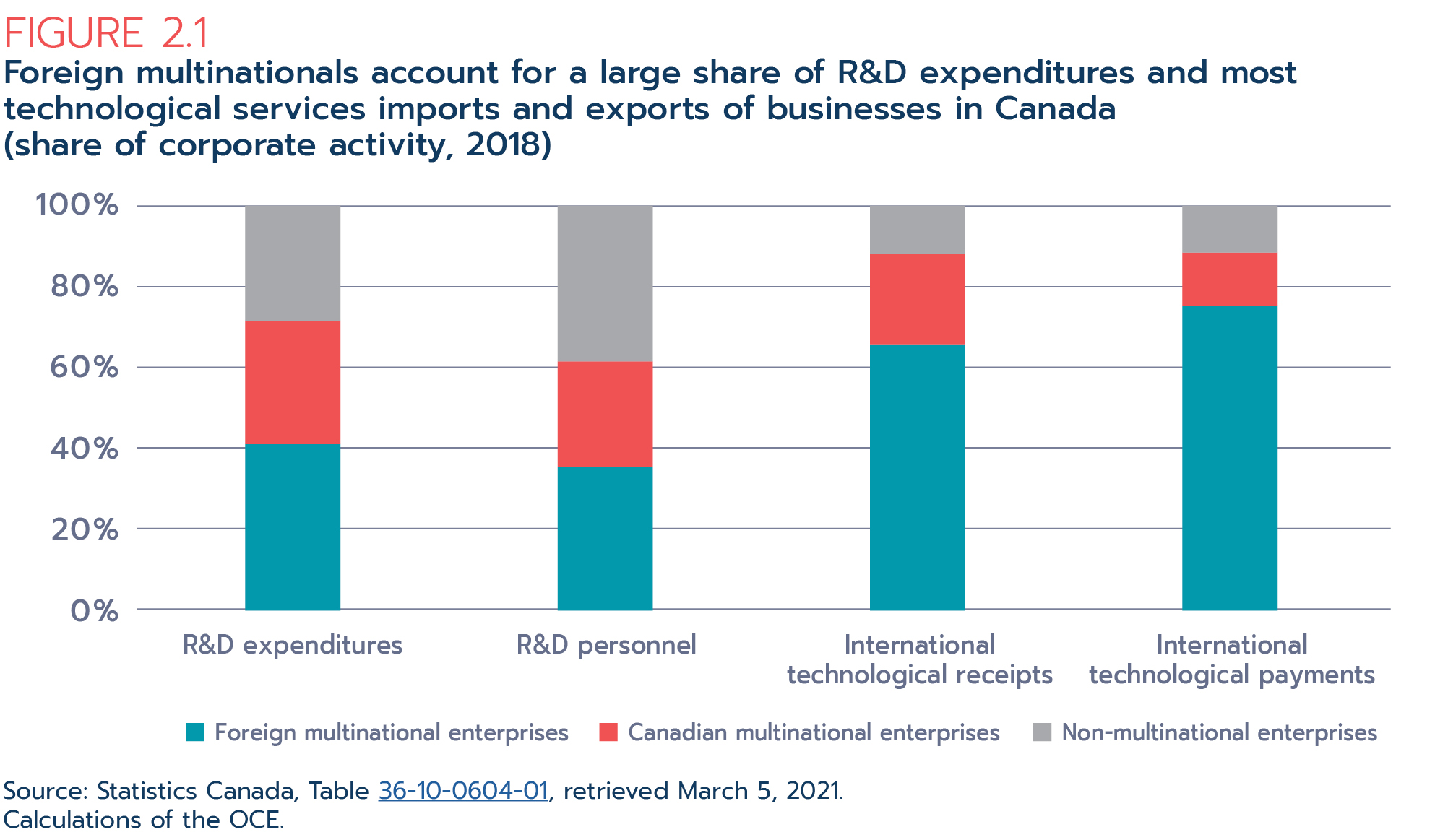
Text version
Figure 2.1: Foreign multinationals account for a large share of R&D expenditures and most technological services imports and exports of businesses in Canada
(share of corporate activity, 2018)
| Foreign multinational enterprises | Canadian multinational enterprises | Non-multinational enterprises | |
|---|---|---|---|
| R&D expenditures | 41% | 30% | 28% |
| R&D personnel | 35% | 26% | 38% |
| International technological receipts | 66% | 23% | 12% |
| International technological payments | 76% | 13% | 11% |
Source: Statistics Canada, Table 36-10-0604-01, retrieved March 5, 2021.
Calculations of the OCE.
Box 2.3: Building an innovation ecosystem—foreign multinationals invest in R&D centres in Canada
Foreign multinationals are important contributors to R&D spending and job creation in Canada. Last year, important FDI deals were announced that will create hundreds of jobs and boost Canada's R&D spending in key areas going forward, such as cybersecurity and artificial intelligence (AI).
In early 2020, Mastercard announced a new Can$510-million cybersecurity and tech innovation centre in Vancouver, B.C. Mastercard Inc., based in Purchase, New York, is the second-largest payment processor in the world. Its new R&D centre in B.C. will focus on product development in cybersecurity, artificial intelligence and internet of things technologies to improve the security of its payments network. The centre is expected to create 380 new jobs by 2029 and through a partnership with universities, government and businesses will also include 100 new co-op positions. Mastercard will also increase the number of jobs at NuData Security, a Vancouver tech company acquired in 2017, by about 100 positions, including software engineers, data scientists and information security experts. This centre will help in tackling cybercrime, establishing Canada as a world leader in cybersecurity.
BusPatrol is a U.S.-based startup that specializes in transportation safety technology. The company equips school buses with safety hardware and software to record dangerous driving by other vehicles, such as illegally passing stopped school buses. BusPatrol uses their AI-integrated technology to contribute to public safety. In August 2020, the company opened a technological development centre in Montréal that is expected to create 150 jobs by 2022.
FDI fuels investment in machinery and equipment, a key driver of labour productivity growth. Foreign multinational enterprises (FMNEs) are significant contributors to machinery and equipment (M&E) investment in Canada. In 2018, they accounted for almost 30% of M&E investment in the corporate sector and were responsible for more than 70% of all Canadian M&E imports.Footnote 6 Looking at the composition of capital investment over the past few years reveals a shift from more spending on non-residential construction to machinery and equipment spending. In 2015, FMNEs allocated half of their investment to non-residential construction and one third to machinery and equipment. In 2018, non-residential construction investment had fallen to just under 40% while M&E investment grew to 43% of the total (Figure 2.2).
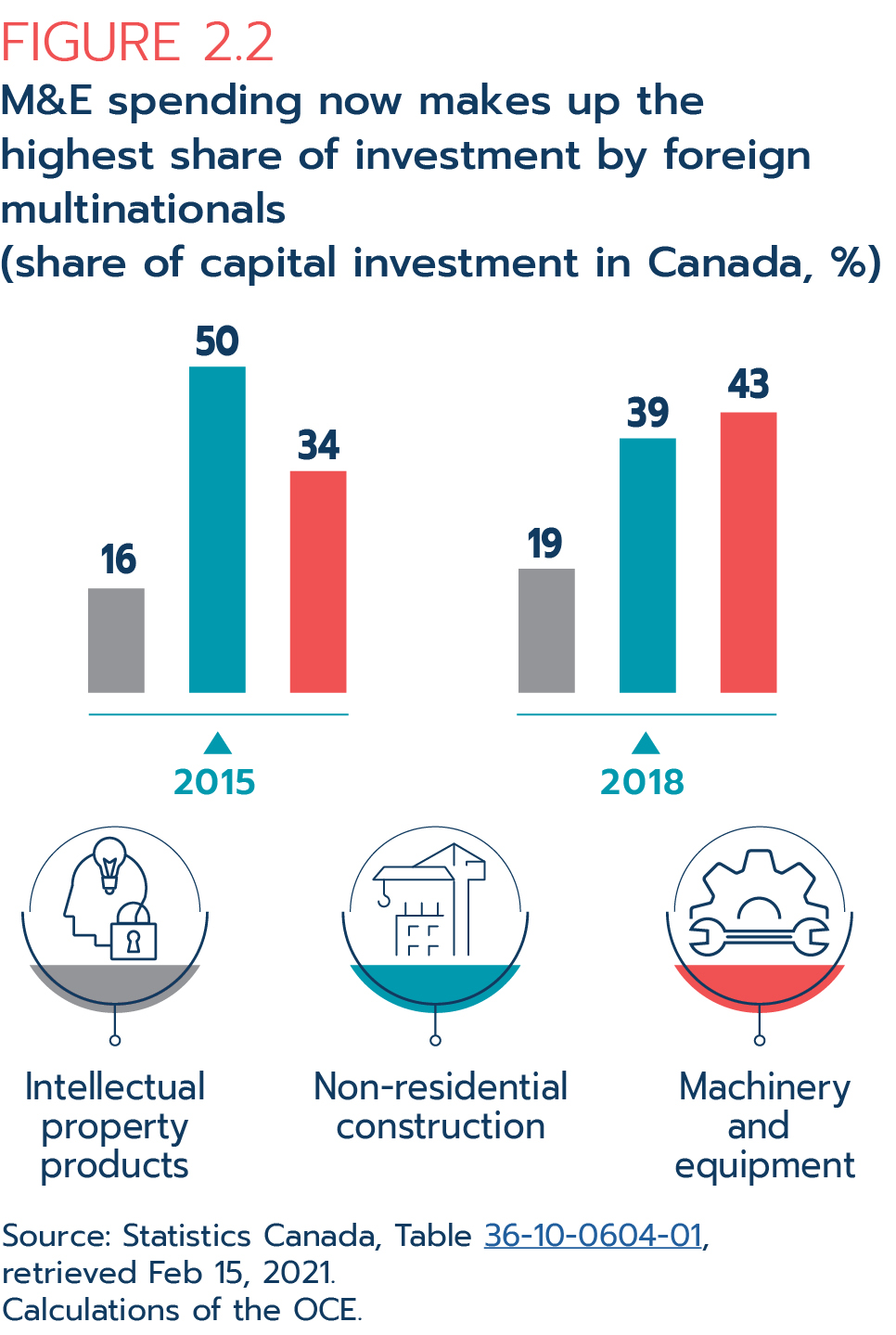
Text version
Figure 2.2: M&E spending now makes up the highest share of investment by foreign multinationals
(share of capital investment in Canada, %)
| 2015 | 2016 | 2017 | 2018 | |
|---|---|---|---|---|
| Intellectual property products | 16 | 15 | 19 | 19 |
| Non-residential construction | 50 | 47 | 37 | 39 |
| Machinery and equipment | 34 | 38 | 44 | 43 |
Source: Statistics Canada, Table 36-10-0604-01, retrieved Feb 15, 2021.
Calculations of the OCE.
Foreign businesses are vital to a number of industries in Canada, accounting for one third of all employment in the manufacturing, and mining, oil and gas extraction sectors and over half of the operating revenues in the manufacturing sector (Figure 2.3). Within the 21 manufacturing sub-sectors, foreign-owned firms account for the majority of activity (jobs, revenues, value added) in 6 of the sub-sectors: transportation equipment, paper, chemical, primary metal, electrical equipment and appliances, and beverage and tobacco manufacturing.
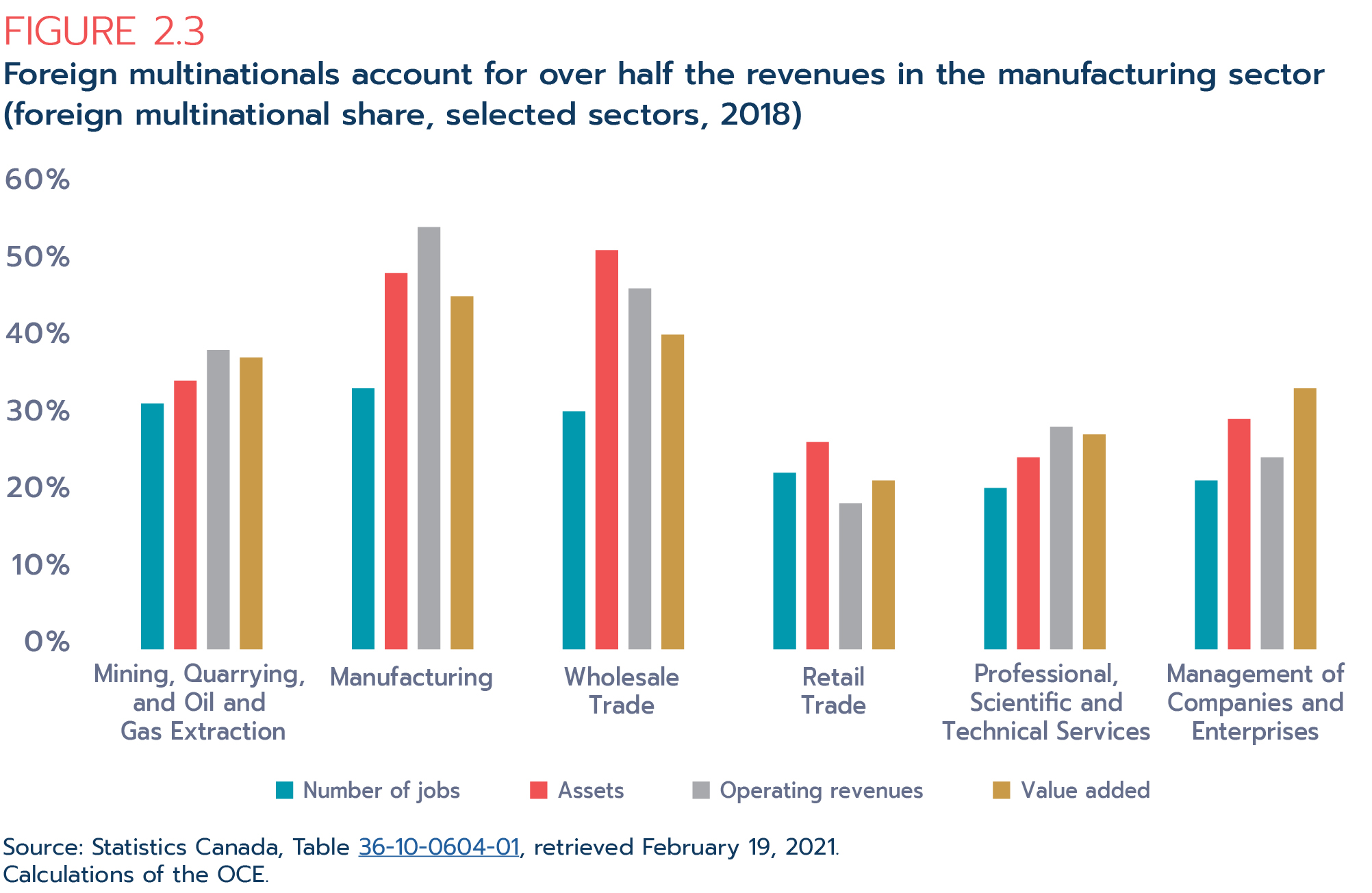
Text version
Figure 2.3: Foreign multinationals account for over half the revenues in the manufacturing sector
Foreign mulitnationals share of corp sector 2018
| Industry | Jobs | Assets | Operating revenues | Value added |
|---|---|---|---|---|
| Mining, Quarrying, and Oil and Gas Extraction | 32% | 35% | 39% | 38% |
| Manufacturing | 34% | 49% | 55% | 46% |
| Wholesale Trade | 31% | 52% | 47% | 41% |
| Retail Trade | 23% | 27% | 19% | 22% |
| Professional, Scientific and Technical Services | 21% | 25% | 29% | 28% |
| Management of Companies and Enterprises | 22% | 30% | 25% | 34% |
Source: Statistics Canada, Table 36-10-0604-01, retrieved February 19, 2021.
Calculations of the OCE.
Looking at FDI in Canada more broadly, it is evident that foreign multinationals are critical to the entire economy, accounting for 12% of all employment, 15% of Canadian GDP as well as the majority of the country's trade in goods and commercial services (Figure 2.4). Given the importance of global value chains, much of world trade now happens between firms and industries. FDI is crucial to trade integration (Box 2.4).
Although both foreign and Canadian multinationals are significant players in the economy, they account for only 1% of enterprises in the corporate sector (i.e. excluding the non-profit and governmental sectors). As of 2018, there were around 16,256 FMNEs operating in Canada and 11,490 Canadian multinationals compared to 2.7 million non-multinational enterprises ( i.e. Canadian firms only operating in Canada).Footnote 7
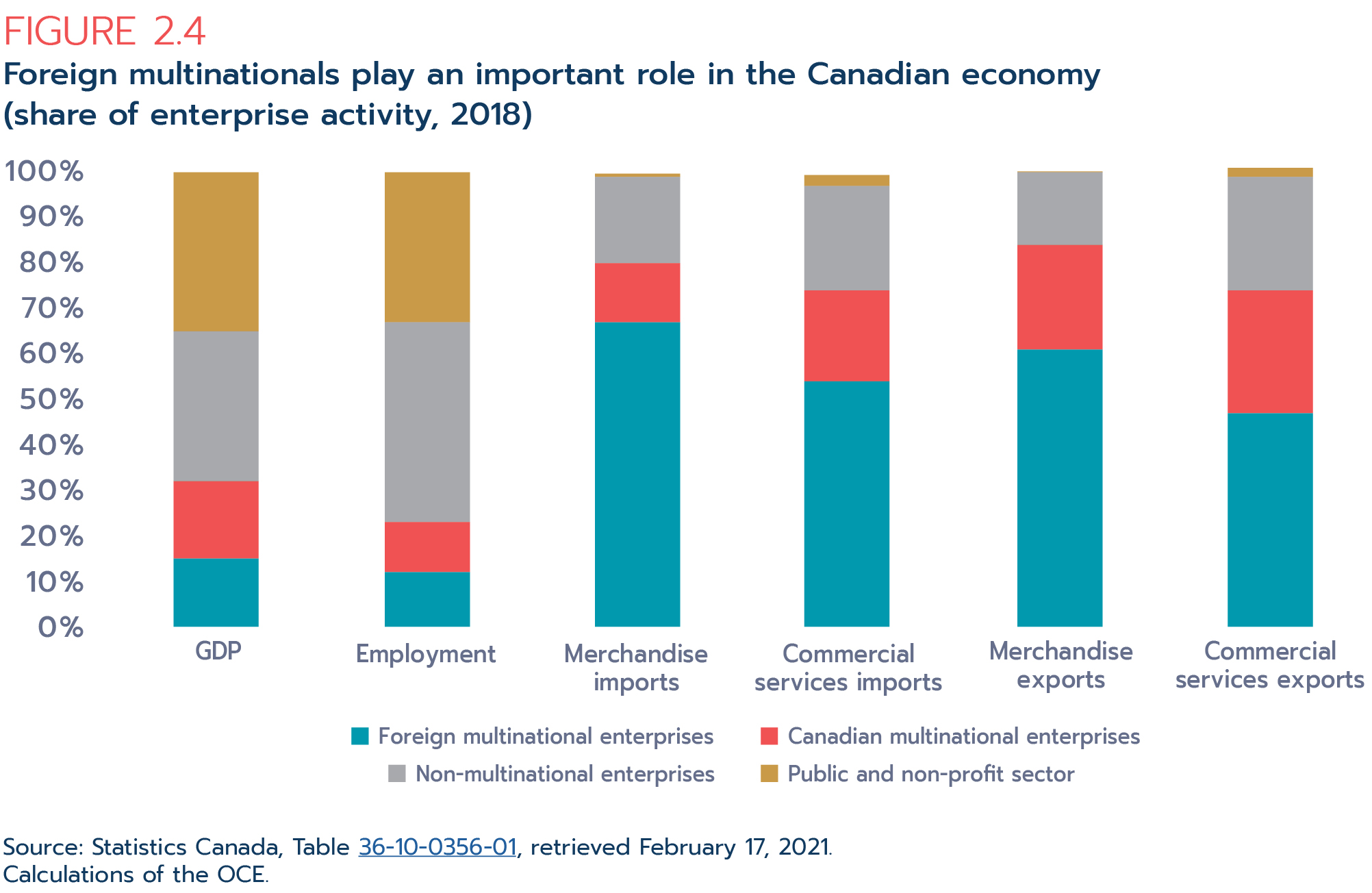
Text version
Figure 2.4: Foreign multinationals play an important role in the Canadian economy
(share of enterprise activity, 2018)
| Foreign multinational enterprises | Canadian multinational enterprises | Non-multinational enterprises | Public and non-profit sector | |
|---|---|---|---|---|
| GDP | 15% | 17% | 33% | 35% |
| Employment | 12% | 11% | 44% | 33% |
| Merchandise imports | 67% | 13% | 19% | 0.7% |
| Commercial services imports | 54% | 20% | 23% | 2.4% |
| Merchandise exports | 61% | 23% | 16% | 0.2% |
| Commercial services exports | 47% | 27% | 25% | 2.0% |
Source: Statistics Canada, Table 36-10-0356-01, retrieved February 17, 2021.
Calculations of the OCE.
There are also tax revenue benefits associated with FDI. FDI generates tax revenues for host economies directly through taxes paid by foreign enterprises. It can also generate revenues indirectly through higher income taxes and sales taxes resulting from higher wages and increased consumer spending. Moreover, FDI has the potential to ultimately benefit well-being and quality of life in an economy. The accompanying economic growth and tax revenues allow regions to invest more in social programs and priority areas such as health, education, climate change, and infrastructure.
Box 2.4: The automotive industry's transition toward zero emissions
Canada's manufacturing and resource sectors are set to play a big role in the auto industry's shift toward electric vehicles. Car manufacturers are committed to building electric vehicles in Canada, with 3 global automakers having made huge FDI announcements in 2020. In September 2020, Ford Motor Co. announced that it would be investing US$1.8 billion to start producing 5 battery-powered models at its Oakville, Ontario, factory. Also, last fall, Fiat Chrysler committed to investing up to US$1.5 billion at its Windsor, Ontario, plant to assemble plug-in hybrids and battery-powered vehicles. This investment will add up to 2,000 new jobs. And, General Motors Co. announced in early 2020 that it would be investing US$1 billion to produce electric commercial vans in Ingersoll, Ontario.
With Canada's growth in electric vehicle manufacturing, and its abundance of natural resources, the country is also well-positioned to become a leader in the electric vehicle supply chain. Minerals like lithium, cobalt, nickel, and aluminum are key in the production of electric vehicle batteries. So, with domestic production of these vehicles, Canada has a ready market for both its natural resource producers and its auto parts manufacturers that specialize in electric vehicle components such as electric batteries.
2.2. Canada's FDI make-up
Advanced economies are the predominant source of Canada's foreign capital. Canada is in a unique position having the United States, the world's largest economy, as its neighbour. The U.S. is the source of most of Canada's stock of inward FDI, though its share has fallen over the years. Until 1970, the U.S. held over four fifths of Canada's inward FDI stock. This share fell to two thirds by the late 1980s, then dropped below one half in 2012 and has been gradually declining ever since (in 2020, it stood at 44%). Canada's inward FDI sources are now more geographically diverse—40% of Canada's FDI stock comes from Europe, and one tenth comes from Asia and Oceania, led by Japan, China and Hong Kong (Figure 2.5).
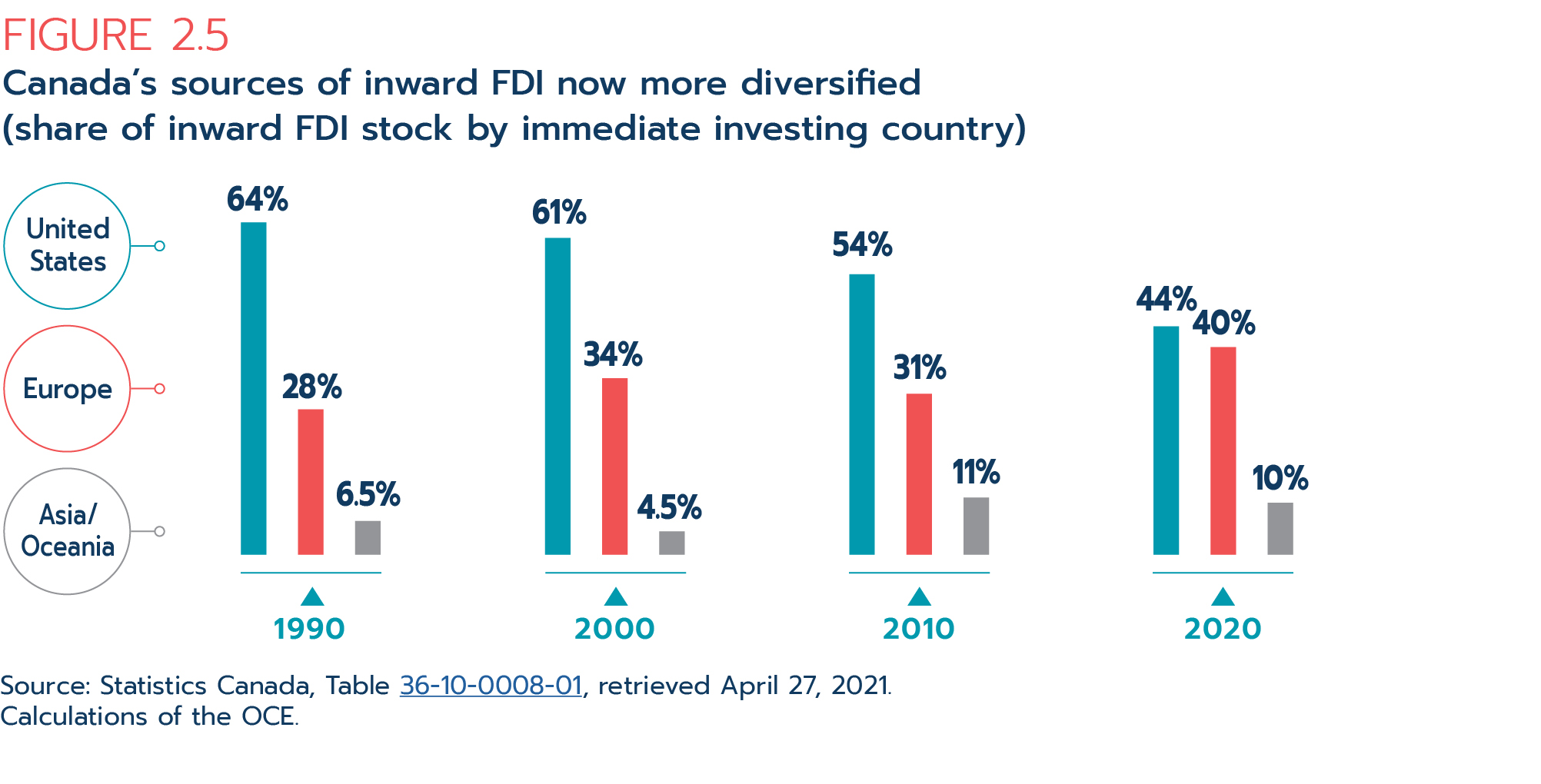
Text version
Figure 2.5: Canada's sources of inward FDI now more diversified
(share of inward FDI stock by immediate investing country)
| 1990 | 2000 | 2010 | 2020 | |
|---|---|---|---|---|
| United States | 64% | 61% | 54% | 44% |
| Europe | 28% | 34% | 31% | 40% |
| Asia/Oceania | 6.5% | 4.5% | 11% | 10% |
Source: Statistics Canada, Table 36-10-0008-01, retrieved April 27, 2021.
Calculations of the OCE.
Statistics on FDI sources are typically reported according to the immediate investing country (IIC), which is the location of the last investor before the funds reach the domestic economy. Given that the ownership structures of multinationals are often complex, with FDI being channeled through different countries before reaching its final destination, IIC data may not reveal information on the country that actually controls the funding. Looking at FDI source data by ultimate investing country (UIC) allows us to see which investor countries ultimately control the FDI enterprise (Box 2.5).
Examining FDI stock data on a UIC basis reveals notable increases in Canada's stock of direct investment from a number of countries. The U.S. share rises from $457 billion in 2020 on an immediate basis to $523 billion on an ultimate basis, an increase of 14%, while Germany's figure almost doubles from $18 billion to $34 billion. Japan, China, Ireland, Brazil and France also have higher investment when measured on an ultimate investor basis.
Economies with substantially less investment on an ultimate basis include the Netherlands, Luxembourg and Switzerland. The Netherlands is the source of Canada's second-highest share of FDI stock by immediate investing country, making up 14% in 2020. However, UIC data reveal that the Netherlands only accounts for 3.0% of Canada's total inward FDI stock on an ultimate basis (Table 2.1). The Netherlands is a recognized financial centre through which FDI is channeled.
Table 2.1: Measuring stock using IIC or UIC affects FDI ranking
| Ranking | UIC | IIC | Difference between UIC and IIC | |||||
|---|---|---|---|---|---|---|---|---|
| UIC | IIC | billions $ | share (%) | billions $ | share(%) | billions $ | share (percentage points) | |
| 1 | 1 | United States | 523 | 50 | 457 | 44 | 66 | 6.3 |
| 2 | 3 | United Kingdom | 64 | 6.1 | 70 | 6.7 | -6.0 | -0.6 |
| 3 | 6 | Japan | 48 | 4.6 | 33 | 3.1 | 15 | 1.4 |
| 4 | 10 | Germany | 34 | 3.3 | 18 | 1.7 | 16 | 1.6 |
| 5 | 5 | Switzerland | 34 | 3.2 | 51 | 4.8 | -17 | -1.6 |
| 6 | 7 | China | 32 | 3.1 | 24 | 2.3 | 7.7 | 0.7 |
| 7 | 2 | Netherlands | 31 | 3.0 | 148 | 14 | -117 | -11 |
| 8 | 13 | Ireland | 25 | 2.4 | 18 | 1.7 | 7.1 | 0.7 |
| 9 | 14 | Brazil | 24 | 2.3 | 15 | 1.5 | 8.9 | 0.9 |
| 10 | 12 | France | 24 | 2.3 | 18 | 1.7 | 6.2 | 0.6 |
| 11 | 4 | Luxembourg | 19 | 1.8 | 57 | 5.5 | -39 | -3.7 |
| 12 | 11 | Australia | 17 | 1.7 | 18 | 1.7 | -0.3 | 0.0 |
| 13 | 8 | Hong Kong | 17 | 1.6 | 22 | 2.1 | -5.3 | -0.5 |
| 14 | 15 | Spain | 14 | 1.3 | 13 | 1.3 | 0.3 | 0.0 |
| 15 | 28 | United Arab Emirates | 8.3 | 0.8 | 1.7 | 0.2 | 6.6 | 0.6 |
Note: Highlighted economies have lower FDI stock as measured by UIC compared to IIC.
Source: Statistics Canada, Table 36-10-0008-01, Table 36-10-0433-01, retrieved April 27, 2021.
Box 2.5: Making the decisions and bearing the risk—the ultimate investor
Multinational enterprises often channel their FDI through intermediary countries via "special purpose entities" (SPEs) such as holding companies. Standard FDI data capture the location of the intermediary country, or the "immediate investor." As a result, the FDI is attributed to the country of the holding company rather than that of the "ultimate investor." To provide more meaningful measures of FDI, countries began to compile statistics on the inward FDI stock by the UIC. These data provide information on who ultimately controls the investment and, thus, bears the risks and reaps the rewards.
As a simple example, suppose a Japanese company, Firm A, invests in Canada through Firm B, a holding company in the Netherlands. The company in the Netherlands is the immediate investor, and the enterprise in Japan is the ultimate investor. The firm in Japan is the one making the decisions and assuming the risk. Furthermore, a shock to the Japanese economy could impact Firm C, the Canadian affiliate. Standard FDI statistics would not reveal this risk exposure to the Canadian affiliate. UIC data give a better sense of international risk.
Reasons why an investor may decide to make its investment transit through an intermediary country include:
1) to finance an investment by using revenues from an affiliate in another country
2)to finance the investment using an international financial institution located in another country
3) for fiscal reasons (e.g. tax minimization)
There are currently 38 countries (including Canada) that publish inward FDI statistics by UIC. In general, UIC data on inward FDI reveal that countries such as the Netherlands and Luxembourg, which multinationals often use to channel their investments, are less important sources of FDI, relative to other countries like the United States.

Text version
This is an illustration of the concepts of immediate versus ultimate investing country. A Japanese company, Firm A, invests in Canada through Firm B, a holding company in the Netherlands. The company in the Netherlands is the immediate investor, and the company in Japan is the ultimate investor.
Most of the foreign capital is invested in 3 key sectors, which each hold roughly one fifth of the share of Canada's FDI stock: manufacturing; mining and oil and gas extraction; and management of companies and enterprises (Figure 2.6). The share of FDI stock in Canada's manufacturing industry has fallen over the past 20 years. In 2000, the manufacturing industry held 44% of FDI stock in Canada and in 2020 this share was 19%. Meanwhile, the total shares attributed to the mining and oil and gas extraction and management of companies and enterprises sectors have grown by the same amount that the manufacturing share has fallen. The share of FDI stock in management of companies and enterprises increased by 16 percentage points over the past 2 decades (Box 2.6).
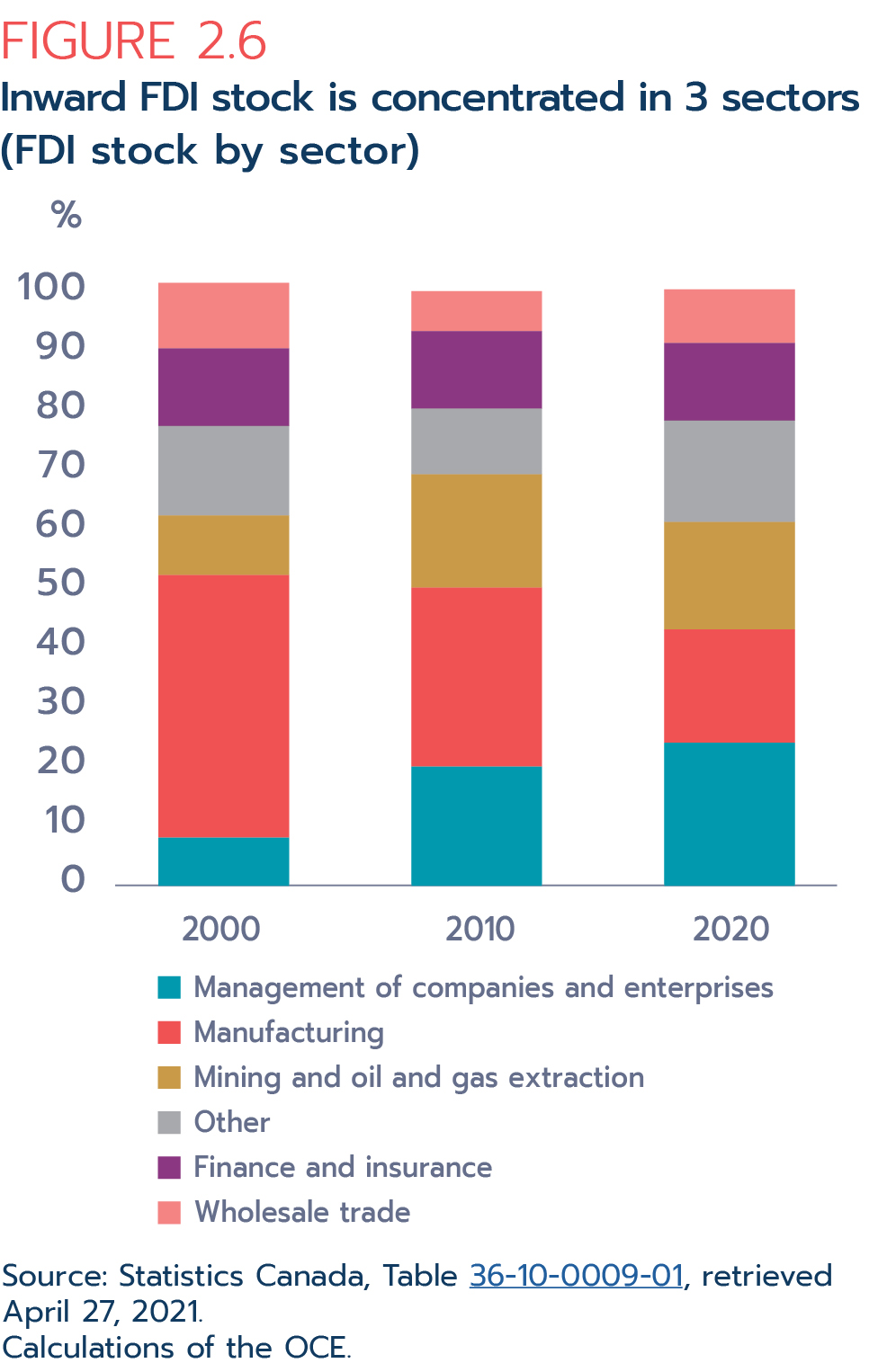
Text version
Figure 2.6: Inward FDI stock is concentrated in three sectors
(FDI stock by sector)
| 2000 | 2010 | 2020 | |
|---|---|---|---|
| Management of companies and enterprises | 8.1% | 20% | 24% |
| Manufacturing | 44% | 30% | 19% |
| Mining and oil and gas extraction | 10% | 19% | 18% |
| Other | 15% | 11% | 17% |
| Finance and insurance | 13% | 13% | 13% |
| Wholesale trade | 11% | 6.7% | 9.0% |
Source: Statistics Canada, Table 36-10-0009-01, retrieved April 27, 2021.
Calculations of the OCE.
Box 2.6: What explains Canada's large share of FDI stock in the management of companies and enterprises industry?
One area of interest with respect to inward investment in Canada is the growing share of the management of companies and enterprises industry (NAICS 55) in overall investment.
As of 2020, $255 billion of inward investment in Canada was classified to the management of companies and enterprises category, which represents an almost 10-fold increase from $26 billion in 2000. As a result, this industry now accounts for 24% of the total investment position in Canada, the highest share among all industries, including manufacturing, and mining and oil and gas extraction.
This industry classification consists of enterprises that are "primarily engaged in: managing companies and enterprises and/or holding the securities or financial assets of companies and enterprises, for the purpose of owning a controlling interest in them and/or influencing their management decisions" (ISED). Businesses classified under this code include head offices and special purpose entities (SPEs), such as holding companies. SPEs are set up specifically to channel investment through an intermediary country and have little in the way of physical presence or activity in the host country. For some countries, SPEs account for a significant portion of inward investment.
Statistics Canada, however, estimates that investment in SPEs is marginal in Canada. One possible scenario is that funding arrives at a head office or a holding company but is ultimately redistributed to related enterprises or enterprise groups within the organizational structure that are associated with other industries such as mining, oil and gas extraction, and manufacturing. Since Statistics Canada surveys the enterprise receiving the funds, i.e. the head office or holding company, the investment is coded to NAICS 55 rather than the industry that is the "end user" of the funds. More analysis needs to be done to investigate the direct investment relationships of enterprises coded to NAICS 55.
Looking at sectoral FDI by geographical origin reveals some interesting facts (Table 2.2):
- the majority of U.S. FDI is divided almost evenly among 3 industries: mining and oil and gas extraction; manufacturing; and the management of companies and enterprises
- nearly half of overall FDI from Asia/Oceania is in the mining and oil and gas extraction sector
- Asia/Oceania account for almost 40% of FDI in the accommodation and food services industry and just under a quarter in mining and oil and gas extraction
- over half of FDI in wholesale trade is of European origin, while virtually all of FDI in retail trade comes from the U.S.
- European investors also hold over half of all foreign capital in the construction, information and cultural, transportation and warehousing, and management of companies and enterprises industries
Table 2.2: Taking a closer look at Canada's FDI stock
(FDI stock by industry and region, 2020)
| Total, all countries | United States | Asia and Oceania | Europe | |||||
|---|---|---|---|---|---|---|---|---|
| billions $ | industry share (%) | billions $ | share of industry total (%) | billions $ | share of industry total (%) | billions $ | share of industry total (%) | |
| Total, all industries | 1,046 | 100 | 457 | 44 | 106 | 10 | 419 | 40 |
| Agriculture,forestry, fishing and hunting | 3.4 | 0.3 | 3.1 | 93 | .. | .. | 0.3 | 7.5 |
| Mining and oil and gas extraction | 187 | 18 | 88 | 47 | 44 | 24 | 45 | 24 |
| Utilities | 11 | 1.0 | 6.4 | 60 | 1.5 | 14 | 2.7 | 26 |
| Construction | 6.4 | 0.6 | 2.7 | 42 | .. | .. | 3.7 | 58 |
| Manufacturing | 199 | 19 | 82 | 41 | 14 | 7.2 | 82 | 41 |
| Wholesale trade | 95 | 9.0 | 37 | 40 | 6.3 | 6.6 | 51 | 54 |
| Retail trade | 53 | 5.0 | 50 | 94 | 0.6 | 1.2 | 2.2 | 4.1 |
| Transportation and warehousing | 15 | 1.4 | 6.3 | 42 | 0.6 | 3.9 | 8.1 | 54 |
| Information and cultural industries | 16 | 1.5 | 5.9 | 37 | 0.1 | 0.5 | 9.1 | 57 |
| Finance and insurance | 131 | 13 | 61 | 46 | 14 | 11 | 50 | 38 |
| Real estate and rental and leasing | 22 | 2.1 | 10 | 47 | 0.1 | 0.3 | 4.1 | 19 |
| Professional, scientific and technical services | 37 | 3.5 | 16 | 44 | 1.1 | 3.0 | 18 | 50 |
| Management of companies and enterprises | 255 | 24 | 79 | 31 | 20 | 7.9 | 136 | 54 |
| Accommodation and food services | 7.3 | 0.7 | 2.8 | 39 | 2.8 | 38 | 1.7 | 23 |
| All other industries | 9.3 | 0.9 | 5.5 | 60 | 0.2 | 2.5 | 3.5 | 38 |
Source: Statistics Canada, Table 36-10-0009-01, retrieved April 27, 2021.
Calculations of the OCE.
It is important to keep in mind that these figures showing the industry investment by region represent FDI stock by immediate investor countries, so investment by countries in some industries may be over- or understated. For example, if Asian investment in the Canadian mining and oil and gas extraction sector is channeled through European holding companies, this sector's share of FDI stock from Asia and Oceania may be greater than 24%.
2.3. Getting the balance right—weighing the benefits and risks of FDI
Foreign direct investment clearly plays a very important role in the Canadian economy; the benefits of such investment must be understood in the context of Canadian interest. The Investment Canada Act (ICA or "the Act") is Canada's primary mechanism for reviewing foreign investments, with a 2-fold purpose, as set out in the Act:
- "[…] to provide for the review of significant investments in Canada by non-Canadians in a manner that encourages investment, economic growth and employment opportunities in Canada", and
- "to provide for the review of investments in Canada by non-Canadians that could be injurious to national security".
Foreign investors acquiring control of an existing Canadian business or establishing a new Canadian business must file either an application for "net benefit" review for a significant acquisition or a notification advising the Canadian government of a pending or completed transaction. In addition, all investments by non-Canadians into Canada are subject to the national security review process, including all acquisitions, in part or in full, of a Canadian business or entity and greenfield investments.
Significant transactions are determined based on the value of the Canadian business being acquired. The net benefit review threshold for direct acquisitions of control of Canadian businesses by private investors from WTO-member countries increased from $600 million in enterprise value to $1 billion in 2017. In addition, a free trade partner threshold was introduced in September 2017 following the implementation of CETA. As of 2021, the thresholds are $1.043 billion in enterprise value for private investors from WTO-member countries and $1.565 billion in enterprise value for private investors from free trade partner countries (Figure 2.7).Footnote 8 State-owned enterprise investors from WTO-member countries continue to face a lower threshold, $415 million in asset value, for 2021. The threshold levels are adjusted annually based on changes in nominal GDP. This yearly adjustment led to a slight decrease in the thresholds for 2021 given COVID-19's negative impact on the economy and GDP in 2020. Details on the number of notifications and filings are found in the Act's Annual Report.
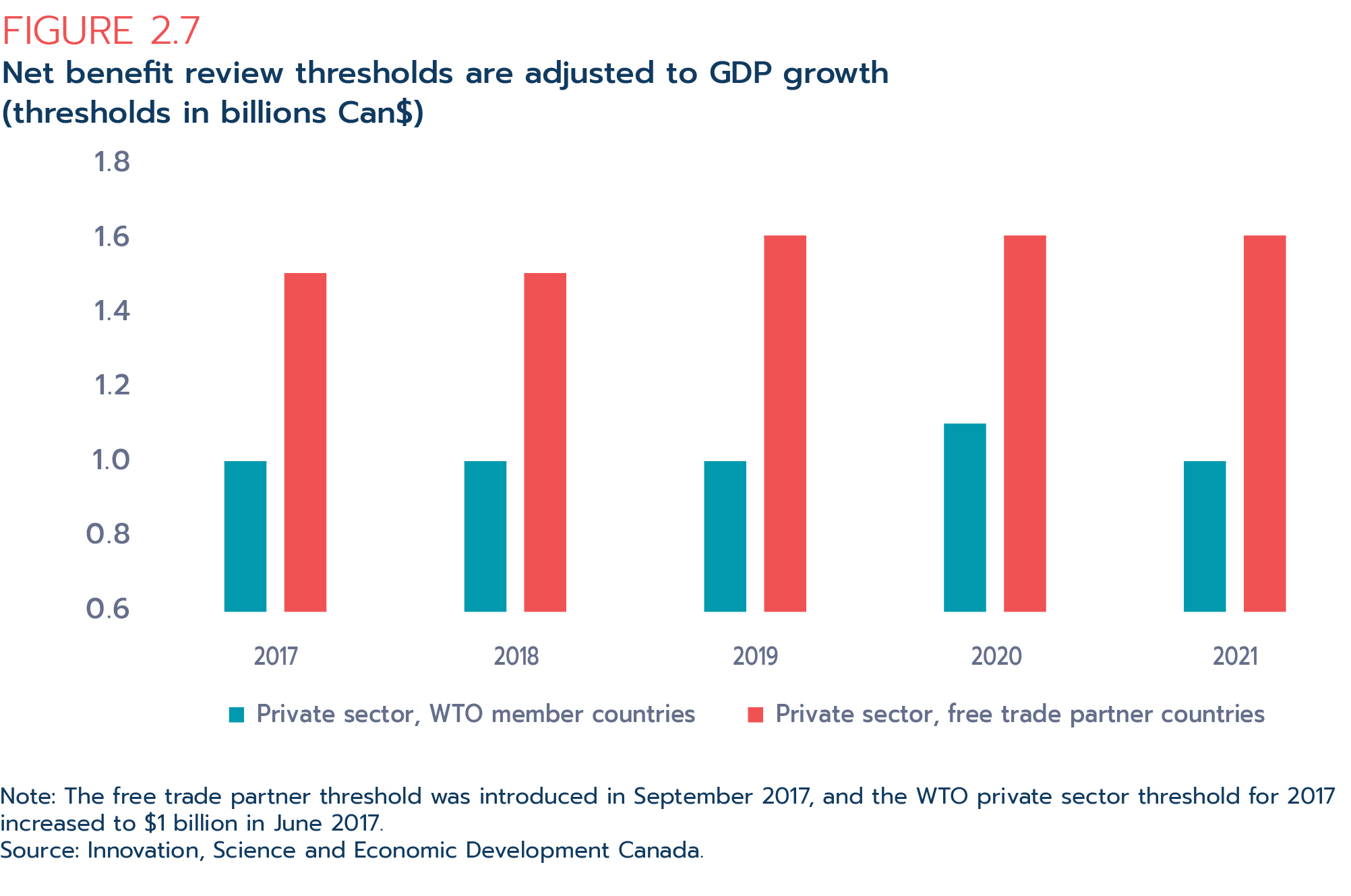
Text version
Figure 2.7: Net benefit review thresholds are adjusted to GDP growth
(thresholds in billions Can$)
| 2017 | 2018 | 2019 | 2020 | 2021 | |
|---|---|---|---|---|---|
| Private sector, WTO member countries | 1.0 | 1.0 | 1.0 | 1.1 | 1.0 |
| Private sector, free trade partner countries | 1.5 | 1.5 | 1.6 | 1.6 | 1.6 |
Note: The free trade partner threshold was introduced in September 2017, and the WTO private sector threshold for 2017 increased to $1 billion in June 2017.
Source: Innovation, Science and Economic Development Canada.
Before an investment can proceed, a determination of overall net benefit is required.Footnote 9 The factors used in making this determination are set out in the Act (section 20):
a) the effect on the level of economic activity in Canada on: employment, resource processing, and the utilization of parts, components and services produced in Canada, and exports from Canada;
b) the degree and significance of participation by Canadians in the Canadian business or new Canadian business and in any industry or industries in Canada;
c) the effect of the investment on productivity, industrial efficiency, technological development, product innovation, and product variety in Canada;
d) the effect of the investment on competition within any industry in Canada;
e) the compatibility of the investment with national industrial, economic, and cultural policies; and
f) the contribution of the investment to Canada's ability to compete in world markets.
In essence, the net benefit review seeks to determine if the investment will benefit Canadians and whether it will contribute to Canada's innovation, competitiveness and productivity growth.
The Act does not assign set weights to the factors nor does it indicate whether any factor is more important than another in the net benefit determination. Furthermore, not all factors may be relevant to a specific investment and some factors may be more relevant to one investment than to another. As each transaction presents its own unique features, proposed investments are examined on a case-by-case basis.
In addition to net benefit reviews, all investments by non-Canadians are subject to the national security review process set out in the ICA.Footnote 10 Through this process, the Canadian government is able to consider all the relevant facts and make a determination of whether an investment would be injurious to Canada's national security. Ultimately, the Governor in Council has the authority to take any measures with respect to the investment considered advisable to protect national security, including blocking an investment, requiring divestiture, or imposing conditions. For details on how the national security review provisions work, see the Act's Annual Report.
Overall, the vast majority of investments by foreign firms are allowed to proceed with only a small number of investments requiring a net benefit review or being subject to a national security order.
Take-home messages
- Foreign affiliates:
- bring new technology and know-how
- contribute to skills upgrading among local workers
- boost supply chain integration and international trade
- foster competition among domestic firms
- Foreign multinationals are critical to the Canadian economy. They represent less than 1% of companies in Canada yet account for 12% of all employment, 15% of GDP as well as the majority of trade in goods and services.
- Canada's inward FDI sources are now more geographically diverse, with Europe and Asia together accounting for the larger share of FDI stock. The U.S. now holds less than half of Canada's inward FDI stock.
- Among the top investing countries to Canada, the U.S., Japan and Germany ultimately invest more than the traditional "immediate" investing country data suggest. A significant portion of their investment transits through intermediary countries before arriving in Canada.
- The share of FDI stock in Canada's manufacturing industry has fallen over the past 20 years. In 2000, the industry held close to 44% of FDI stock in Canada, and in 2020 this share was 19%. Meanwhile, the total shares attributed to the mining and oil and gas extraction, and management of companies and enterprises sectors have grown.
Chapter 3: Why do companies invest abroad?
Outward FDI has come to play an increasingly important role in the Canadian economy with CDIA having long expanded at a much faster rate than inward FDI. What reasons do firms have to invest abroad?
The obvious reason for an enterprise to invest abroad and set up a foreign affiliate is to access new markets for its products and/or services. Traditionally, FDI was seen as "trade substitution," a way to avoid tariff barriers by setting up branch plants or affiliates. We now recognize that outward FDI can also lead to increased trade. Firms can expand into new markets via their foreign affiliates (i.e. increase exports). And, they may have better access to lower-cost inputs for domestic production (i.e. via imports). Companies also take advantage of outward investment opportunities to strengthen their operations and acquire new technologies, resources and skills.
While there are clear advantages to having a foreign affiliate, there are also a number of costs and challenges. Costs include the capital for setting up a business abroad, as well as costs associated with long-distance communication, transportation, and paying foreign taxes. There are the potential challenges of working in a different language, a different legal structure, and different time zones. Firms investing abroad also have to contend with challenges like adhering to different regulations concerning hiring and dismissing workers, managing payroll in the host country, and following foreign tax requirements. Clearly, the decision to venture abroad is not a trivial one. There are many considerations in going global, and the benefits should ultimately outweigh the extra costs for a company to invest abroad.
3.1 Investor's motivations and types of FDI
Very few firms invest abroad—firms with operations in other countries, or "multinationals," make up 0.4% of all Canadian enterprises (see Chapter 2)—and those that do usually have significant strategic advantages over the competition (Box 3.1). The motivations for investing abroad are explained in economic theory using the "ownership", "location" and "internalization" or OLI framework of international production (Dunning, 1979). According to this framework, a firm will choose to invest in a foreign country if it has an ownership advantage, a location advantage, and internalization (i.e. it must manage its advantages by itself to reap their full benefits).
A company has an ownership advantage if it owns assets that give it a competitive edge over other less productive firms so that it can be successful in global markets. These assets may be tangible, such as scarce resources, key facilities, and equipment; or intangible like management know-how, patents, and a well-known brand. Firms invest in locations that offer them advantages—such as a skilled labour force, a favorable legislation and tax system, and access to key resources or markets. Without a location advantage, it makes more sense for a firm to export rather than invest abroad.
Without internalization, it is more cost-effective for a firm to contract with foreign suppliers rather than set up a foreign affiliate. There must be a business case for establishing a foreign affiliate and bearing the associated management and oversight costs. For example, there may be perceived difficulties in protecting strategic assets, transferring know-how, or enforcing the necessary contracts (Figure 3.1).
There are 4 broad ways that FDI is categorized that describe these underlying OLI motivations:
- resource seeking
- market seeking
- strategic asset seeking
- efficiency seeking
Box 3.1: The multinational advantage
Multinationals have grown to define the modern economy as production has become increasingly unrestricted by geography. A multinational enterprise (MNE) is defined as "an enterprise that controls and manages production establishments—plants—located in at least two countries" (Caves, 2007). Parents are entities located in the FDI source country that control productive facilities, while affiliates are located in host countries (Antras and Yeaple, 2014).
SMEs make up the majority of firms in countries worldwide, yet account for a very small share of global exports. In Canada, SMEs represent 99% of employer business in Canada yet only 12% export (Sekkel, 2021). International activity is concentrated in a small number of very large firms operating in multiple countries. In 2019, Canada's top 1,000 exporting enterprises were responsible for 84% of all goods exports (Statistics Canada, Table 12-10-0093-01).
The largest firms are able to exploit their market power by charging higher prices, increasing their advantage further (Hottman et al., 2016). The MNE location decision can be a further source of market power. As there are few key MNEs in an industry, their investments are highly sought after by potential host countries.
MNEs must be the most productive firms in their industries in order to overcome the costs and challenges of operating successfully in a foreign market. Firm-level empirical studies confirm this with extensive evidence (Helpman et al., 2003; Chen and Moore, 2010; Criscuolo and Martin, 2009; Antras and Yeaple, 2014). Canadian evidence shows that foreign-controlled plants are indeed more productive, more innovative, and more R&D intensive and that they pay higher wages and use more skilled workers. Comparisons between foreign and Canadian MNEs, however, show that better performance comes from being an MNE, not from being foreign (Baldwin and Gu, 2005).
Recent Canadian data confirm that MNEs are larger, more innovative, more productive, and pay higher wages compared to non-MNEs. On average, MNEs are about 23% more productive than comparable non-MNEs. Selection effect is the main reason behind the productivity performance: firms that were already more productive and able to generate higher productivity from their investments in R&D became even more productive after the fact. The important implication is that firms can learn from their foreign operations, but to maximize the chance of successful foreign market entry, they need to improve their productivity beforehand by "consciously investing in R&D and tangible capital, and by developing the capacity for efficiency" (Tang and Wang, 2020).
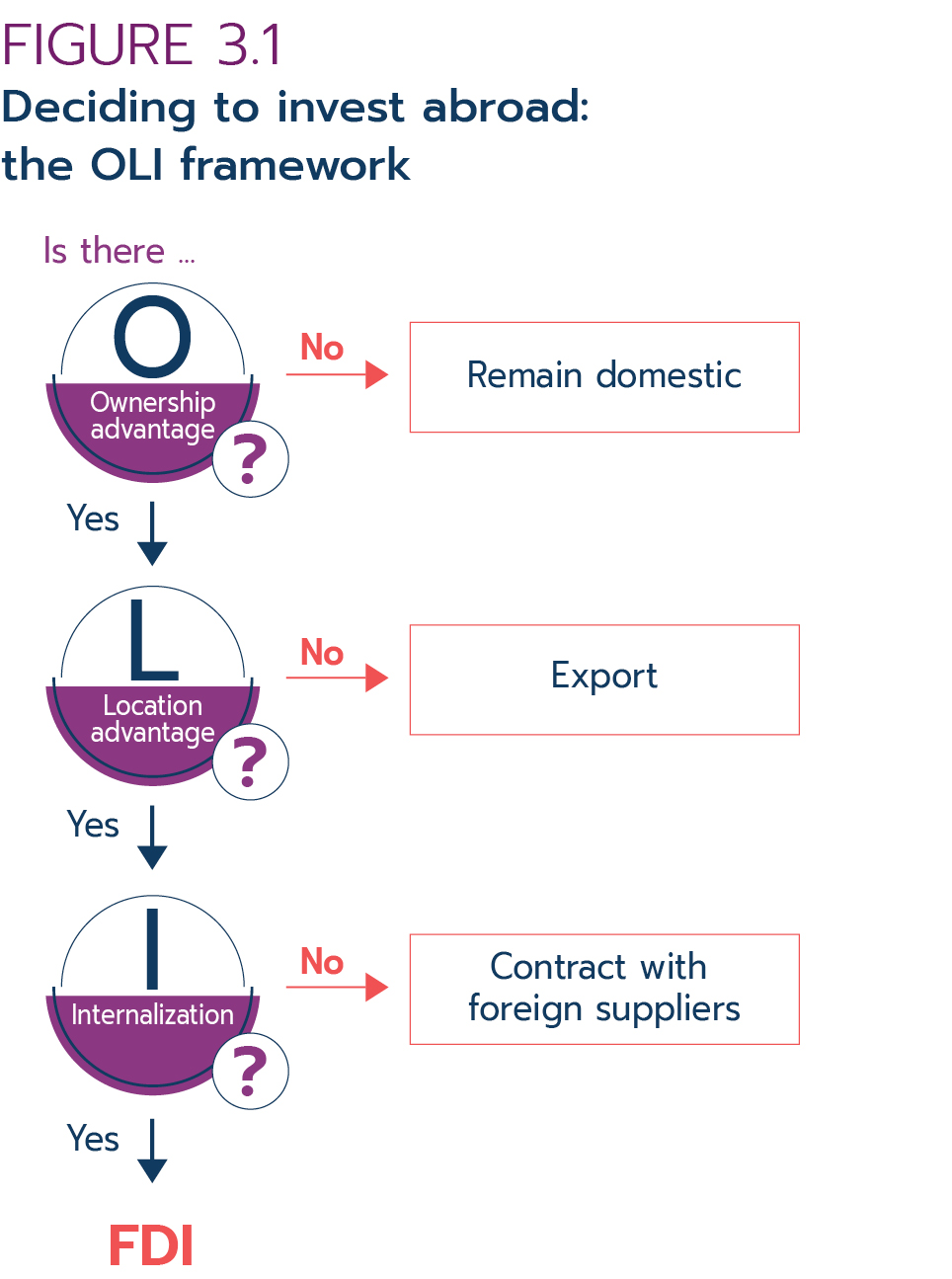
Text version
Figure 3.1: Deciding to invest abroad: the OLI framework
Is there an ownership advantage for the enterprise? If no, it should remain domestic.
If yes, the next question to ask : Is there a location advantage for the enterprise? If no, it should export.
If yes, the next question to ask : Is there an internalization in all its operations for the enterprise? If no, it should contract with foreign suppliers.
If yes, it should invest abroad.
The primary goal of "resource-seeking" investment is to obtain access to key resources such as raw materials, labour, and infrastructure assets (Dunning and Lundan, 2008). Most resource-seeking activities take place in developing countries, but key resources in developed countries are also subject to resource-seeking investment (McKern, 1993). A prime example is Japan's Mitsubishi Corporation's 15% stake in Canada's $40-billion liquefied natural gas (LNG) project, the largest private infrastructure investment in Canada's history.
Other firms will primarily invest to grow existing markets or to find new markets in which to sell their products. This type of FDI is driven by market size, per capita income, market growth potential and access to regional or global markets. This "market-seeking" motivation is especially common when direct exports to a country are difficult or expensive—whether due to distance, or because of tariffs or other non-tariff barriers. Firms may also seek to expand into a new market by investing in a third country and exporting to that market from there. Also, firms may choose to set up a foreign affiliate in order to adapt their products and/or services to accommodate local or regional tastes, culture or needs (Dunning and Lundan, 2008).
Some firms seek out key assets that aid their representation abroad, advancing global and regional strategies. These could be foreign brands, distribution networks, or human capital. Most merger and acquisition (M&A) activity is driven by this "strategic asset-seeking" motivation (Box 3.2).
With "efficiency-seeking" FDI, a firm's goal is the improvement of its overall cost efficiency through economies of scale, and scope and risk diversification (Dunning and Lundan, 2008).Efficiency-seeking foreign investments aim to take advantage of the differences in availability and costs in factor endowments (i.e. capital, labour, and resources) between different countries or the economies of scale and scope between similar economies.
These 4 motivations for investing abroad are not mutually exclusive, and firms often engage in FDI for a combination of these reasons. Also, companies' motivations may evolve over time. For example, a business may choose to invest in a country to gain access to its natural resources. However, the host country could also be a market for its goods or become an entry point to another regional market.
Box 3.2: Strategic investments in transportation
Inter Pipeline Ltd., headquartered in Calgary, Alberta, is a major petroleum transportation, natural gas liquids processing and bulk liquid storage business. Inter Pipeline Ltd. owns and operates energy infrastructure assets in western Canada and is building the Heartland Petrochemical Complex— Canada's first integrated propane dehydrogenation and polypropylene facility. In September 2020, Inter Pipeline Ltd. announced that it was acquiring the Milk River pipeline system from Plains Midstream Canada ULC ("Plains"), a wholly owned subsidiary of Plains All American Pipeline, L.P. The Milk River pipeline system will improve Inter Pipeline's access to the Montana refining region, an important delivery market for Inter Pipeline and its customers.
Canadian National Railway (CN), Canada's largest railway network, is headquartered in Montréal, Quebec. CN's vast network spans Canada and the mid-U.S. and connects 3 coasts: the Pacific, the Atlantic, and the Gulf of Mexico. In July 2020, CN announced a series of investments in the U.S. as part of its strategy to "support growing demand and enable supply chains." The company's strategic investments amount to US$520 million for the upgrade and maintenance of infrastructure in 8 U.S. states. Investments include:
- $55 million in Michigan to focus on maintenance, the expansion of its Flint car processing centre, autonomous track inspection railcars, and implementation of the Positive Train Control (PTC) system, a safety overlay designed to help prevent certain accidents resulting from human error
- $60 million in Louisiana to focus primarily on a bridge reconstruction project as well as infrastructure maintenance
- $100 million in Wisconsin to focus on a new car processing and transshipment facility in New Richmond, the maintenance of track infrastructure, and the replacement of rail and ties
- $165 million in Illinois to focus on the renewal of Chicago's St. Charles Airline Bridge as well as the replacement of rail and ties and infrastructure maintenance
FDI structures
Depending on the investment motives, the corporate structure resulting from FDI takes different forms. The 2 main structures are "horizontal" and "vertical" FDI.
With horizontal FDI, investors establish local subsidiaries in the host countries, which replicate the investor's home country activities. In this case, investors are usually driven by market-seeking motives. Goods and services destined for the host market are produced or delivered locally rather than imported. There are savings associated with transportation, access and trade costs.
When the potential host country is small, exports are a cheaper alternative to FDI to serve the foreign market because the potential savings in trade costs do not offset the fixed costs of setting up a foreign plant. However, when a host country is large enough to offset these costs, FDI becomes a better value proposition (Antras and Yeaple, 2014). Horizontal FDI is common in the automotive industry and the food and beverage industry. Vertical FDI described below is also prevalent in the automotive industry.
Vertical FDI occurs when foreign investors break up their production processes by location. This allows them to locate different activities in specific regions and benefit from natural resource endowments and/or the economies of scale in production due to lower labour costs. Many of these investors are resource-seeking or strategic asset-seeking, but they can also be efficiency-seeking firms. Vertical FDI can be backward—as in the case of an enterprise investing in a raw material supplier—or forward, such as when a company invests in a distributor for its products or services (Figure 3.2).
Conglomerate FDI is another FDI structure. Conglomerates are multinationals whose FDI is often already structured horizontally and/or vertically. This type of multinational enters an industry or multiple industries that are unrelated to its existing domestic business. Using a conglomerate FDI strategy, multinationals offer a diverse range of products and/or services.
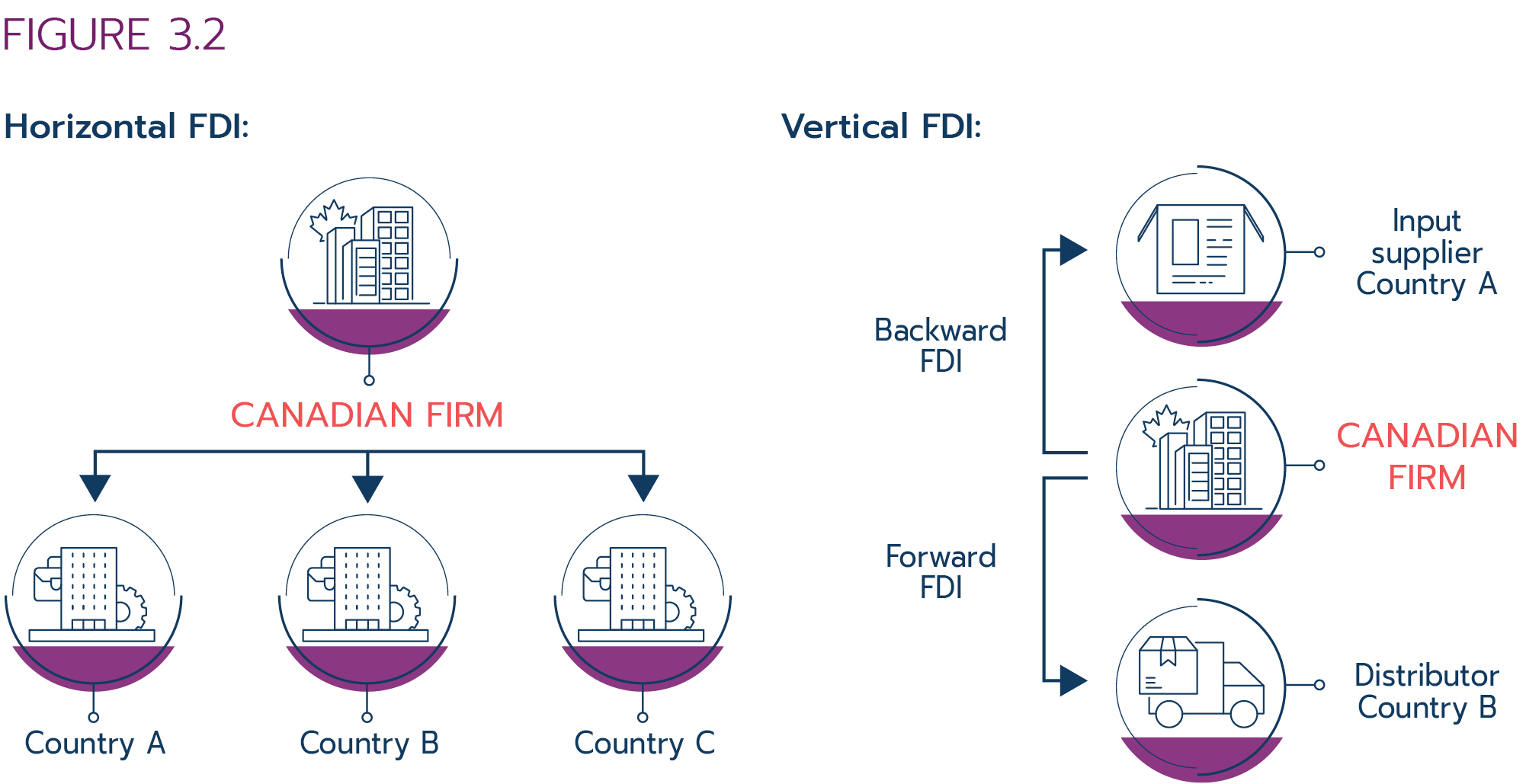
Text version
Figure 3.2: Structuring FDI—market growth and supply chain integration
A firm can invest using horizontal FDI or vertical FDI.
Horizontal FDI replicates the firm's domestic manufacturing and service supply operations in one or several foreign countries.
Vertical FDI can be either backward or forward. Backward vertical FDI is when a firm invests abroad in a process earlier in the supply chain, such as a resource supplier while forward vertical FDI is when a firm invests abroad in a process later in the supply chain, such as a distributor for its products.
3.2 Benefits of Canadian investment abroad
Canadian firms that invest abroad gain access to foreign markets and are able to better integrate into global value chains. Tapping into global value chains can provide firms with productivity and competitiveness benefits that help support the rest of their activities (Poloz, 2012; Rai et al., 2018). Outward investment is also more likely to complement domestic investment rather than be a substitute. A study on U.S manufacturing firms (Hines et al., 2009) found that those that expanded their foreign operations over a 20-year period also expanded their domestic operations, and that this investment was associated with growing domestic capital accumulation, wages, R&D and intra-firm exports.
Recent studies highlight the benefits of CDIA to domestic firms and the Canadian economy. A 2018 Bank of Canada paper showed that firms with greenfield investments experienced higher productivity growth compared to similar firms that remained domestic. Furthermore, the positive effects of outward investment go beyond the firm level. Provinces with more outward investment showed stronger productivity growth, particularly when the investments were in OECD countries versus non-OECD countries. This suggests that there may be greater learning and technological spillovers when investing in countries with similar economies, cultures, and/or institutions (Rai et al., 2018). Another study found that a 10% increase in Canada's outward FDI stock would have a positive impact not only on trade flows and foreign sales, but also on domestic investment, innovation, productivity, employment, and real GDP (Rao and Zhing, 2018).
Results from a 2015 Export Development Canada (EDC) survey of Canadian firms with foreign operations also highlight the impact of foreign affiliates. Nine out of ten survey respondents said that their foreign affiliates had made their firm more competitive, with four out of five stating that their foreign affiliates had a positive impact on company sales, customer base, profits, growth and market share. Most respondents also agreed that their foreign affiliates had provided a net benefit to their domestic operations, primarily by sustaining and facilitating the growth of their operations in Canada, which also included providing new employment opportunities.
While the tendency is sometimes to focus on the potential loss of domestic jobs and investment resulting from the establishment of foreign affiliates (and indeed, a small percentage of respondents to the EDC survey did cite job losses in Canada as an issue), respondents to the EDC survey as well as to the 2017 Statistics Canada Survey of Innovation and Business Strategy (SIBS) indicated that the main reason for establishing foreign affiliates is to increase sales by accessing new markets and gaining proximity to key customers (Figure 3.3). The SIBS survey also found that Canadian businesses are now more likely to sell goods and services internationally through their foreign affiliates than through direct exports from Canada, illustrating the important role that foreign affiliates play as global sales platforms for Canadian companies.
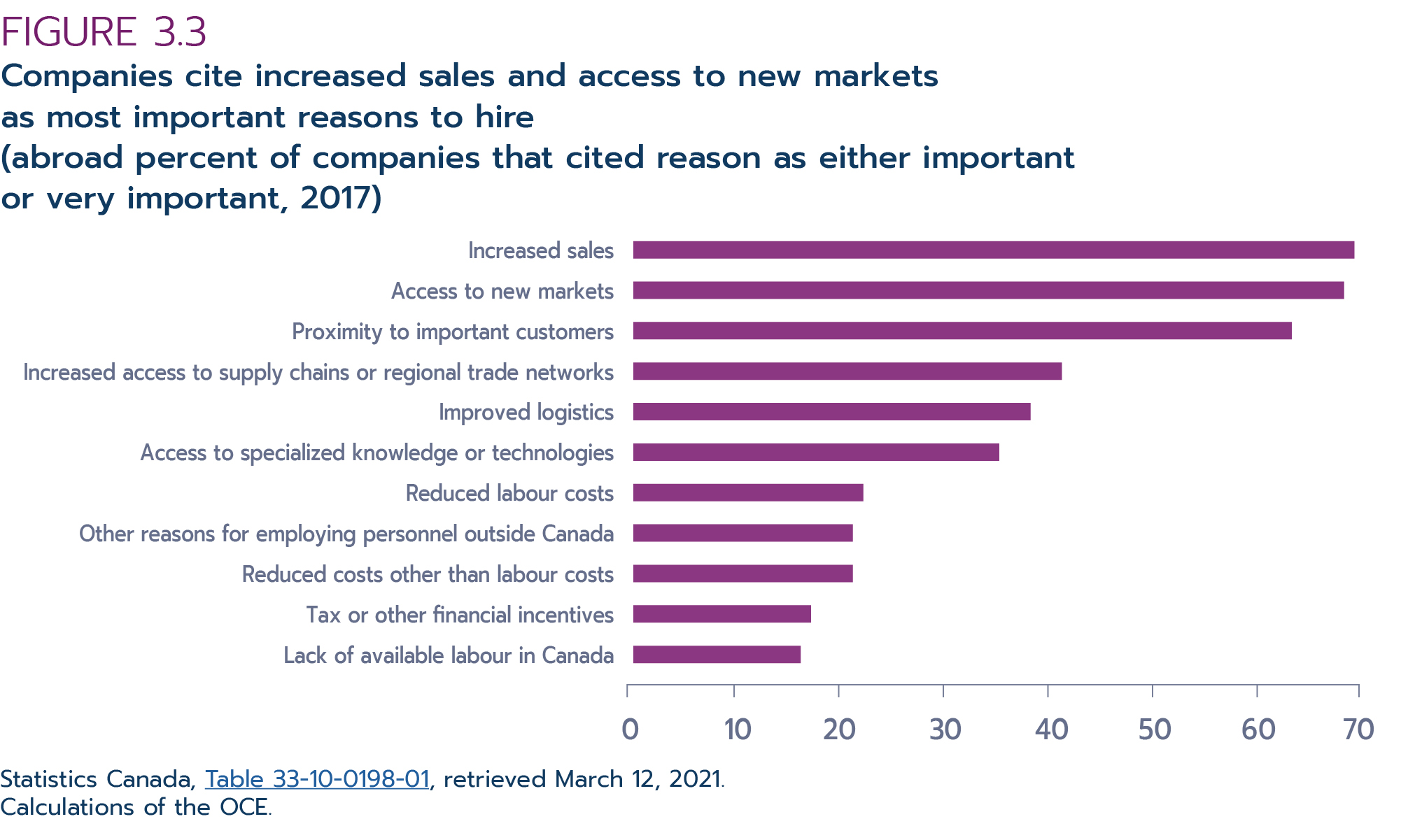
Text version
Figure 3.3: Companies cite increased sales and access to new markets as most important reasons to hire abroad
(percent of companies that cited reason as either important or very important, 2017)
| Reason | Important + Very Important |
|---|---|
| Access to new markets | 68 |
| Access to specialized knowledge or technologies | 35 |
| Improved logistics | 38 |
| Increased access to supply chains or regional trade networks | 42 |
| Increased sales | 70 |
| Lack of available labour in Canada | 16 |
| Other reasons for employing personnel outside Canada | 22 |
| Proximity to important customers | 63 |
| Reduced costs other than labour costs | 21 |
| Reduced labour costs | 22 |
| Tax or other financial incentives | 18 |
Source: Statistics Canada, Table 33-10-0198-01, retrieved March 12, 2021.
Calculations of the OCE.
Between 2011 and 2018, sales by foreign affiliates increased by over 50% from $478 billion to $734 billion (Figure 3.5). At the same time, exports of goods and services rose by 33% from $544 billion to $722 billion. Around three quarters of the growth in foreign affiliate sales during this period came from service sector industries such as retail trade and finance and insurance. The services sector now accounts for the majority of foreign affiliate sales. Furthermore, sales by foreign affiliates in the services sector far exceed exports in this sector. This underscores the fact that having a local presence is especially important for foreign sales of services (Figure 3.4).
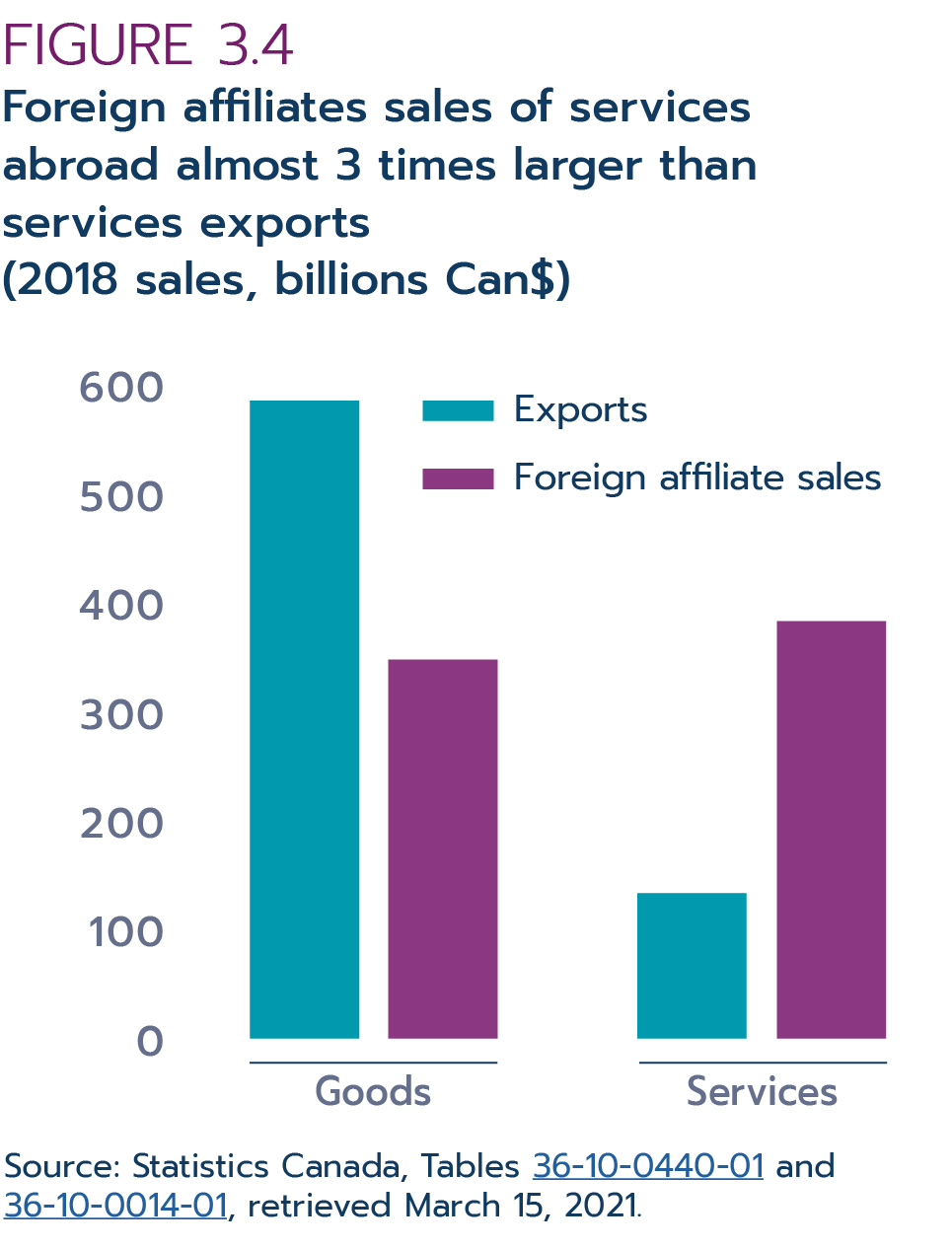
Text version
Figure 3.4: Foreign affiliates sales of services abroad almost 3 times larger than services exports
(2018 sales, billions Can$)
| Goods | Services | |
|---|---|---|
| Exports | 588 | 134 |
| Foreign affiliate sales | 347 | 386 |
Source: Statistics Canada, Tables 36-10-0440-01 and 36-10-0014-01, retrieved March 15, 2021.
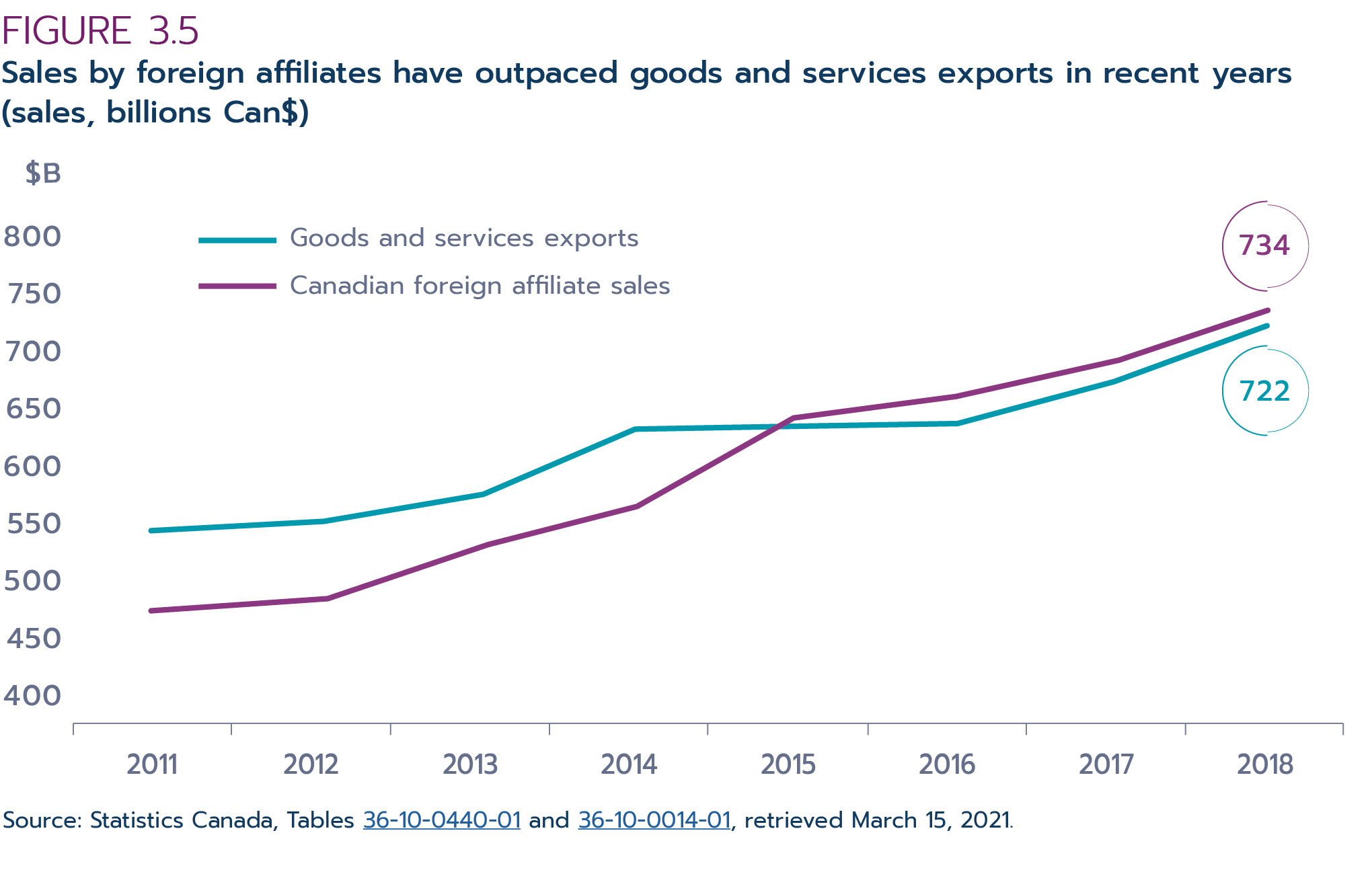
Text version
Figure 3.5: Sales by foreign affiliates have outpaced goods and services exports in recent years
(sales, billions Can$)
| 2011 | 2012 | 2013 | 2014 | 2015 | 2016 | 2017 | 2018 | |
|---|---|---|---|---|---|---|---|---|
| Goods and services exports | 544 | 555 | 577 | 633 | 634 | 638 | 673 | 722 |
| Canadian foreign affiliate sales | 478 | 488 | 530 | 568 | 641 | 661 | 690 | 734 |
Source: Statistics Canada, Tables 36-10-0440-01 and 36-10-0014-01, retrieved March 15, 2021.
This rings particularly true for the finance and insurance services industry, which currently accounts for more than a third of all outward investment (Figure 3.6). Canada's banks and insurance companies have been the largest source for Canadian investment abroad for years. Delivery of financial services abroad requires direct, face-to-face communication with customers, driving the need for large investments in physical service and distribution networks.
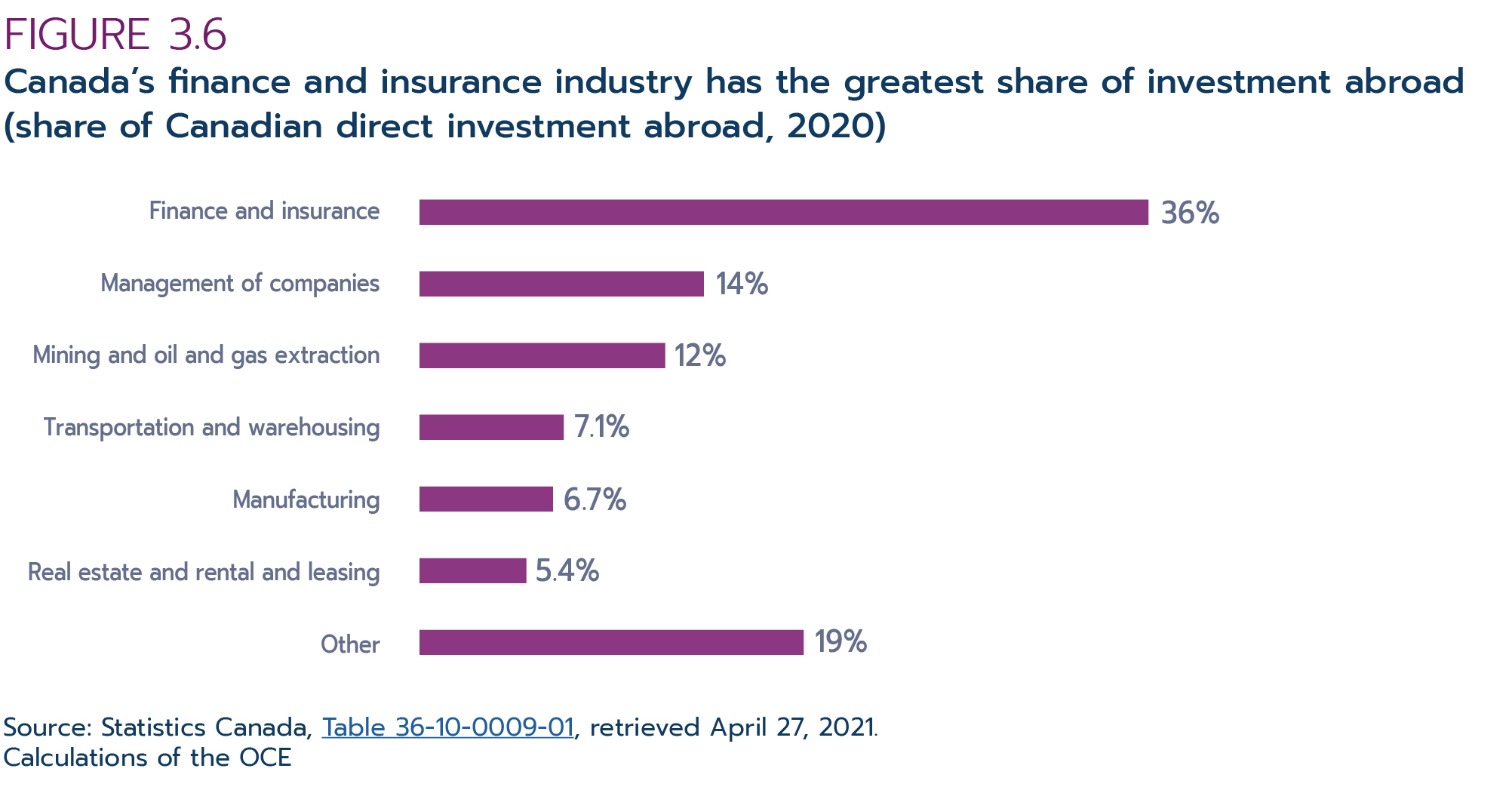
Text version
Figure 3.6: Canada's finance and insurance industry has the greatest share of investment abroad
(share of Canadian direct investment abroad, 2020)
| North American Industry Classification System (NAICS) 1 2 | 2020 | |
| Finance and insurance | 36% | |
| Other | 19% | |
| Management of companies and enterprises | 14% | |
| Mining and oil and gas extraction | 12% | |
| Transportation and warehousing | 7.1% | |
| Manufacturing | 6.7% | |
| Real estate and rental and leasing | 5.4% | |
Source: Statistics Canada, Table 36-10-0009-01, retrieved April 27, 2021.
Calculations of the OCE.
In addition to providing potential gains in competitiveness and productivity, foreign affiliates serve as a source of financing for the parent company. The profits generated by foreign affiliates grew considerably over the past decade having more than doubled between 2010 and 2019—in line with the growth in CDIA stock over the same period. Not surprisingly, profits dipped in 2020 with the pandemic-induced global economic downturn. Nonetheless they amounted to $65 billion, of which some $26 billion was remitted to Canada in the form of dividends.
Over the past decade the payout ratio of foreign affiliates has remained fairly constant, with foreign affiliates sending roughly 40% of their profits back to their Canadian parents in the form of dividends.Footnote 11 These dividends can in turn be used to fund domestic investments and/or help with other financing needs such as the payment of dividends to shareholders of the Canadian parent company.
Foreign investment is critical to Canada's future. It links Canadian companies, consumers and workers to the new knowledge-based global economy. It enhances Canada's competitiveness by revitalizing domestic industry and increasing the flow of goods and services between Canada and its trading partners. Foreign investment not only opens up opportunities in new markets, but also creates jobs and increases exposure to new technologies and management techniques.
Canadian multinationals (CMNEs) generate 11% of all Canadian jobs, produce one sixth of all GDP, and are responsible for just under a quarter of all goods and commercial services exports. Their contribution is even more important within the corporate sector. CMNEs hold half of all the Canadian corporate assets and make up 16% of jobs, produce roughly one quarter of GDP, and are responsible for 36% of capital investment.
A direct comparison of CMNEs to non-MNEs in Canada reveals that though only 4 of every 1,000 Canadian-owned firms is a multinational, these firms employ nearly 200 of every 1,000 workers, generate over one third of GDP and contribute to 60% of goods and commercial services exports. Furthermore, CMNEs generate over 400 out of every 1,000 R&D jobs and are responsible for over 50% of R&D spending. CMNEs are responsible for just under one half of all capital investment of Canadian-owned firms.Footnote 12
3.3 Global reach—where Canadian companies invest
Canadian companies are continuing to expand their investments abroad. The ratio of CDIA to GDP increased almost 5-fold since 1990, from 14% to 67% in 2020. Since 1997, when the total CDIA stock first exceeded the stock of FDI in Canada, Canada has been a net supplier of FDI to the world economy, rather than primarily a host country (Figure 3.7). Between 2010 and 2018, the number of CMNEs grew by almost 30%, from under 9,000 to almost 11,500. Canadian entrepreneurs are successfully finding global commercial opportunities across the world and profit from them by establishing foreign production and service facilities. Canada's rates of outward FDI stock growth mirror the global and G7 rates and show that Canadian MNEs are following the worldwide process of internationalization of production (Hejazi, 2010). Investing abroad is a way to remain internationally competitive and stay in business, particularly in global value chain intensive industries such as electronics, auto and aerospace.
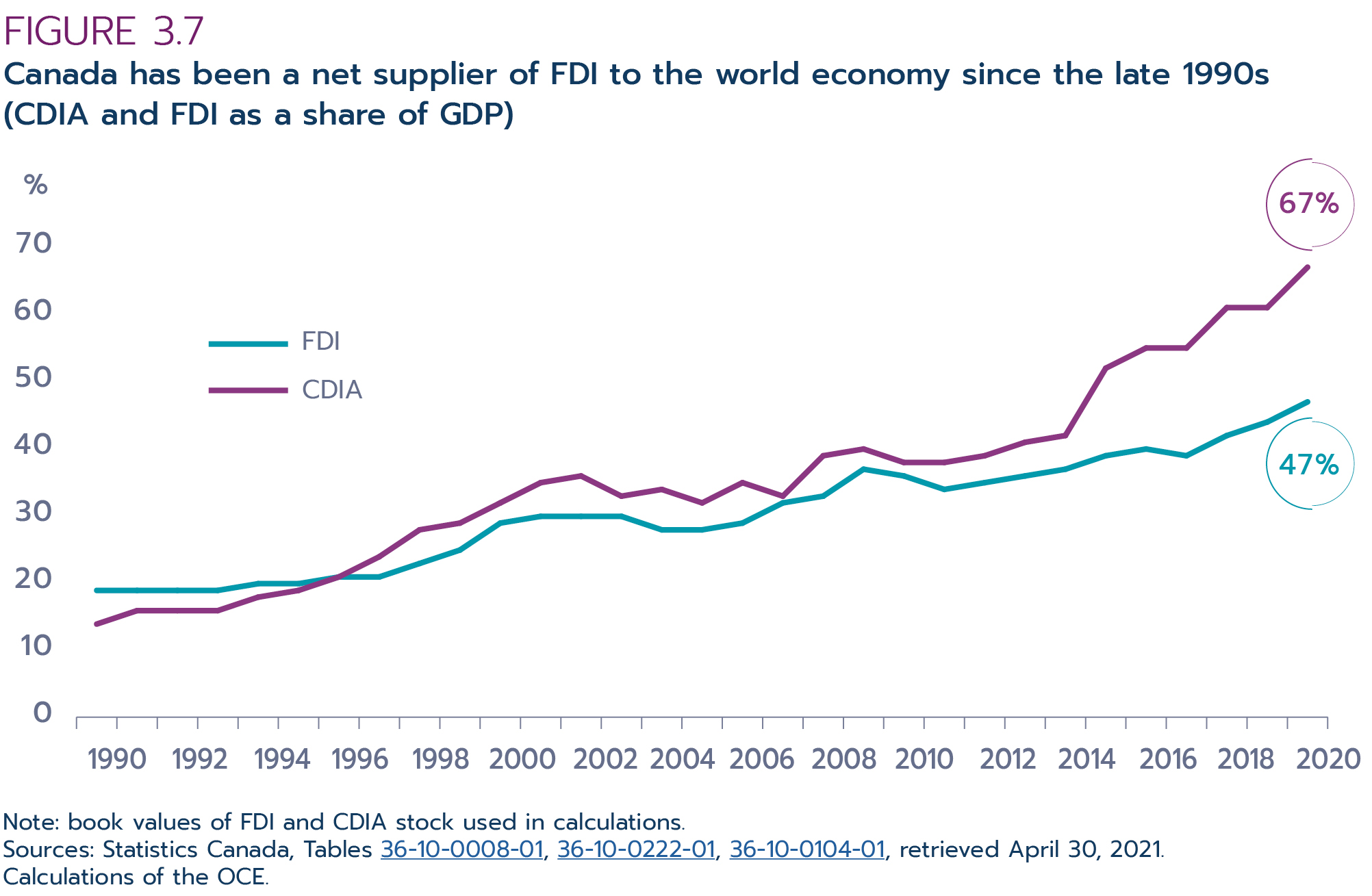
Text version
Figure 3.7: Canada has been a net supplier of FDI to the world economy since the late 1990s
(CDIA and FDI as a share of GDP)
| CDIA | FDI | |
|---|---|---|
| 1990 | 14% | 19% |
| 1991 | 16% | 19% |
| 1992 | 16% | 19% |
| 1993 | 16% | 19% |
| 1994 | 18% | 20% |
| 1995 | 19% | 20% |
| 1996 | 21% | 21% |
| 1997 | 24% | 21% |
| 1998 | 28% | 23% |
| 1999 | 29% | 25% |
| 2000 | 32% | 29% |
| 2001 | 35% | 30% |
| 2002 | 36% | 30% |
| 2003 | 33% | 30% |
| 2004 | 34% | 28% |
| 2005 | 32% | 28% |
| 2006 | 35% | 29% |
| 2007 | 33% | 32% |
| 2008 | 39% | 33% |
| 2009 | 40% | 37% |
| 2010 | 38% | 36% |
| 2011 | 38% | 34% |
| 2012 | 39% | 35% |
| 2013 | 41% | 36% |
| 2014 | 42% | 37% |
| 2015 | 52% | 39% |
| 2016 | 55% | 40% |
| 2017 | 55% | 39% |
| 2018 | 61% | 42% |
| 2019 | 61% | 44% |
| 2020 | 67% | 47% |
Note: book values of FDI and CDIA stock used in calculations.
Sources: Statistics Canada, Tables 36-10-0008-01, 36-10-0222-01, 36-10-0104-01, retrieved April 30, 2021.
Calculations of the OCE.
Canada's stock of direct investment abroad has diversified over the past 30 years. Slightly less than 50% of CDIA stock is now invested in the United States; up until 1990 the U.S. held over 60% of total CDIA. Just over a quarter of CDIA stock is in Europe, and the remainder split between Asia/Oceania and South and Central America. Investment in South and Central America now represents 4% of total CDIA stock, up from 2% in the early 1990s.Footnote 13
Box 3.3: A new model for protecting CDIA
In May 2021, Canada introduced a new, modernized and inclusive Foreign Investment Promotion and Protection Agreement (FIPA) model—the first comprehensive revision since 2003. FIPAs offer protection to investors for their assets abroad through legally binding obligations and rights. For example, a FIPA could include one or several provisions to ensure that foreign investors receive the same treatment as domestic companies when dealing with national and sub-national governments. Over the years, Canada has negotiated and entered into force over 35 FIPAS.
Canada's new FIPA model includes key innovations to core investment obligations, improvements to the investor-state dispute settlement mechanism and a number of "inclusive trade" provisions. The revised FIPA model will further the provision of a stable, rules-based investment environment for Canadian businesses investing abroad. Furthermore, it will ensure that SMEs and all Canadians, including women and Indigenous peoples, are able to benefit from these agreements. Examples of key changes include provisions to
- improve transparency and streamline administrative procedures for SMEs investing abroad
- better reflect Indigenous peoples' rights and participation
- support gender equality and diversity by, for example, encouraging the appointment of women as arbitrators or to senior management positions
This new modernized and inclusive model FIPA text will serve as the basis for Canada's future FIPA negotiations.
Greater diversification of CDIA makes economic sense, partly because the costs of managing foreign affiliates are less sensitive to distance than are the transportation costs associated with trade, and partly because face-to-face interaction is often critical for selling services abroad, making foreign investment a necessity.
Looking at the top 10 destinations for CDIA reveals that CDIA in the U.S. is almost 6 times as great as CDIA in the second-largest destination, the United Kingdom (Figure 3.8). The U.K., Luxembourg and the Netherlands are the main European destinations. Interestingly, a number of Caribbean economies are among the top 10: Bermuda, the Cayman Islands, and Barbados. The remaining top destinations for CDIA are Australia, Mexico and Chile.
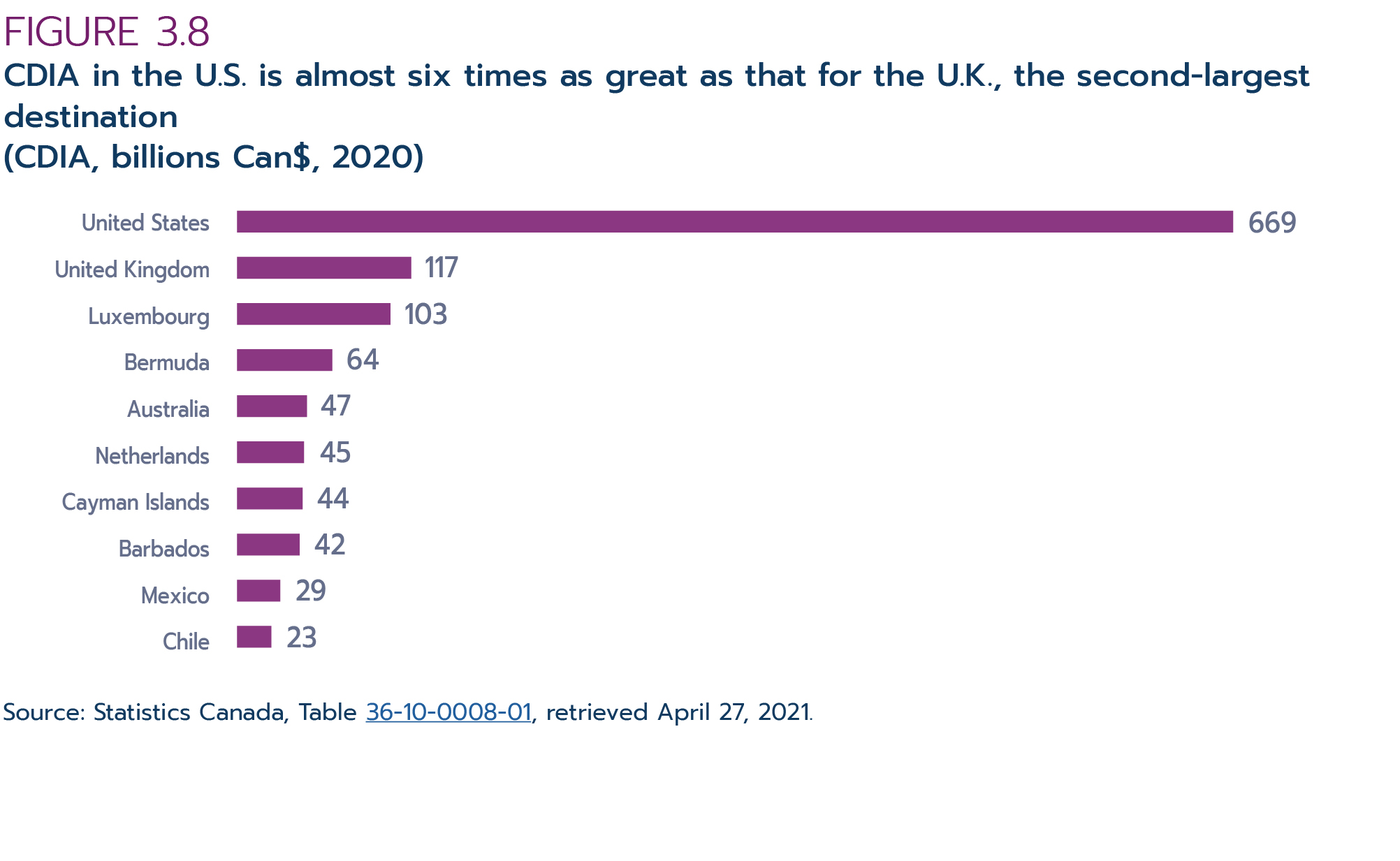
Text version
Figure 3.8: CDIA in the U.S. is almost six times as great as that for the U.K., the second-largest destination
(CDIA, billions Cad$, 2020)
| Country | 2020 |
|---|---|
| United States | 669 |
| United Kingdom | 117 |
| Luxembourg | 103 |
| Bermuda | 64 |
| Australia | 47 |
| Netherlands | 45 |
| Cayman Islands | 44 |
| Barbados | 42 |
| Mexico | 29 |
| Chile | 23 |
Source: Statistics Canada, Table 36-10-0008-01, retrieved April 27, 2021.
It is important to keep in mind that the CDIA data are based on the first destination. For example, suppose a Canadian company channels funds through a subsidiary in Bermuda but the investment is ultimately destined for Mexico. In this case, the Canadian investment would be allocated to Bermuda and not to Mexico, the ultimate destination. So, CDIA in one country may be overstated while CDIA in another country may be understated. CDIA data by ultimate destination, or ultimate host country, are currently not available (Box 3.4). Canadian investments in the Caribbean region, such as the Cayman Islands and Bermuda, and possibly to some extent in Luxembourg and the Netherlands, are primarily in offshore financial centres—they are typically not the ultimate host countries of the CDIA (Damgaard et al., 2019).
Box 3.4: Producing statistics by ultimate host country
Canadian direct investment data by ultimate host country (UHC) would provide more accurate information on the markets and sectors where Canadians are investing. Unfortunately, producing UHC data presents challenges. One challenge is linking specific sources of funding with their uses. Another issue is that investments by intermediate enterprises may reflect funding not only from direct investors but also from other sources, such as local sources (OECD, 2008). International efforts are currently under way to determine whether it is feasible to identify the ultimate host countries of outward direct investment.
Statistics Canada is planning research in the second half of 2021 to see how it may be able to contribute to the international efforts to develop a methodology to produce statistics by UHC. At this stage, Statistics Canada is unable to determine what would be feasible from existing data sources or if redesigning the questionnaire would help CDIA respondents provide the required information.
The distribution of CDIA stock by sector reveals that the largest share has shifted from manufacturing to finance and insurance services, which now accounts for over a third of the total (Figure 3.9). Manufacturing, which accounted for over 30% of CDIA stock in 2000, now makes up less than one tenth of the total. The management of companies and enterprises industry (See Chapter 2, Box 2.6) is the second largest, making up less than a sixth of the total, closely followed by mining and oil and gas extraction.
Canada's financial industry is one of its strongest international assets; its banking system was long recognized as the soundest in the world by the World Economic Forum. In contrast to the U.S. financial institutions, whose domestic market already provides for large-scale operations, Canada's finance and insurance companies that want to expand and aspire to large-scale operations need to reach foreign markets and customers.
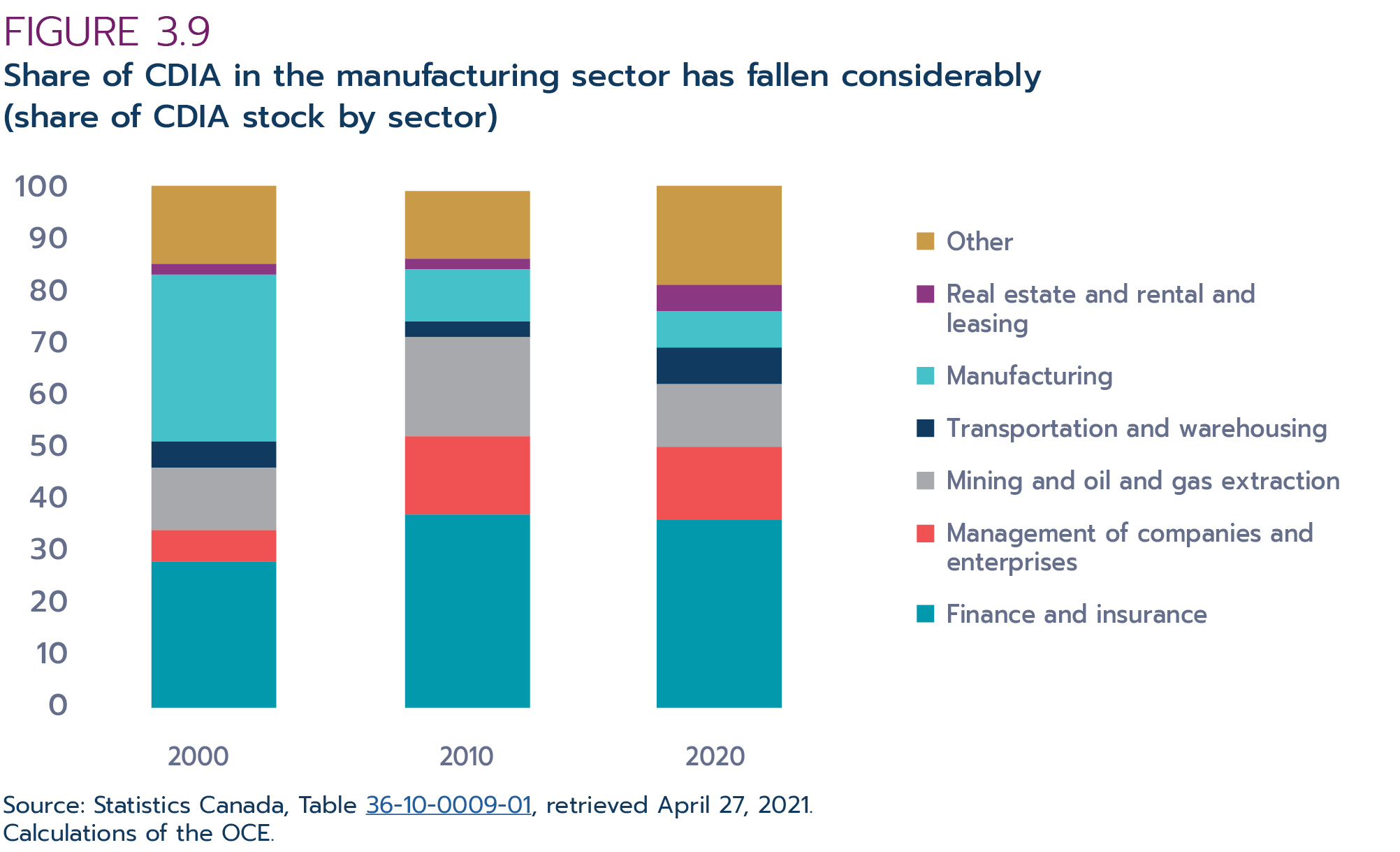
Text version
Figure 3.9: Share of CDIA in the manufacturing sector has fallen considerably
(share of CDIA stock by sector)
| 2000 | 2010 | 2020 | |
|---|---|---|---|
| Finance and insurance | 28% | 37% | 36% |
| Management of companies and enterprises | 6% | 15% | 14% |
| Mining and oil and gas extraction | 12% | 19% | 12% |
| Transportation and warehousing | 5% | 3% | 7% |
| Manufacturing | 32% | 10% | 7% |
| Real estate and rental and leasing | 2% | 2% | 5% |
| Other | 15% | 13% | 19% |
Source: Statistics Canada, Table 36-10-0009-01, retrieved April 27, 2021.
Calculations of the OCE.
Table 3.1: The global reach of Canadian businesses
(CDIA stock by industry and region, 2020)
| Total, all countries | United States | Other Americas | Asia and Oceania | Europe | ||||||
|---|---|---|---|---|---|---|---|---|---|---|
| billions $ | industry share (%) | billions $ | share of industry total (%) | billions $ | share of industry total (%) | billions $ | share of industry total (%) | billions $ | share of industry total (%) | |
| Total, all industries | 1,469 | 100 | 669 | 46 | 280 | 19 | 120 | 8.2 | 388 | 26 |
| Agriculture, forestry, fishing and hunting | 2.8 | 0.2 | 2.0 | 73 | 0.0 | 0.3 | 0.0 | -0.1 | 0.8 | 27 |
| Mining and oil and gas extraction | 178 | 12 | 47 | 27 | 66 | 37 | 24 | 14 | 36 | 20 |
| Utilities | 77 | 5.2 | 37 | 48 | 22 | 29 | 0.6 | 0.8 | 17 | 23 |
| Construction | 2.8 | 0.2 | 2.8 | 100 | 0.0 | 0.2 | 0.0 | -0.8 | 0.0 | 0.0 |
| Manufacturing | 98 | 6.7 | 55 | 57 | 5.0 | 5.2 | 8.5 | 8.7 | 28 | 29 |
| Wholesale trade | 40 | 2.7 | 13 | 33 | 12 | 31 | 7.0 | 18 | 7.5 | 19 |
| Retail trade | 19 | 1.3 | 7.0 | 37 | 7.4 | 39 | 0.2 | 0.8 | 4.5 | 24 |
| Transportation and warehousing | 104 | 7.1 | 94 | 90 | 1.9 | 1.8 | 6.0 | 5.8 | 2.0 | 1.9 |
| Information and cultural industries | 65 | 4.4 | 33 | 50 | 0.7 | 1.1 | 4.5 | 6.9 | 27 | 41 |
| Finance and insurance | 527 | 36 | 236 | 45 | 125 | 24 | 40 | 7.7 | 120 | 23 |
| Real estate and rental and leasing | 79 | 5.4 | 44 | 56 | 2.9 | 3.6 | 18 | 23 | 15 | 18 |
| Professional, scientific and technical services | 46 | 3.2 | 18 | 38 | 2.8 | 5.9 | 2.7 | 5.8 | 23 | 50 |
| Management of companies and enterprises | 205 | 14 | 69 | 34 | 29 | 14 | 6.8 | 3.3 | 99 | 48 |
| Accommodation and food services | 3.8 | 0.3 | 0.2 | 4.4 | 0.7 | 18 | 1.2 | 32 | 1.7 | 46 |
| All other industries | 21.6 | 1.5 | 11 | 50 | 3.5 | 16 | 0.4 | 2.0 | 7.3 | 34 |
Source: Statistics Canada, Table 36-10-0009-01, retrieved April 27, 2021.
Calculations of the OCE.
Box 3.5: Canadian Investment in the cultural industries sector
Thunderbird Entertainment is a company headquartered in Vancouver, British Columbia, that creates animated programming for digital platforms as well as for Canadian and international broadcasters. In February 2020, Thunderbird announced the opening of its first U.S.-based animation studio in Los Angeles, California. The new studio will serve as a creative hub for showrunners, directors and other creative talent working on Thunderbird series. Thunderbird first established a presence in Los Angeles in 2016: the new studio will integrate the company's other California offices into this larger animation hub. The new animation studio will primarily focus on pre- and post- production activities. This includes writing, directing, storyboarding, design, casting and recording, and editing.
Looking at sectoral CDIA by geographical destination reveals the following (Table 3.1):
- the United States is dominant for CDIA in agriculture, construction, transportation and warehousing and attracts 50% or more of CDIA in manufacturing, information and cultural industries and real estate
- finance and insurance investments in the U.S. are on par with the overall U.S. share of CDIA, while almost one quarter of CDIA in this industry is invested in "Other Americas," mostly Caribbean offshore financial centres
- Europe attracts about half of CDIA in professional, scientific and technical services and accommodation and food services
- CDIA in the information and cultural industries is for the most part split between the U.S. and Europe
- Asia and Oceania attract just under one fifth of CDIA in the real estate and a third in accommodation and food services sectors
- The Americas, excluding the U.S., attract close to 40% of CDIA in the mining and oil and gas extraction sector and the retail trade sector (Box 3.6)
Box 3.6: Canadian mining assets abroad
Natural Resources Canada tracks Canadian mining assets (CMAs) abroad to provide a picture of the global presence of Canada's mining and exploration companies. These data are based on the final investment destination. While the CMA abroad data differ from CDIA data in other ways as well*, they do allow for a closer look at the distribution of Canadian investment abroad in the mining sector.
In 2019, CMAs abroad accounted for roughly two thirds of all Canadian mining assets, and Canadian companies were present in 96 countries worldwide. Almost three quarters of CMAs are located in 10 countries. The U.S. is the leading country with one fifth of Canada's mining assets. South and Central American countries Chile, Panama and Brazil have the next highest asset shares. Overall, Central and South American countries make up half of the top 10 countries with CMAs, accounting for over one third of the total.
* CDIA is based on national systems of accounts and is defined internationally. CMAs abroad are based on financial accounting standards applied by Canadian public companies and auditors.
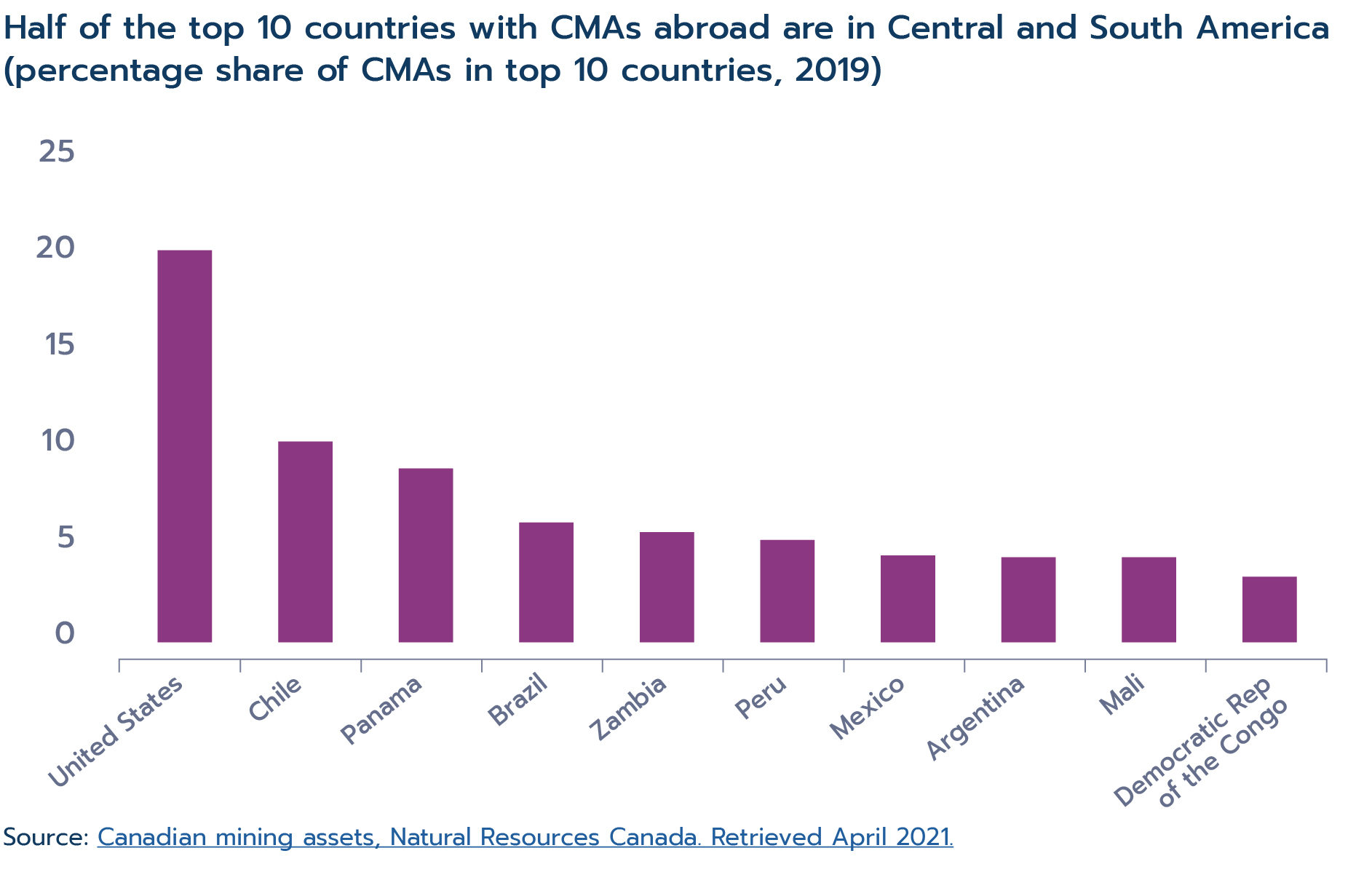
Text version
Half of the top 10 countries with CMAs abroad are in Central and South America (percentage share of CMAs in top 10 countries, 2019)
Top 10 countries with CMAs abroad, 2019
United States: 20
Chile:10
Panama: 9.0
Brazil: 6.2
Zambia: 5.7
Peru: 5.3
Mexico: 4.5
Argentina: 4.4
Mali: 4.4
Democratic Rep of the Congo: 3.4
Take-home messages
- Sales by foreign affiliates have outpaced goods and services exports in recent years.
- The top 3 destinations for CDIA are the U.S., the U.K., and Luxembourg.
- The finance and insurance services industry has accounted for the largest share of CDIA stock since 2001. The management of companies and mining and oil and gas extraction industries hold the second- and third-largest shares, respectively.
Chapter 4: Attracting FDI— showcasing Canada's strengths
Attracting FDI is vital to the growth, prosperity and resilience of Canada's cities, provinces and industries and the overall Canadian economy. FDI creates jobs, fosters competition, boosts trade integration, and drives innovation (see Chapter 2). This, in turn, drives productivity growth and raises living standards.
In essence, attracting FDI means competing on a global scale and promoting Canada's strengths as an investment destination. Foreign investors need to understand what Canada offers as an investment destination to grow their businesses. Investment promotion activities are critical to attracting FDI and to building and maintaining long-term relationships with investors. The promotion of FDI involves the coordination, commitment, and connections among many players across Canada in the FDI ecosystem.
4.1 Canada's value proposition
Firms looking at investing abroad consider and weigh what potential destinations have to offer—their value propositions. How well a country's or region's "brand" is recognized and perceived is what draws investors. Promoting and attracting FDI involves marketing the factors that make a country a favourable location to do business. Canada has a strong economic foundation and a number of key selling points that make it an ideal investment destination.
Key factors that make Canada an attractive place to invest:
- strong, stable and resilient economy
- welcoming business environment
- highly educated, skilled and diverse labour force
- well-developed innovation ecosystem
- extensive access to international markets
- high quality of life
Strong, stable and resilient economy
Canada has a stable economic environment thanks to its reliable monetary and fiscal policy, its geopolitical stability, and its well-functioning financial industry. This stability is important for businesses as it allows them to plan and carry out future activities with minimal disruptions. Thanks to the stable economic environment, the economy has experienced steady growth, low inflation within the central bank's 2% target rate, and low net debt levels.Footnote 14 For the 5 years prior to the COVID-19 pandemic (2015-2019), Canada enjoyed an average annual GDP growth of 2.1%, the second-highest rate in the G7 after the United States. It has also had the lowest net debt-to-GDP ratio in the G7 for over 15 years. Canada's pre-pandemic net debt stood at 23% of GDP.
This strong economic and fiscal position enabled the country to take swift action in addressing the economic consequences of the COVID pandemic by providing direct financial support to individuals and businesses (OECD, 2021). While Canada implemented the highest support measures relative to GDP among G7 countries in 2020, it continued to have the lowest net debt among its G7 peers—net debt rose to 33% of GDP in 2020 and is forecast to rise to 37% in 2021.
In addition to being stable, Canada's economy is quite resilient as job recovery during the pandemic has shown. Employment recovery has been relatively strong to date. According to Statistics Canada, more than 80% of the jobs lost in early 2020 due to the pandemic were recovered by the end of April 2021, and nearly two thirds of these recovered jobs are full-time positions.
Welcoming business environment
Canada is recognized internationally for having a welcoming business environment. Since 2009, it has ranked among the top 5 countries in the world for doing business. In the latest Economist Intelligence Unit (EIU) rankings, Canada was named the best country in the G7 and second in the world for doing business over the next 5 years (2021 to 2025). Among G7 countries, Canada requires the least number of procedures and days to start a business (World Bank's Doing Business report, 2020). Furthermore, the country's healthy entrepreneurship ecosystem is ranked third in the world (the Global Entrepreneurship and Development Institute, 2020). Not surprisingly, Canada is quite attractive to potential entrepreneur migrants, ranking first out of 35 countries (OECD Indicators of Talent Attractiveness, 2019).
An important consideration for businesses is corporate taxation. Canada offers a favourable tax environment to companies. It has the third-lowest corporate income tax rate (26.2%) and the lowest marginal effective tax rate (METR) on new business investments (13.8% in 2019) in the G7 (Figure 4.1). The METR provides potential investors with a good indication of the tax rate that will apply once all deductions are applied on their investments.
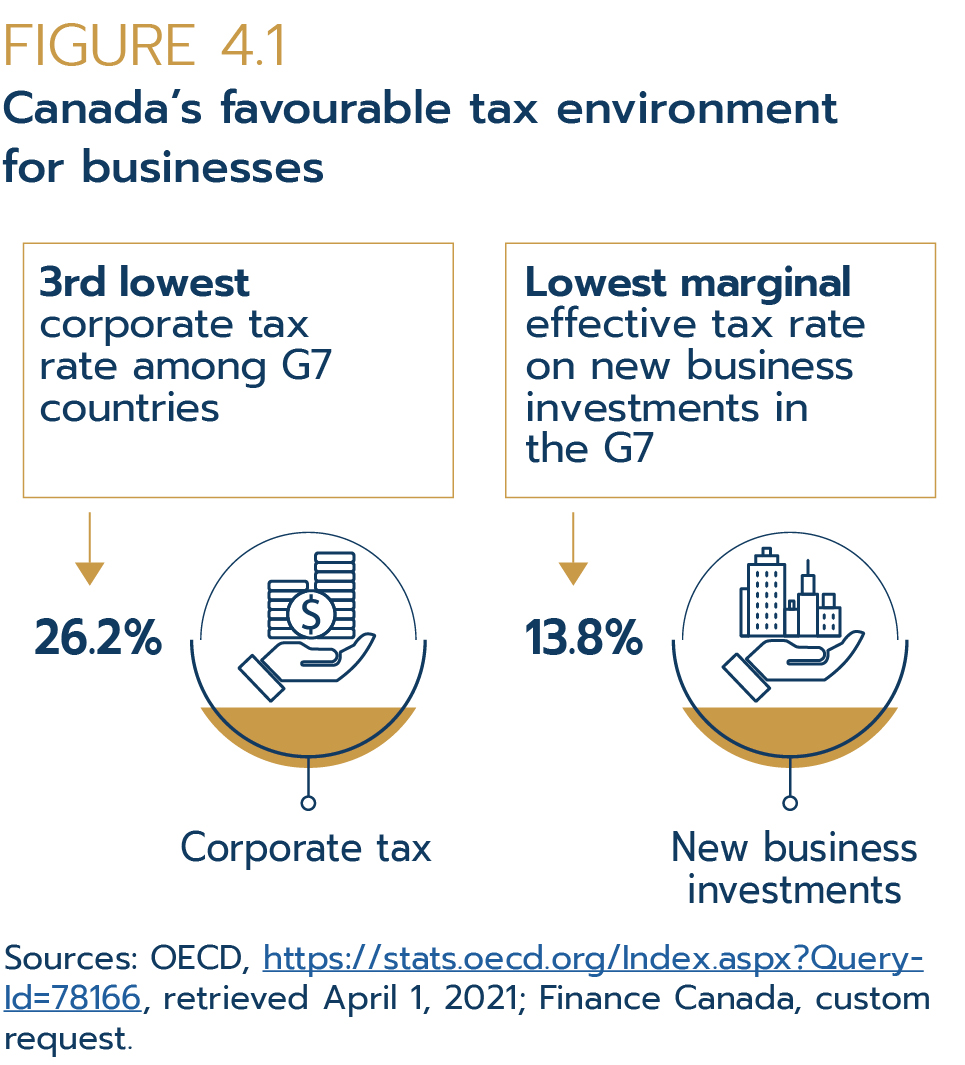
Text version
Figure 4.1: Canada's favourable tax environment for businesses
At 26.2%, Canada has the 3rd lowest corporate tax rate among G7 countries.
Canada's marginal effective tax rate on new business of 13.8% is the third lowest in the G7.
Data sources: OECD, https://stats.oecd.org/Index.aspx?QueryId=78166, retrieved April 1, 2021; Finance Canada, custom request.
Highly educated, skilled and diverse labour force
A key factor that draws investors to Canada is its highly skilled workforce. Nearly 60% of working-age adults (aged 25-64) have a post-secondary degree—the highest share among OECD countries. Furthermore, Canada's post-secondary institutions rank among the top worldwide: University of Toronto, McGill University, and the University of British Columbia are among the top 50 (Quacquarelli Symonds World University Rankings, 2021).
In addition to being highly skilled, Canadian workers are diverse, with over 200 different mother tongue languages. Canada's reputation for skills and diversity attracts international talent: the number of post-secondary international students almost tripled in the last decade, and Canada is fifth among OECD countries on its attractiveness as a destination for highly educated workers (OECD Indicators of Talent Attractiveness, 2021). Canada supports companies in attracting top international talent via its Global Skills Strategy, which provides faster visa application processing times and work permit exemptions.
Managerial talent is critical to all organizations. Canada is recognized for having a workforce with superior management skills, ranking first among G20 countries (International Institute of Management Development [IMD], 2021). Canada also has a large pool of talent with in-demand science, technology, engineering and mathematics (STEM) skills. It ranks first on the availability of qualified engineers (IMD, 2021) and has had a steadily increasing number of new STEM graduates (Figure 4.2).
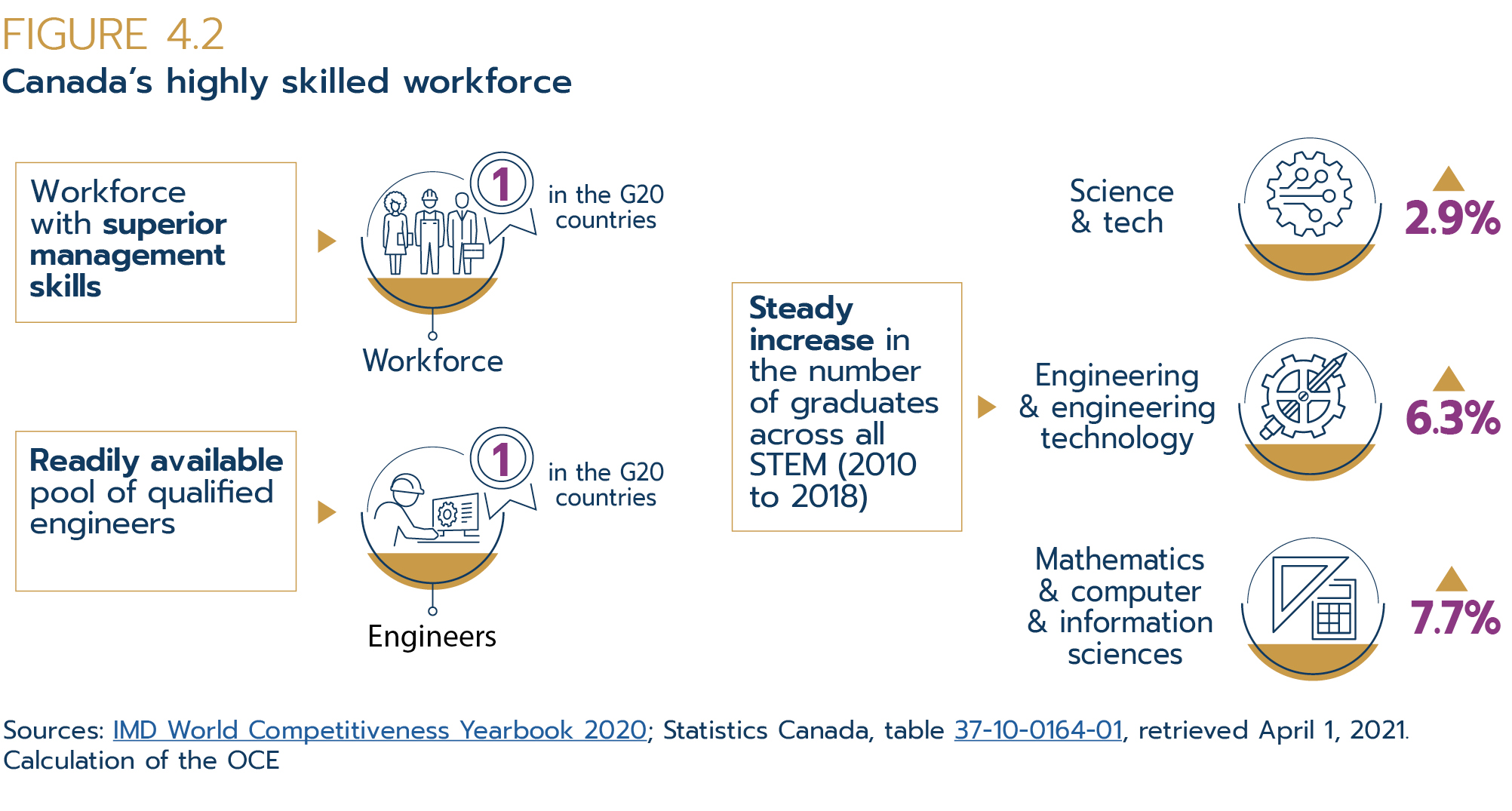
Text version
Figure 4.2: Canada's highly skilled workforce
Canada has:
- 1st in the G20 regarding a workforce with superior management skills
- 1st in the G20 regarding a readily available pool of qualified engineers
Canada experienced an increase in the number of graduates across all STEM fields from 2010 to 2018:
+2.9% in Science & technology
+6.3% in Engineering & engineering technology
+7.7% in Mathematics & computer & information sciences
Data sources: IMD World Competitiveness Yearbook 2020; Statistics Canada, table 37-10-0164-01, retrieved April 1, 2021.
Calculation of the OCE
Well-developed innovation ecosystem
Canada has a well-developed innovation ecosystem where governments, post-secondary education institutions and businesses collaborate. Furthermore, Canada has a long history of supporting innovation with its long-standing Scientific Research and Experimental Development (SR&ED) Program, which provides tax incentives for R&D expenditures.
In 2017, Canada introduced the Strategic Innovation Fund (SIF) and the Innovation Superclusters Initiative via its federal Innovation and Skills Plan. The SIF focuses on providing support to large-scale projects across all sectors. The program's goal is to support Canada's innovation ecosystem by encouraging R&D, facilitating the growth and expansion of firms, attracting large-scale investments, and promoting collaborations between the private sector and non-profit organizations. The Superclusters program provides financial support for the establishment of collaboration among industry, SMEs and post-secondary institutions interested in research in 5 key areas (i.e. superclusters): digital technologies; plant proteins; advanced manufacturing; enhancing the use of artificial intelligence in supply chains; and oceans (Figure 4.3).
Funding for these critical innovation programs recently increased: the SIF will get a $7.2-billion boost over 7 years starting in 2021-22, while the Superclusters program will see an additional $60 million over 2 years.
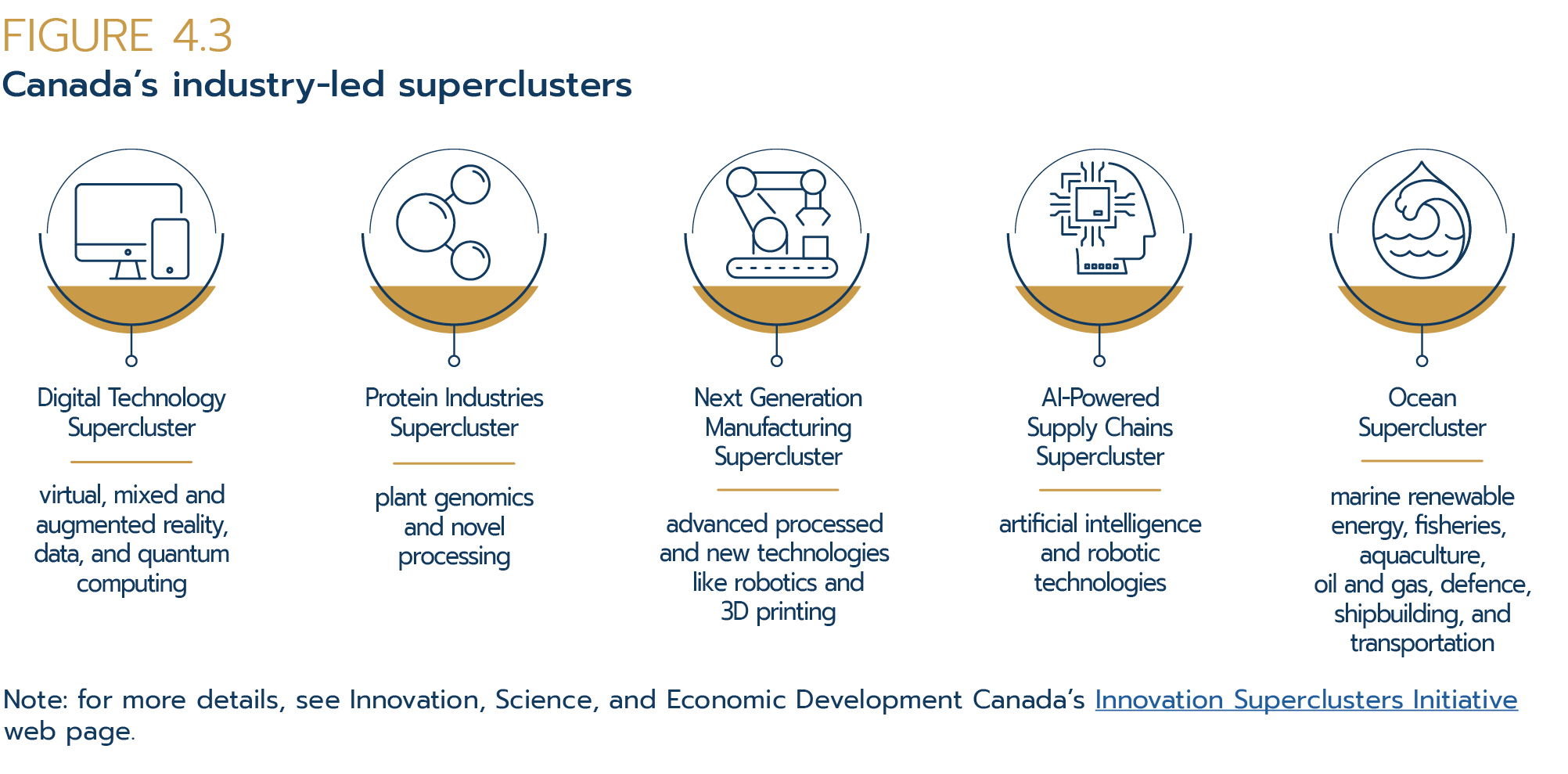
Text version
Figure 4.3: Canada's industry-led superclusters
Canada has five superclusters:
- The digital technology supercluster covering sectors such as virtual, mixed and augmented reality, data and quantum computing
- The protein industries supercluster encompassing industries such as plant genomics and novel processing
- The next generation manufacturing supercluster encompassing technologies such as advanced processes and new technologies like robotics and 3D printing
- The AI-powered supply chains supercluster including technologies such as artificial intelligence and robotic technologies
- The ocean supercluster capturing sectors such as marine renewable energy, fisheries, aquaculture, oil and gas, defence, shipbuilding, and transportation
Note: for more details, see Innovation, Science, and Economic Development Canada's Innovation Superclusters Initiative web page.
Extensive market access
Foreign investors are often interested in accessing new markets, and Canada provides easy and extensive market access. First, its proximity to the U.S. coupled with CUSMA gives Canada unparalleled access to one of the largest economies in the world. Indeed, four fifths of Canada's largest cities are within a 2-hour drive of the U.S. border. And to take advantage of this market, Canada has a streamlined trans-border system that sees over 10 million truck crossings annually.
In total, Canada has 15 FTAs—which include CUSMA, CETA, and CPTPP. Once the CPTPP is ratified by all partners (Brunei and Malaysia have not yet ratified), Canada's FTAs give foreign investors preferred access to 51 foreign markets with 1.5 billion consumers. This preferred market access represents trade worth nearly US$52 trillion. Overall, Canada's trade agreements cover over 60% of global GDP (Figure 4.4).
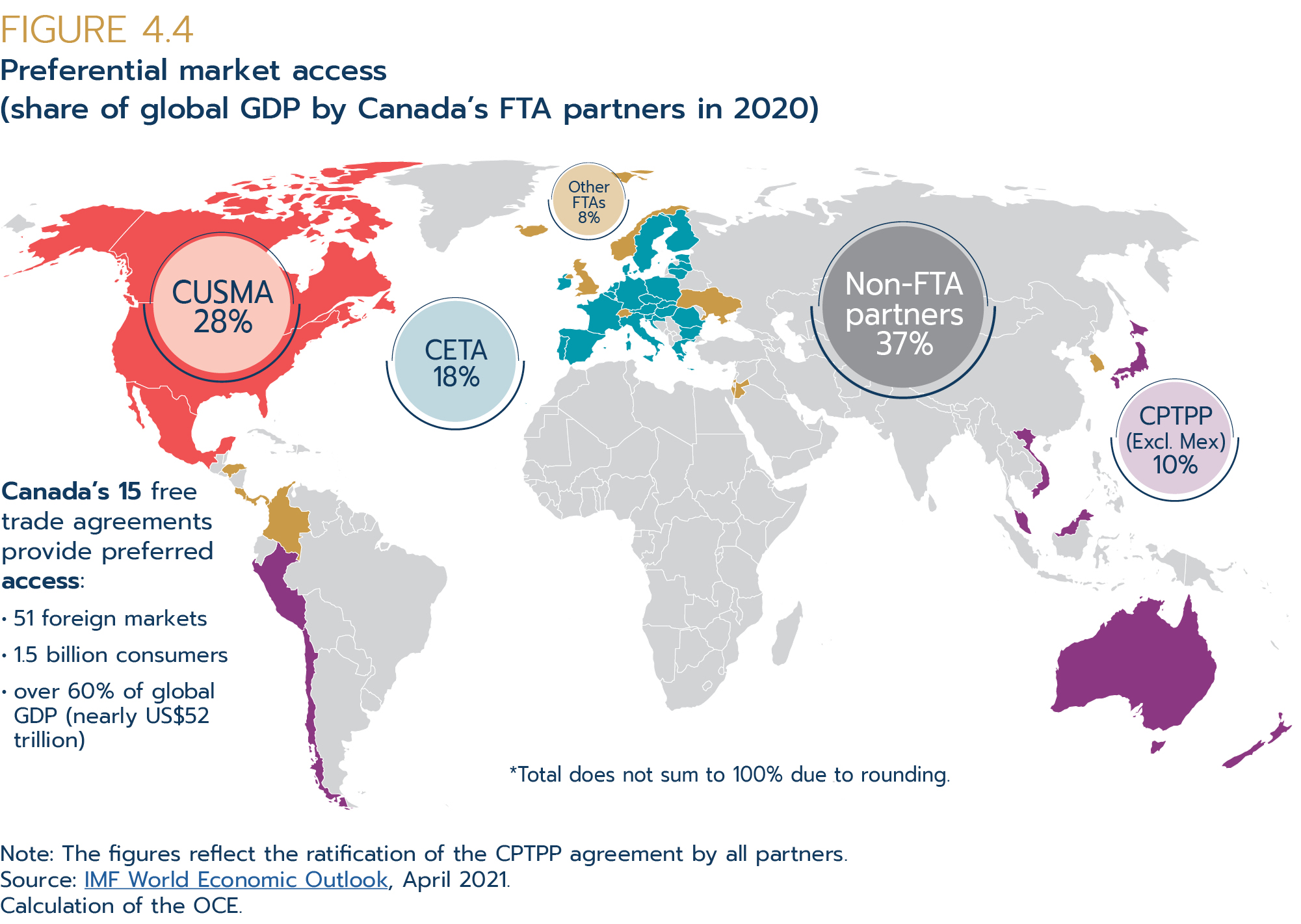
Text version
Figure 4.4: Preferential market access
(share of global GDP by Canada's FTA partners in 2020)
Canada has 15 free trade agreements giving important market access (as measured by GDP), including
- CUSMA: 28% of world GDP
- CETA: 18% of world GDP
- CPTPP (excluding Mexico): 10% of world GDP
- Other FTAs: 8% of world GDP
- Non-FTA partners: 37% of world GDP
Canada's 15 free trade agreements provide preferred access:
- 51 foreign markets
- 1.5 billion consumers
- Over 60% of global GDP (nearly US$52 trillion)
Note: The figures reflect the ratification of the CPTPP agreement by all partners.
Data source: IMF WEO, April 2021.
Calculation of the OCE.
High quality of life
While business considerations are top of mind for foreign investors, the quality of life in a given country is also important, particularly if attracting and retaining international talent is part of their investment strategy. Canada is recognized worldwide as a peaceful and democratic country with a high quality of life, ranking high globally on indices that rank peace and democracy (World Economic Forum Global Peace Index, EIU Democracy Index). Canada also has a strong overall reputation, ranking second among the G20 countries and seventh globally on an index that includes perceived trustworthiness, safety and several other attributes (RepTrak, 2018).
4.2 Promoting investment in Canada—the key players
Canada has much to offer to foreign investors, and providing this information to potential investors is an important part of investment promotion. Promoting and facilitating FDI involves making contact with potential investors, providing them with market information and information about the business environment in Canada, and putting them in contact with the right people to help their investment decision. A number of stakeholders contribute to FDI promotion and facilitation in Canada at the federal, provincial, territorial and municipal levels.
At the federal level, 5 government stakeholders are directly involved in FDI attraction activities:
- Global Affairs Canada's Trade Commissioner Service
- Invest in Canada
- Innovation, Science and Economic Development Canada
- Natural Resources Canada (NRCan)
- Agriculture and Agri-Food Canada (AAFC)
The TCS network comprises more than 1,000 trade professionals working in Canadian embassies, high commissions and consulates located in cities around the world and across Canada. Its core functions include the support of international business growth opportunities, trade (export) promotion and greenfield investment attraction, as well as investment expansion and retention. This includes policy development related to FDI attraction, expansion and retention, and negotiating trade agreements that directly align with and advance FDI commitments.
The TCS's global FDI network spans the Americas, Europe, and Asia and comprises 44 officers entirely dedicated to attracting FDI (Figure 4.5). These investment-dedicated officers are supported or complemented by senior trade commissioners, commercial counsellors, heads of mission, sector specialist trade commissioners who support the FDI function, and investment and trade sector specialists at headquarters in Ottawa. The TCS works across all sectors, facilitating FDI in Canada, while working closely with other agencies and departments. It plays a key role in managing relationships with global businesses and their headquarters and conducts market/sector intelligence and analysis as part of its FDI attraction efforts. In addition, the TCS contributes to the review of foreign investments under the ICA (See section 2.3). Other FDI-related activities the TCS carries out include lead generation and the delivery of promotional events.
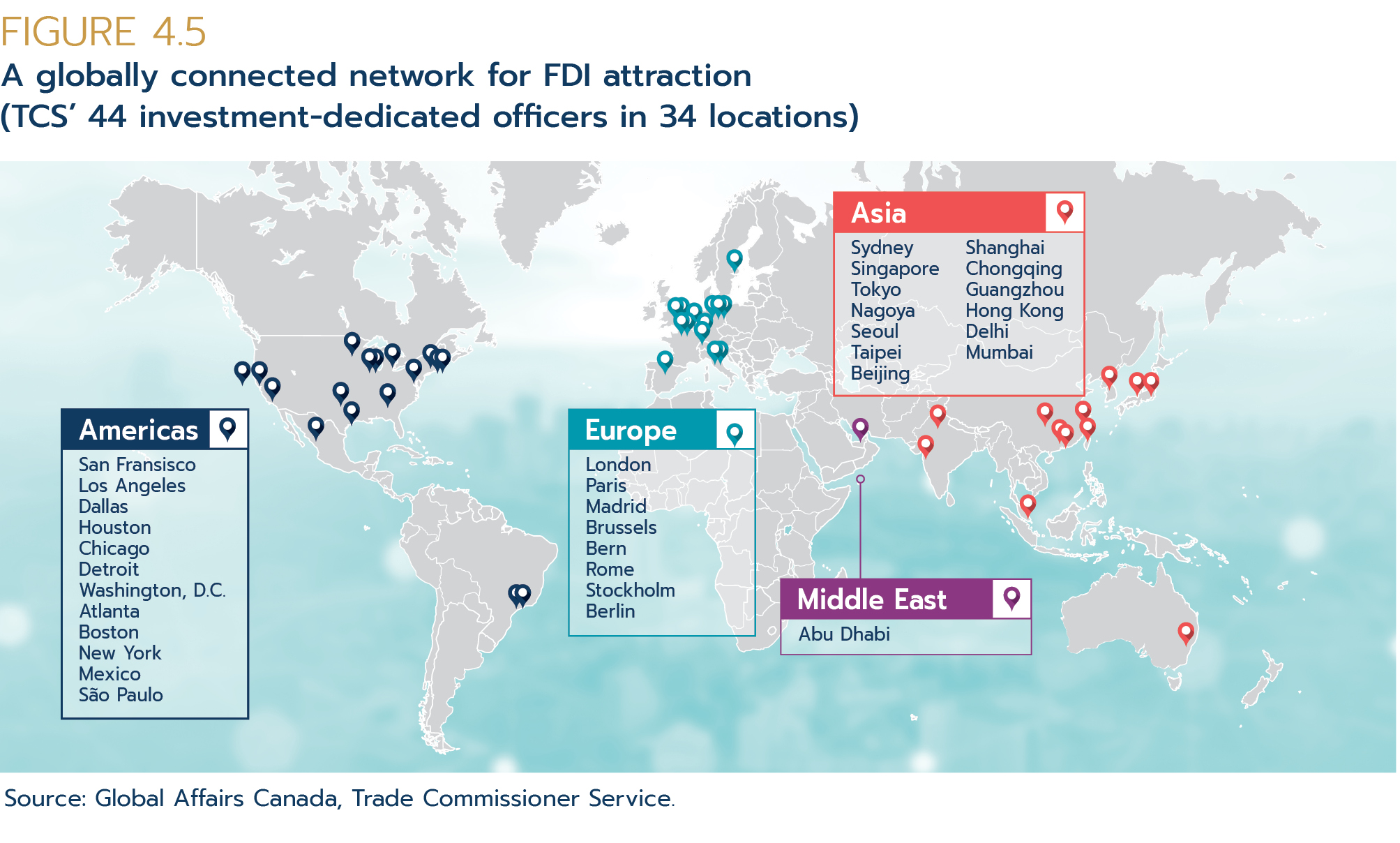
Text version
Figure 4.5: Globally connected: the TCS FDI network
Where in the world: 44 investment-dedicated TCS officers
Americas
- San Francisco
- Los Angeles
- Dallas
- Houston
- Chicago
- Detroit
- Washington, D.C.
- Atlanta
- Boston
- New York
- Mexico
- Sao Paulo
Europe
- London
- Paris
- Madrid
- Brussels
- Bern
- Rome
- Stockholm
- Berlin
Asia
- Sydney
- Singapore
- Tokyo
- Nagoya
- Seoul
- Taipei
- Beijing
- Shanghai
- Chongqing
- Guangzhou
- Hong Kong
- Delhi
- Mumbai
Middle East
- Abu Dhabi
Data source: Global Affairs Canada.
Box 4.1: Canada's investment attraction agency: Invest in Canada
Invest in Canada has been promoting, facilitating and accelerating FDI into Canada and helping position Canada as a premier investment destination since its inception in 2018. The organization's mission is to increase global investment in Canada that creates employment, boosts productivity, accesses new technologies, and encourages innovation.
Working closely with all levels of government, industry, and community partners, the agency promotes Canada's value propositions through creative and innovative marketing campaigns.
Invest in Canada:
- helps global companies fast-track their investment expansion decisions
- connects firms with the right people in the right places across the country
- works with investors to locate, establish and expand their operations
- supports partners by providing tools, data and services to support their investment attraction efforts
Since its creation in 2018, Invest in Canada has supported investments across sectors such as digital technology, life sciences, agri-food, advanced manufacturing and others. Invest in Canada is providing ongoing support to global companies on more than 150 potential investment projects and regularly refers incoming investment leads to partners across the country. Working with departments and agencies across government, Invest in Canada is coordinating complex and transformative investments that will create new jobs and opportunities for Canadians in sectors central to Canada's economic recovery from COVID-19.
Invest in Canada is the Government of Canada's investment attraction agency. It coordinates FDI-related efforts across government agencies and the private sector and provides investment support and proactive outreach (Box 4.1). The agency works to enhance Canada's prominence as a destination for global investment capital and helps others to better understand and leverage the benefits of FDI to Canada and to better coordinate the roles and responsibilities of federal government departments in the pursuit of FDI.
The other government departments directly involved in FDI are responsible for overseeing and promoting investment activities related to their specific mandates. These departments provide industry-specific expertise, including data and analyses and relationships/connections that facilitate FDI attraction. They also engage industry experts to participate in FDI promotion and outreach activities, provide guidance regarding regulations and approval processes and support other FDI-related requests for information or assistance.
In addition, some government stakeholders are not directly involved in the FDI life cycle but can indirectly influence and support FDI attraction or facilitate investment with some of their programming, such as providing information about work visas or port capacities. These include other federal departments as well as Crown corporations, such as the Business Development Bank of Canada (BDC) and EDC.
Provincial, territorial and municipal governments are also directly involved in attracting investment into Canada. At the provincial and territorial level there are a total of 13 investment promotion organizations or agencies:
- Trade and Invest BC
- Invest Alberta
- Saskatchewan Ministry of Trade and Export Development
- Manitoba Ministry of Economic Development and Jobs
- Invest Ontario
- Investissement Québec
- Newfoundland and Labrador Department of Industry, Energy and Technology
- Nova Scotia Business Inc.
- Opportunities New Brunswick
- Innovation PEI
- Yukon Department of Economic Development
- Northwest Territories Department of Industry, Tourism and Investment
- Nunavut Department of Economic Development and Transportation
Most Canadian cities have an economic development or investment promotion agency (IPA) that works in collaboration with the TCS, Invest in Canada, and their respective provincial/territorial IPAs to attract FDI into their communities. The Consider Canada City Alliance (CCCA) brings together investment and economic development agencies from 12 of Canada's largest cities:
- Vancouver Economic Commission
- Edmonton Global
- Calgary Economic Development
- Economic Development Winnipeg
- Invest in Hamilton
- London Economic Development Corporation
- Waterloo EDC
- Montréal International
- Toronto Global
- Invest Ottawa
- Québec International
- Halifax Partnership
Cities can get financial support from the federal CanExport Community Investments program for their FDI initiatives and activities. With this support they can improve their capacity to attract, retain and expand FDI.
Depending on the investment opportunity, 2 or more stakeholders may collaborate on the dialogue with a potential investor and on facilitating the investment, including the FDI-dedicated agent in the home country of the investor, an Invest in Canada investor service specialist, and a provincial and/or municipal representative (Box 4.2).
Box 4.2: Working together to facilitate a win—U.S. based Chime opens office in Vancouver
In November 2020, Chime, an online financial technology firm headquartered in San Francisco, opened its first international office in Vancouver, British Columbia. Chime provides fee-free banking products, including chequing accounts with no minimum balance and an automated savings feature.
Vancouver was an attractive investment location not only because it shares the same time zone as Chime's head office, but also thanks to its highly skilled workforce.
Chime's chief technical officer, Ryan King:
"That time zone alignment with Vancouver coupled with the quality and calibre of talent was able to attract us there."
The new Vancouver office houses Chime's engineering team of approximately 20 employees. By the end of 2021, Chime hopes to scale up to 100 staff and house several related departments, such as product management.
This win showcases the collaboration that occurs among all levels of government in facilitating wins. The Vancouver Economic Commission, Trade and Invest BC, Invest in Canada, and the TCS all partnered together to facilitate this investment. They provided the information the company needed to make a decision as well as pointed them to the right experts to answer specific questions related to tax credits or programs that apply to their industry.
4.3 Metrics for success: evaluating FDI attraction
The global competition for FDI is strong. Various performance indicators are used to assess how Canada is doing at attracting FDI. Monitoring performance on key measures gives a sense of how the TCS is doing with respect to engaging stakeholders and securing deals. Benchmarking performance relative to other economies presents a snapshot of how Canada is faring in a global context.
TCS performance indicators
Interacting directly with senior executives of key international companies is among the TCS's major activities aimed at proactively engaging with stakeholders and generating potential FDI leads. The TCS focuses mainly on dynamic firms that demonstrate a high propensity to invest in sectors where Canada has clear competitive advantages and where proactive promotion will make a difference. The TCS provides frontline relationship management with global firms and provides coordination with partners in delivering key messages to these companies, as well as informing potential investors about the existing opportunities in Canada.
The TCS monitors and measures its success at promoting and attracting FDI using various key performance indicators (KPIs). These KPIs help evaluate whether efforts in attracting more FDI into Canada have been successful. Key indicators that the TCS monitors include: the number of FDI site selection visits (i.e. investor visits that could lead to FDI) and the number of wins (i.e. new investment deals).
When a company identifies Canada as a potential investment location the TCS works with the company and liaises with partners in Canada to arrange FDI site selection visits. The number of FDI site selection visits continued to trend upward between 2016 and 2019, totaling 990 visits between 2016 and 2020. The number of visits fell by half in 2020: from almost 250 visits in 2019 (Figure 4.6) to under 125 in 2020, an expected outcome given the travel restrictions due to COVID-19.
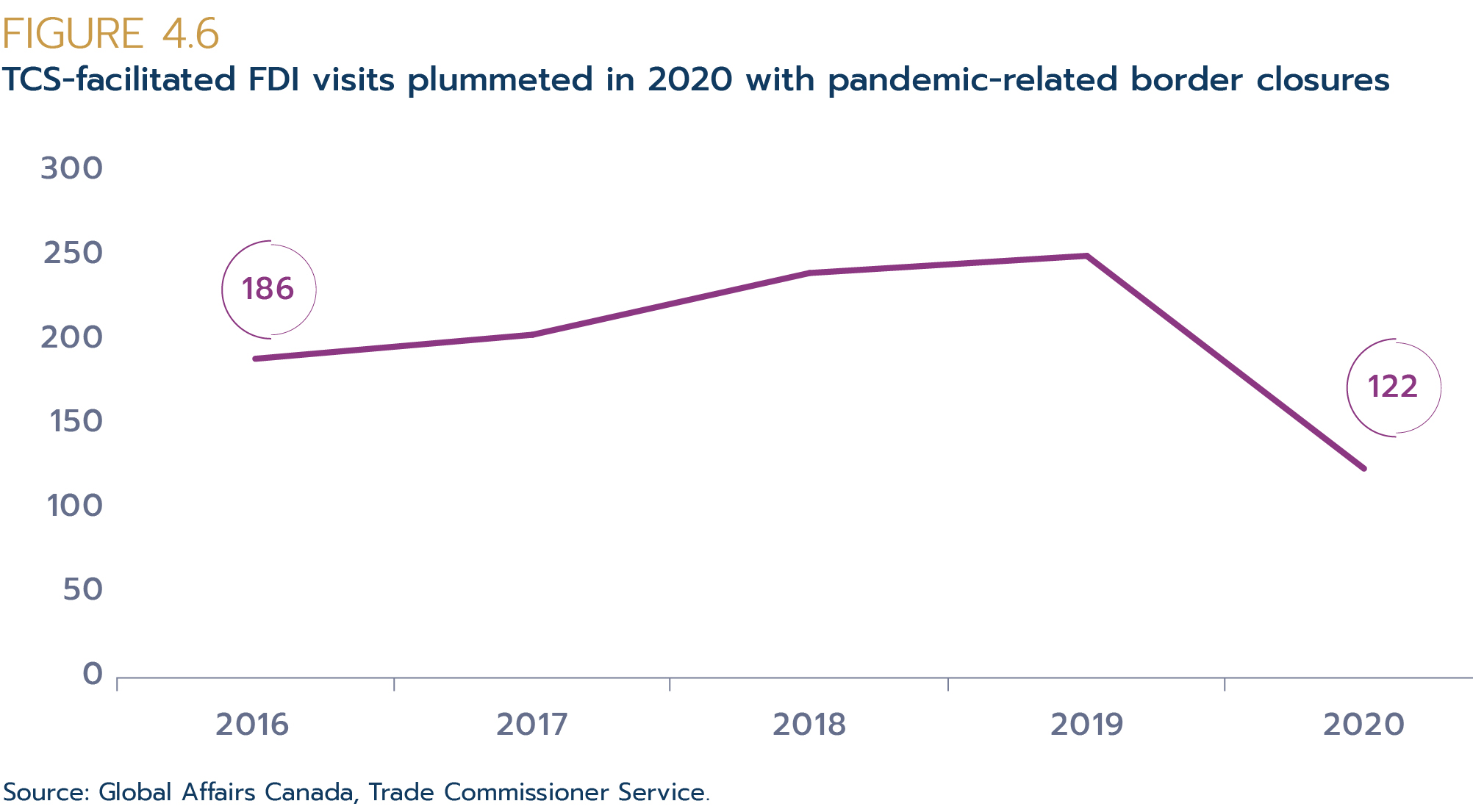
Text version
Figure 4.6: TCS-facilitated FDI visits plummeted in 2020 with pandemic-related border closures
| FDI Visits | |
|---|---|
| 2016 | 186 |
| 2017 | 200 |
| 2018 | 236 |
| 2019 | 246 |
| 2020 | 122 |
Data source: Global Affairs Canada, Trade Commissioner Service.
The U.S. is Canada's dominant source of FDI stock so it's not surprising that over one quarter of the visits in the past 5 years have been from U.S. investors (Figure 4.7). Investors from the U.K. and India made up one fifth of the total. From a regional perspective, European investors made up the largest share of visits over the period, just ahead of investors from the Americas. About one quarter of FDI visits were made by investors from Asia.
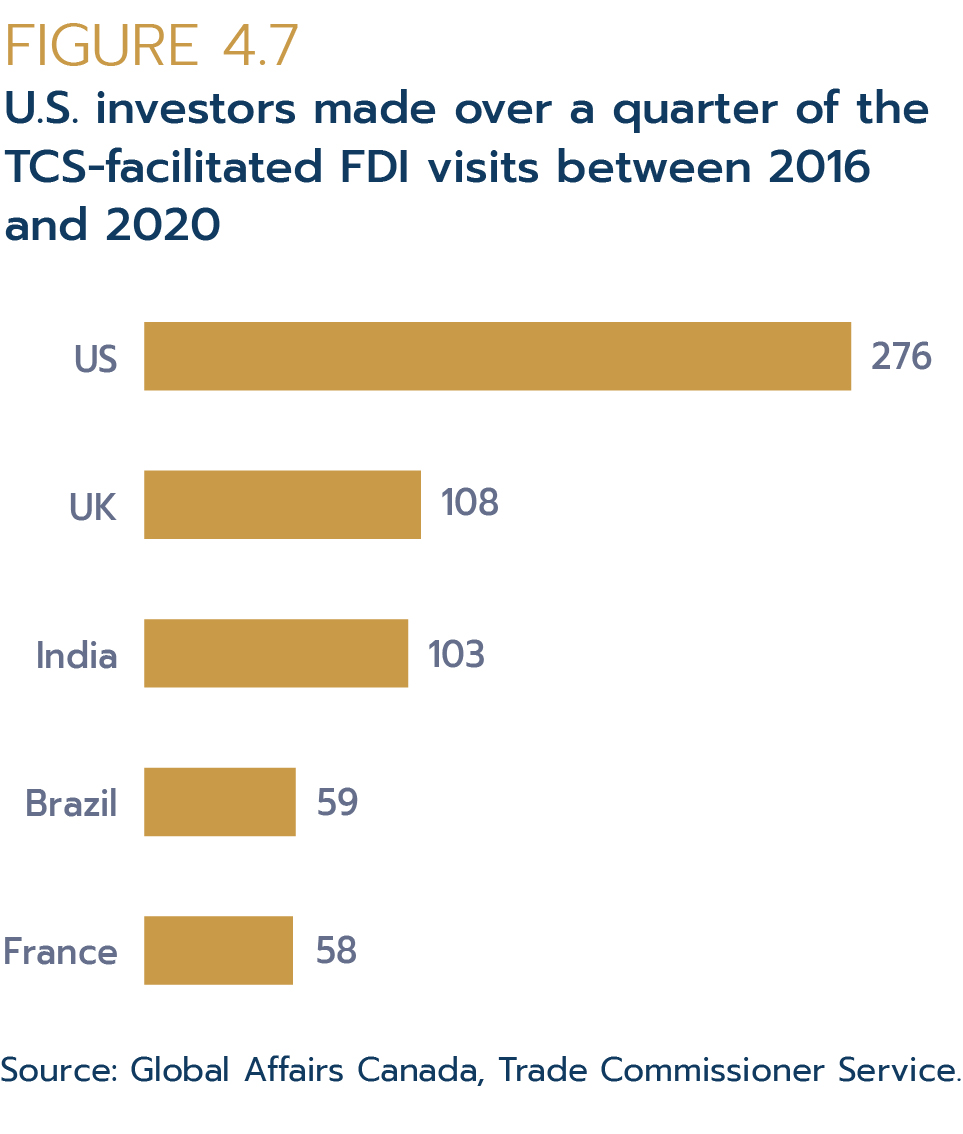
Text version
Figure 4.7: U.S. investors made over a quarter of the TCS-facilitated FDI visits between 2016 and 2020
| FDI Visits 2016 to 2020 | ||
|---|---|---|
| US | 276 | 28% |
| UK | 108 | 11% |
| India | 103 | 10% |
| Brazil | 59 | 6% |
| France | 58 | 5.9% |
Source: Global Affairs Canada, Trade Commissioner Service.
Most FDI visits are from investors in the information and communication technologies (ICT) industry. In the past 5 years, the industry accounted for 405 visits, over 40% of the total (Figure 4.8). Coming in a distant second were visits from investors in the agriculture and processed foods; financial and insurance services; life sciences; and infrastructure/buildings products and services industries. Each of these 4 sectors accounted for about 6% of FDI visits.
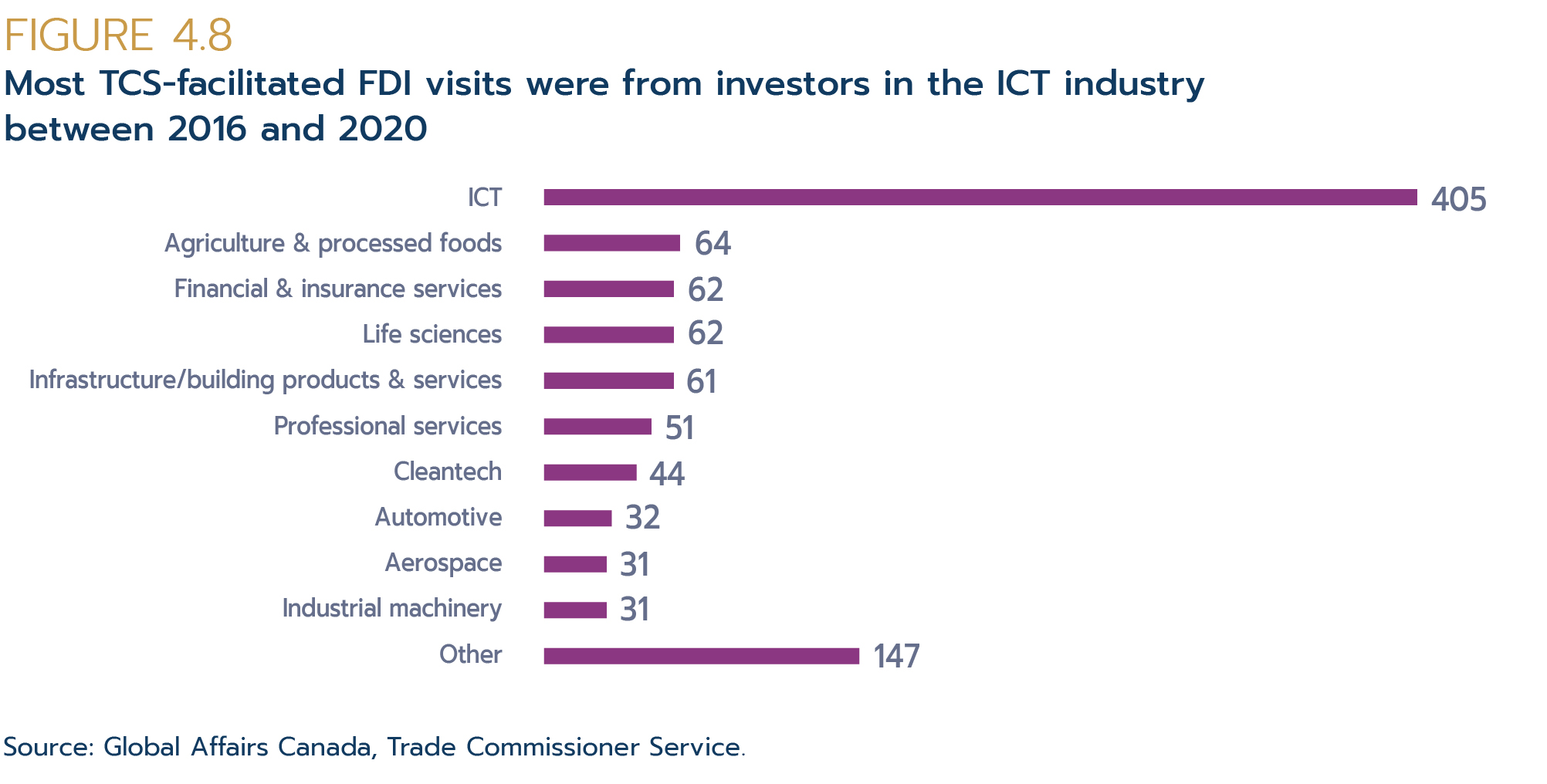
Text version
Figure 4.8: Most TCS-facilitated FDI visits were from investors in the ICT industry between 2016 and 2020
| Industry | FDI Visits, 2016-2020 |
|---|---|
| ICT | 405 |
| Agriculture & processed foods | 64 |
| Life sciences | 62 |
| Financial & insurance services | 62 |
| Infrastructure/building products & services | 61 |
| Professional services | 51 |
| Cleantech | 44 |
| Automotive | 32 |
| Industrial machinery | 31 |
| Aerospace | 31 |
| Other | 147 |
Data source: Global Affairs Canada, Trade Commissioner Service.
With its engagement efforts and successes at attracting FDI visits, how does the TCS fare at securing the deal? The TCS monitors "FDI wins" that it was instrumental in facilitating. An FDI win is a greenfield investment or expansion of an existing foreign investment in Canada that contributes to Canadian economic prosperity. FDI wins are often joint efforts that involve partners at the federal, provincial, and municipal levels (Box 4.3).
Over the past 5 years, the TCS recorded 628 FDI wins, which contributed $50 billion and over 31,000 jobs to the economy (Figure 4.9). It is important to keep in mind that the employment numbers might understate the full contribution of such FDI given that not all investors disclose the expected number of created jobs. Close to one third of these wins comprises FDI from U.S. investors, while investment from the U.K. accounted for 13% of the total. France, India and Germany round out the top 5 investor countries over the period.
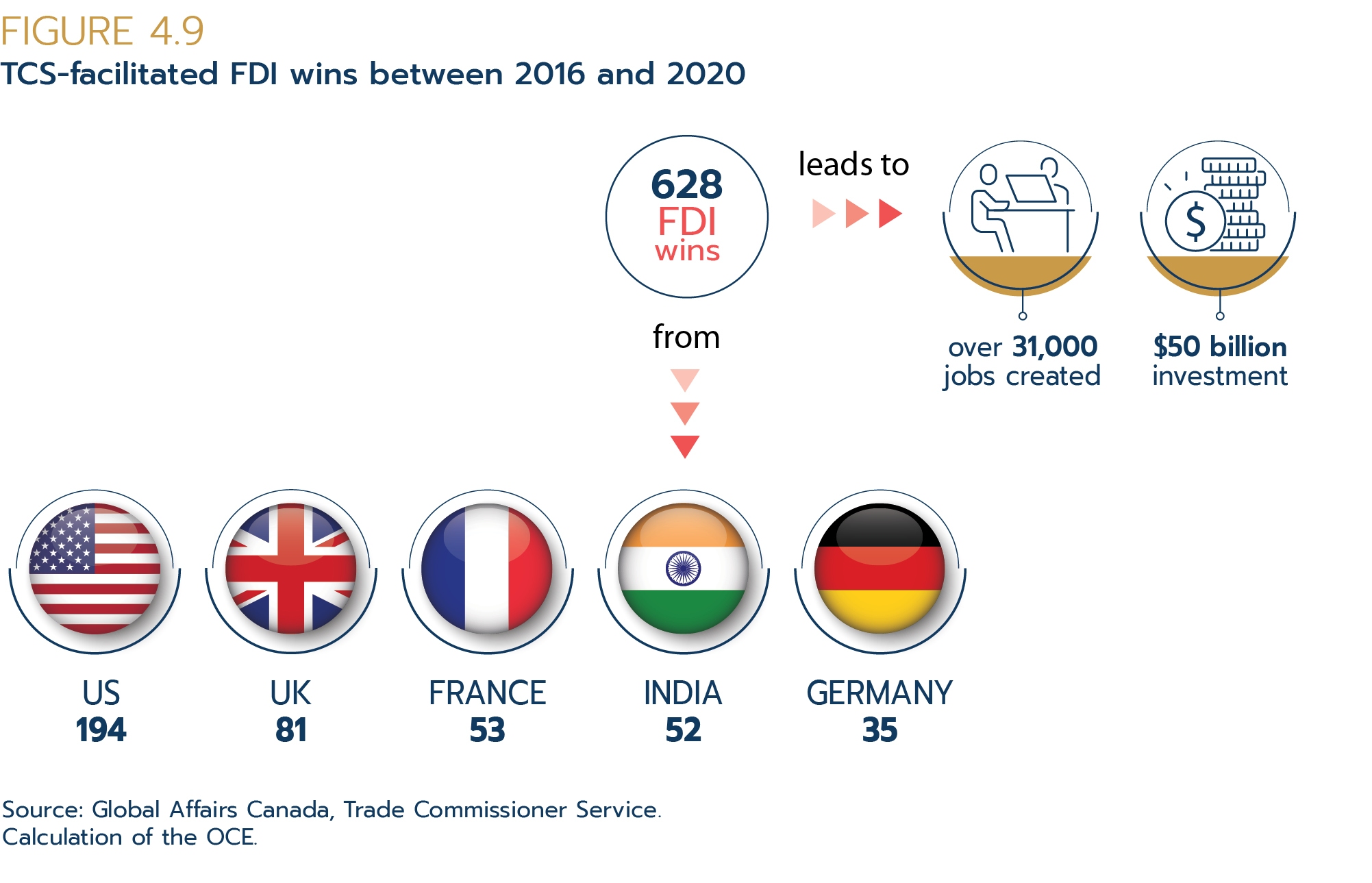
Text version
Figure 4.9: Snapshot: TCS-facilitated FDI wins 2016-2020
628 FDI wins including 194 in the USA, 81 in the United Kingdom, 53 in France, 52 in India and 35 in Germany. These 628 FDI wins lead to over 31,000 jobs created and $50 billion in investment
Data source: Global Affairs Canada, Trade Commissioner Service.
Calculation of the OCE.
Between 2016 and 2020, over 40% of the FDI wins were investments made by ICT companies. Investments in the agricultural and processed foods, professional services, industrial machinery, and life sciences industries together made up over a quarter of the TCS-facilitated FDI wins. It is worth noting that the share of FDI wins for a given industry is not proportional to the share in total value contributed by that industry. Over the same 5 years, the oil and gas industry contributed over $40 billion, or four fifths of the total dollar value of the FDI wins, while the ICT industry was only responsible for 4%. A single win in the oil and gas industry—in this case the $40-billion liquefied natural gas investment in British Columbia in 2019 by 5 foreign companies—can have a huge impact on FDI dollar figures in a given year. Overall, the oil and gas industry accounted for 10 of the 628 FDI wins, or 2%, between 2016 and 2020 (data from Global Affairs Canada, Trade Commissioner Service).
Benchmarking global performance—where Canada stands
The efforts of many in Canada have led to a sizeable number of investments over the years, and the sum of these investments and subsequent re-investment decisions by foreign investors make up Canada's FDI stock as it stands now (see Chapter 2). To understand how successful Canada has been at attracting FDI requires comparing its FDI performance to that of other countries. The stock of FDI in a region as a share of its GDP tells us how much FDI a country has relative to the size of its economy.
In 2019, Canada's FDI stock as a share of GDP was 60%. Compared to other G7 economies, Canada fares well, ranking second after the United Kingdom (74%) and well above the G7 average (38%) (Figure 4.10). However, relative to the 37 OECD countries, Canada ranks 14th. The top-ranking OECD countries are Ireland, the Netherlands and Switzerland. The top 5 countries all have shares greater than 100%—i.e. the FDI stock in these countries is greater than each of their respective GDPs. These data capture the immediate destination of FDI, i.e. the country where FDI entered, and do not offer insight on the FDI's ultimate destination. In fact, an investment that is transiting through an intermediary country is counted twice in these statistics since it entered 2 countries: the intermediary country and the ultimate destination country. International efforts to improve FDI statistics are under way by the IMF and the OECD. Statistics Canada is participating in these efforts.
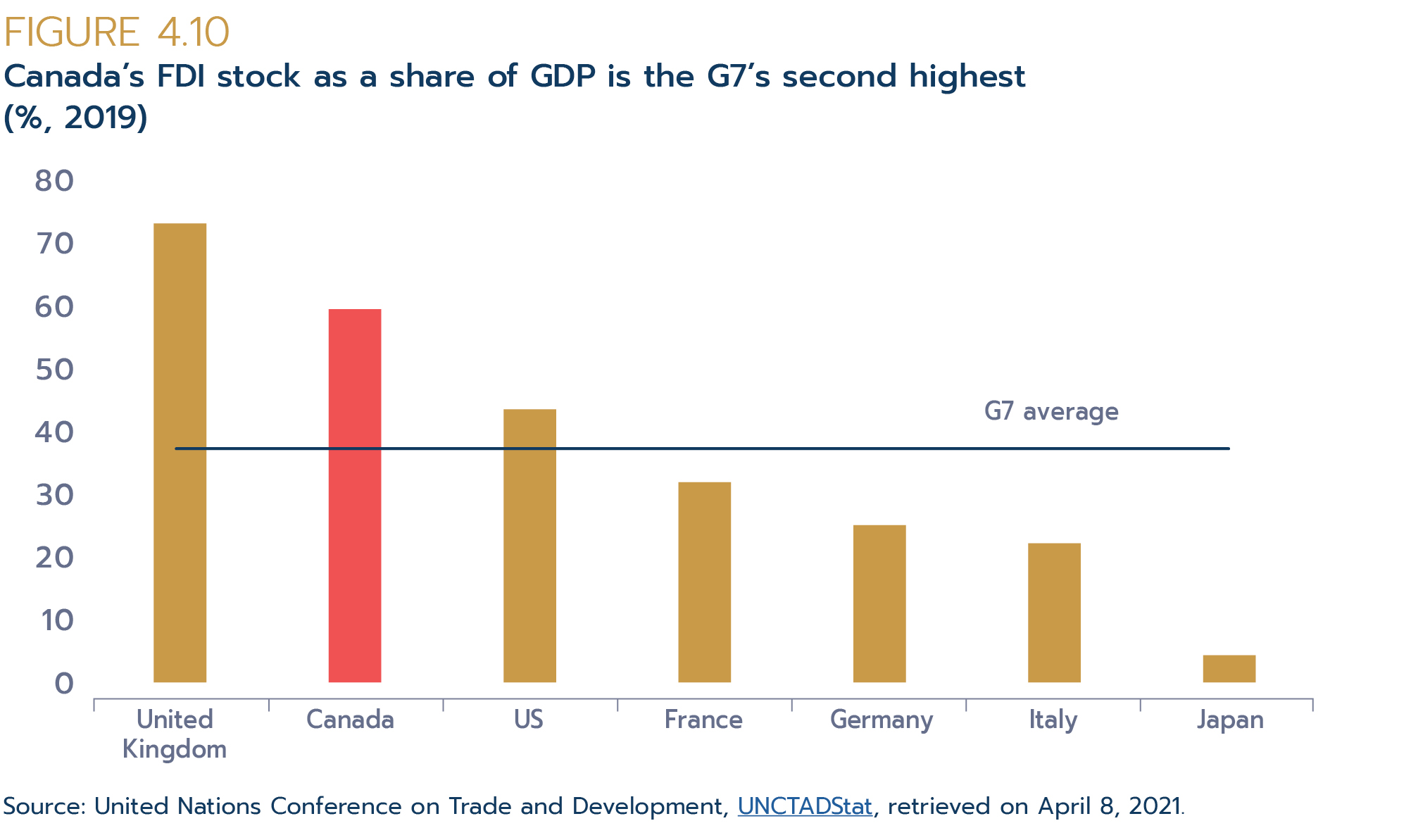
Text version
Figure 4.10 Canada's FDI stock as a share of GDP is the G7's second highest
(%, 2019)
FDI stock as share of GDP - G7 average is 38
| Country | |
|---|---|
| United Kingdom | 74 |
| Canada | 60 |
| United States | 44 |
| France | 32 |
| Germany | 25 |
| Italy | 22 |
| Japan | 4.4 |
Source: United Nations Conference on Trade and Development, UNCTADStat, retrieved April 8, 2021.
Another measure of how Canada fares globally is its relative performance at securing new FDI projects. Canada's share of world greenfield and expansion projects has remained constant, hovering around 2% for the past 10 years (Table 4.1). The TCS has been involved with, on average, 38% of all known FDI projects in Canada each year.
Table 4.1: Canada's share of global greenfield and expansion FDI projects has remained constant over the last decade
| Year | Total FDI projects globally | Total FDI projects in Canada | Canada's share |
|---|---|---|---|
| 2020 | 12,909 | 318 | 2.46% |
| 2019 | 19,643 | 404 | 2.06% |
| 2018 | 19,950 | 409 | 2.05% |
| 2017 | 16,808 | 319 | 1.90% |
| 2016 | 15,935 | 308 | 1.93% |
| 2015 | 15,620 | 317 | 2.03% |
| 2014 | 15,997 | 455 | 2.84% |
| 2013 | 16,791 | 334 | 1.99% |
| 2012 | 15,735 | 333 | 2.12% |
| 2011 | 16,970 | 346 | 2.04% |
Data source: fDi Markets, retrieved April 8, 2021.
Calculation of the TCS.
To attract FDI, it's important to maintain the confidence of global investors. Measuring this confidence indicates Canada's attractiveness as an investment destination. Kearney's forward-looking FDI Confidence Index ranks 25 countries based on their likelihood to attract investment in the next 3 years. The 25 countries included in the analysis accounted for more than 95% of global FDI flows in recent years.
The index is based on responses from an annual survey of senior executives from the world's leading corporations that span all sectors. The index values are calculated as a weighted average of the number of responses indicating high, medium, and low likelihood of making a direct investment in each of the markets (Kearney, 2021). The higher a country's index value, the more attractive it is perceived as an investment target.
Canada ranks second, after the United States, among the 25 countries on the 2021 FDI Confidence Index, maintaining its ranking from the previous year. Within the G7, 3 other countries place among the top 5: Germany, the U.K. and Japan (Figure 4.11).
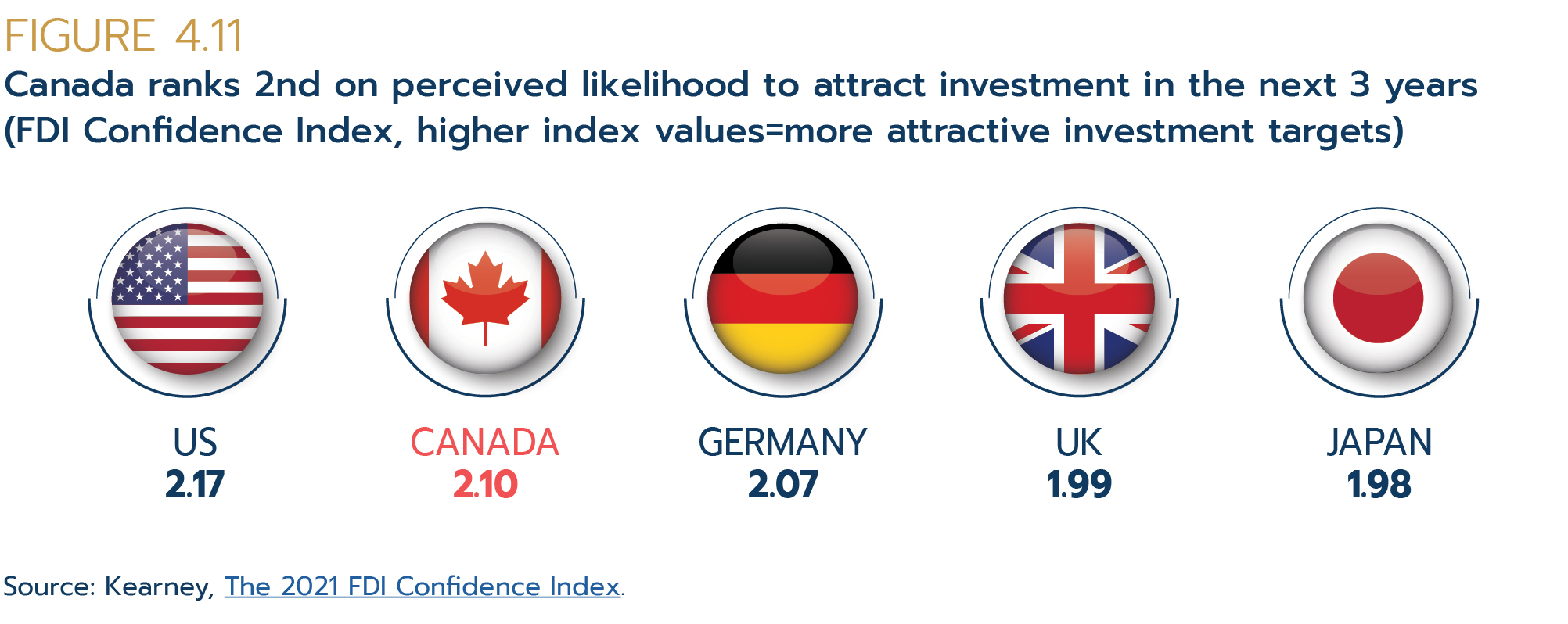
Text version
Figure 4.11: Canada ranks 2nd on perceived likelihood to attract investment in the next 3 years
(FDI Confidence Index, higher index values=more attractive investment targets)
| Country | Rank | |
|---|---|---|
| 1 | United States | 2.17 |
| 2 | Canada | 2.10 |
| 3 | Germany | 2.07 |
| 4 | United Kingdom | 1.99 |
| 5 | Japan | 1.98 |
Data source: Kearney, The 2021 FDI Confidence Index.
Take-home messages
- Key factors that make Canada an attractive place to invest:
- strong, stable and resilient economy
- welcoming business environment
- highly educated, skilled and diverse labour force
- well-developed innovation ecosystem
- extensive access to international markets
- high quality of life
- Over the past 5 years, the TCS recorded 628 FDI wins, which contributed $50 billion and over 31,000 jobs to the economy.
- At 60%, Canada has the second-highest FDI stock as a share of GDP among the G7 countries.
- Canada's share of global greenfield and expansion FDI projects has remained constant over the past 10 years at 2%.
Bibliography
Antràs, Pol and Stephen R. Yeaple. "Multinational Firms and the Structure of International Trade," Handbook of International Economics, Volume 4, pp. 55-130, Elsevier B.V (2014).
https://www.sciencedirect.com/science/article/pii/B9780444543141000021
Baldwin, James R. and Wulang Gu. "Global Links: Multinationals, Foreign Ownership and Productivity Growth in Canadian Manufacturing," Canadian Economy in Transition Series, Statistics Canada (2005).
https://www150.statcan.gc.ca/n1/en/pub/11-622-m/11-622-m2005009-eng.pdf?st=w-nrrvkv
Blanchet, Nancy. "Immigrant-led SME Exporters in Canada," Global Affairs Canada, Office of the Chief Economist (2021).
Breau, Sébastien and W. Mark Brown. "Global Links: Exporting, Foreign Direct Investment, and Wages: Evidence from the Canadian Manufacturing Sector," Statistics Canada (2011). https://www150.statcan.gc.ca/n1/en/pub/11-622-m/11-622-m2011021-eng.pdf?st=0g1ArjgF
Caves, Richard E. "Multinational Enterprise and Economic Analysis," 3rd edition, Cambridge University Press (2007).
Chen, Maggie Xiaoyang and Michael O. Moore. "Location decision of heterogeneous multinational firms," Journal of International Economics, vol. 80(2), pp. 188-199 (2010).
https://www.sciencedirect.com/science/article/abs/pii/S0022199609001056
Criscuolo, Chiara and Ralf Martin. "Multinationals and U.S. Productivity Leadership: Evidence from Great Britain," The Review of Economics and Statistics, MIT Press, vol. 91(2), pp. 263-281 (2009).
https://ideas.repec.org/a/tpr/restat/v91y2009i2p263-281.html
Damgaard, Jannick and Thomas Elkjaer, Niels Johannesen. "What is Real and What is Not in the Global FDI Network?", IMF Working Paper No. 19/274 (2019).
Dunning, John H. "Explaining Changing Patterns of International Production: in Defense of the Eclectic Theory," Oxford Bulletin of Economics and Statistics (1979).
Dunning, John H. and Sarianna M. Lundan. "Multinational Enterprises and the Global Economy, Second Edition," Edward Elgar Publishing Limited (2008).
Hejazi, Walid. "Dispelling Canadian Myths About Foreign Direct Investment," Institute for Research on Public Policy (2010).
Helpman, Elhanan and Marc J. Melitz, Stephen R. Yeaple. "Export versus FDI with heterogeneous firms," The American Economic Review, vol. 94(1), pp. 300–316 (2004).
https://www.aeaweb.org/articles?id=10.1257/000282804322970814
Hines, James R. Jr. and Mihir A. Desai, C.F. Foley. "Domestic Effects of the Foreign Activities of U.S. Multinationals," American Economic Journal: Economic Policy 1, no. 1, pp. 181-203, University of Michigan Law School (2009).
https://repository.law.umich.edu/articles/1453/
Hottman, Colin and Stephen J. Redding, David E. Weinstein. "Quantifying the Sources of Firm Heterogeneity," The Quarterly Journal of Economics, vol. 131(3), pp. 1291–1364 (2016). https://academic.oup.com/qje/article/131/3/1291/2461153
International Monetary Fund. "D.1 Greenfield Investment and Extension of Capital," Draft Guidance Note, Direct Investment Task Team, International Monetary Fund (2021).
https://www.imf.org/en/Data/Statistics/BPM/DITT
Kearney. "2021 Kearney Foreign Direct Investment Confidence Index" (2021).
https://www.kearney.com/foreign-direct-investment-confidence-index/2021-full-report
MacNaughton, Zachary. "Explaining the Volatility of FDI Flows," Global Affairs Canada, Office of the Chief Economist (2021).
http://wiki/images/a/a2/Explaining_the_Volatility_of_FDI_Flows.pdf
McKern, Bruce. "Transnational Corporations and the Exploitation of Natural Resources," UN Library on Transnational Corporations, Vol. 10, Routledge (1993).
Organisation for Economic Co-operation and Development. "Foreign Direct Investment for Development, Maximising Benefits, Minimising Costs," (2002).
https://www.oecd.org/investment/investmentfordevelopment/1959815.pdf
IBID. "OECD Benchmark Definition of Foreign Direct Investment, Fourth Edition 2008," Organisation for Economic Co-operation and Development (2008).
https://www.oecd.org/daf/inv/investmentstatisticsandanalysis/40193734.pdf
IBID. "OECD Economic Surveys: Canada 2021," OECD Publications (2021).
IBID. "OECD Indicators of Talent Attractiveness 2021," Organisation for Economic Co-operation and Development (2021).
https://www.oecd.org/migration/talent-attractiveness/
Poloz, Stephen S. "Financial Intermediation Under the New Trade Paradigm: EDC and Integrative Trade," Export Development Canada (2012).
Quacquarelli Symonds. "QS World University Rankings 2021," QS Quacquerelli Symonds Limited (2021).
Rai, Naveen and Lena Suchanek and Maria Bernier. "Does Outward Foreign Investment Matter for Canadian Productivity? Evidence from Greenfield Investments," Working Paper, Bank of Canada (2018).
https://www.bankofcanada.ca/2018/07/staff-working-paper-2018-31/
Rao, Someshwar and Jianmin Tang. "Foreign Ownership and Total Factor Productivity," in Lorraine Eden and Wendy Dobson (ed.), Governance, Multinationals and Growth, Edward Elgar Publishing (2005).
Rao, Someshwar and Qi Zhing. "Macro-Economic Impacts of Inward and Outward FDI in Canada," Transnational Corporations Review, vol. 11(1), pp. 80-96, Taylor & Francis Journals, (2018).
Reputation Institute. "The World's Most Reputable Countries," 2018 Country RepTrak® (2018). https://cdn2.hubspot.net/hubfs/2963875/_PDF/RepTrak/2018_Country_RepTrak_180621.pdf
Sekkel, Julia. "Characteristics of SME Exporters in Canada," Global Affairs Canada, Office of the Chief Economist (2021).
Souare, Malick and Boxi Zhou. "Foreign-affiliate presence and skilled labour demand," International Economics and Economics Policy 13, pp.233–254, Springer-Verlag (2016). https://link.springer.com/article/10.1007%2Fs10368-014-0302-y#citeas
Tang, Jianmin and Weimin Wang. "Why Are Multinationals More Productive than Non-multinationals? Evidence from Canada," Statistics Canada (2020).
https://www150.statcan.gc.ca/n1/pub/11f0019m/11f0019m2020008-eng.htm
United Nations Conference on Trade and Development. "World Investment Report 2020," United Nations Publications (2020). https://unctad.org/webflyer/world-investment-report-2020
UNCTAD. "World Investment Report 2019," United Nations Publications (2019). https://unctad.org/system/files/official-document/wir2019_en.pdf
Wang, Yanling and Wulong Gu. "FDI, Absorptive Capacity, and Productivity Growth: The Role of Inter-Industry Linkages," Carleton University and Statistics Canada (2006).
https://papers.ssrn.com/sol3/papers.cfm?abstract_id=924771
World Trade Organization. "Trade set to plunge as COVID-19 pandemic upends global economy," [Press release] World Trade Organization (2020a). https://www.wto.org/english/news_e/pres20_e/pr855_e.htm
IBID. "Trade shows signs of rebound from COVID-19, recovery still uncertain," [Press release] World Trade Organization (2020b). https://www.wto.org/english/news_e/pres20_e/pr862_e.htm
IBID. "World trade primed for strong but uneven recovery after COVID-19 pandemic shock," [Press release] World Trade Organization (2021). https://www.wto.org/english/news_e/pres21_e/pr876_e.htm
Data sources
The sources for the data and statistics in section 4.1 are provided here in the order in which they appear in the text. Many of these statistics are also included in the Office of the Chief Economist's "Think Canada!" document, which is available upon request.
Strong, stable and resilient economy
GDP growth:
International Monetary Fund. "World Economic Outlook, April 2021," IMF Publications (2021).
Canada's net debt:
International Monetary Fund. "Fiscal Monitor April 2021," IMF Publications (2021).
COVID-19 job recovery :
Calculations by the OCE based on Statistics Canada tables 14-10-0287-01 and 14-10-0288-01.
Welcoming business environment
Doing business rankings:
Ease of starting a business:
World Bank. "Ease of doing business rankings," The World Bank Group (2020).
Entrepreneurship ecosystem:
Knoema. "Global Entrepreneurship Index," World Data Atlas (2020).
Attractiveness to potential entrepreneur migrants:
OECD. "OECD Indicators of Talent Attractiveness," OECD (2019).
Highly educated, skilled and diverse labour force
Share of working age adults with a post-secondary degree:
OECD. "Educational attainment of 25-64 year olds (2019)," Education at a Glance (2020).
University rankings:
Quacquarelli Symonds. "QS World University Rankings 2021," QS Quacquerelli Symonds Limited (2021).
Mother tongue languages:
Statistics Canada. 2016 Census.
International students:
Calculation by the OCE based on Statistics Canada table 37-10-0086-01.
Highly educated workers:
OECD. "OECD Indicators of Talent Attractiveness," OECD (2021).
Managerial talent:
Extensive market access
Truck crossings:
Calculations by the OCE based on Statistics Canada tables 24-10-0002-01 and 23-10-0253-01.
High quality of life
Recognition as peaceful country:
Institute for Economics & Peace. "Global Peace Index 2020," World Economic Forum (2020).
Recognition as democratic country:
The Economist Intelligence Unit. "Democracy Index 2020," The Economist Newspaper Limited (2021).
Canada's reputation:
Reputation Institute. "The World's Most Reputable Countries," 2018 Country RepTrak® (2018).
- Date modified: